ADAM ROWE
20 year old writer and filmmaker. Check out the content below if you fancy.
FILM REVIEWS
THE SADOMASOCHISTIC ANGEL
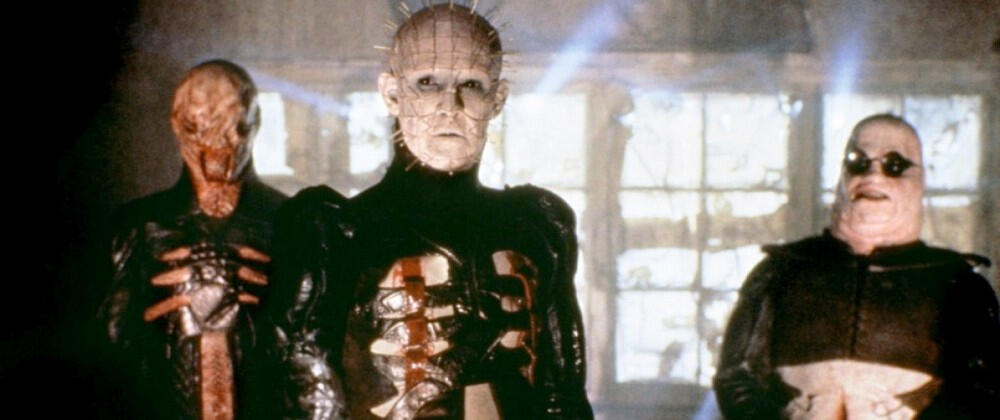
9 sequels, one classic. This legendary horror franchise is a tough one to conquer, but I’ll get there some day.(Most) horror movies have a reputation as being social commentaries on underage sex, drugs, or any other reproductive immoral activity generally aimed at teenagers or young adults. The ethical conundrum of pre-marital sex is spotlighted (unintentionally) in Halloween, the issue of sexually transmitted disease perfectly used as the core source of fear in It Follows, the grotesque image of Jeff Goldblums creature in The Fly during the raise of the aids crisis in the 80's... there are many examples. This film seems to be a lot more 'on the nose' with its moral bombardment of a personal social commentary about pleasure and the unadulterated desire for sin, or worser yet the reverberations of lustful existentialism dramatized with the fearful and iconic images of the cenobites - and most famously with the intimidating and fearful Pinhead beautifully portrayed by Doug Bradley. So you can only expect that this film will not only be a creepy flick, but a conversation about temptation and problem of desiring pleasure. The movie depicts a once troubled and now settled Mum who moves into her old house. She remembers her affair with a man she loved so dearly and begins to lust for it. Her duality only expands when a drop of her husband's blood resurrects her past lover who previously gave his life to the cenobites. As the character of the Mum becomes more and more tempted by pure evil in her ex lover, the narrative shifts entirely to her daughter, who accidentally summons the cenobites in one of the scariest scenes of the movie, and tries anything to survive. The film takes its time in pacing, getting to know and love the characters as well as build a connection with their stories. We see a descent into madness as well as a preservation of will in different people, all heightened to questioning when the temptingly hungry cenobited come to play, and, once again, endless pleasures, one way or another, is what’s on the table.The ghastly ghouls seem to have a lifestyle of unimaginable pain and suffering, and, in turn, they've developed an aesthetic for themselves. Having been torn from limb to limb, inside out, with nerves and muscles replaced by chains and piercings of immeasurable agony; but it's not the look of them that is the scary part, it's the tease of a hell bound inevitability that is most frightening of all. That's where this film is uniquely petrifying. If you look at the old Universal horror movies, they're not scary like 80's films of the time where; and now, looking back, modern viewers see neither eras as frightening! Films like Frankenstein (1931) especially had the awfully threatening concept of bringing the dad back to life. It was a very 'of it's time' scary movie as, in the heat of everyone being afraid of science and seeing it as a threat to humanity, here comes this movie posing big big questions about man playing god (in fact upon initial release the line “now I know what it’s like to be God” was removed from the cut). What I’m getting at is it’s a concept that is scary, not Frankenstein himself despite his intimidating creepy looks. Now, the idea of resurrection is in every Halloween special of kid’s TV programmes and featured in countless horror comedies. In the 80’s they tried to invent their own source of fear now that the idea of being scared by an idea was gone. So welcome to the rise of great practical effects. Pioneers like Rob Bottin, Mark Shostrum, Rik Baker and Tom Svaini made it impossible not to squeal at the never before seen ways of killing people that make audiences cringe and rating boards mad. However, much like the Universal Monster movies where no longer scary in the 80’s, nobody now finds that element of fear scary in 80’s movies anymore. We’ve evolved to just jumpscares… that’s about it nowadays. And I’m sure, in twenty years or so, horror will have changed completely and The VVitch (2015) will never be scary again!So this is where Hellraiser is inventive. It has some of the coolest and grittiest gore effects that are done in such a pain inducing, torturous way, that they have stood the test in time. Instead of cringing but laughing at the gore like usual, I genuinely hid under the covers. The hooks going into flesh was a real tough watch. But! They use that well shot and well made gore, not shown too frequently, as a tease of the route of this movie's fear. Lo and behold, a concept! The concept of having to live the rest of your life as a living corpse, always in pain, the idea of pain as pleasure, the idea of pleasure entailing pain, the fear of a sadomasochistic world... When the cenobites and scariest of all the ruthless Pinhead turn up they are the representatives of a life of pain. They are the deliverers of a world of pain. “Demons to some, Angels to others”. Pinhead isn’t just scary because he’s tall and has pins in his head, he’s scary because we know he can give you a life of pain, and by never showing us the full extent his merciless wrath or better yet, the unimaginably awful world they bring with them, we can only imagine how threatening he is to the world, and that’s how effectively petrifying he is the audience…This film is a masterpiece. Clive Barker is a genius. Every time Pinhead came on screen I dreaded the thought of ever seeing him in real life, which is what films like Elm Street and Friday the 13th where trying to do but failed. This film is genuinely petrifying as well as fascinating and bold. If I learned anything from this, it’s never do a Rubix cube from a random market owner. It doesn’t give into any cliches, the cenobites are not shown much at all but you fear them all the way. The score is incredible and cinematic. If you want a big boy scare as well as a think, check out this classic that it took me a surprising amount of time to get to! You won’t regret seeing how clever a horror movie can be.It’s hard to see Pinhead go MTV, but I recon it happened somewhere along the line of, again, nine sequels!Feburary 2021
EVERY SIDE TO THE STORY

This film is Get Out 50 years before Get Out, but only a comedy!I discovered this film because I'm a massive fan of Alexander MacKendrick's British comedy from 1955 The Ladykillers. Willaim Rose wrote both this and that. His script in the British classic is phenomenal with many laugh out loud moments, clever situations and poetic wording for the oddball character of Alec Guiness... it would seem. But in actuality Rose and MacKendrick didn't want to work with each other in the first place (having fell out during a previous Ealing Comedy production) and fell out again during production of The Ladykillers, leaving MacKendrick and the producers only with his notes. They managed to salvage the comedy by writing their own script and upon first viewing Rose said that it was better then he ever could've done. So, despite my high hopes for Guess Who's Coming To Dinner were still high, maybe Rose wasn't the writer that I thought he was.Boy, was I wrong.So what’s it about?In 1967 a black man and white women are getting married. They only recently met weeks before this film takes place and have not told either of their parents. Sidney Poitier plays a doctor in his late thirties passionately in love with Katherine Houghton character, a girl in her early twenties. Returning from the holiday they met in, Katherine Houghton introduces her parents to Sidney Poitier. Although the parents are by no means racist, they still have an old fashioned way of thinking and expect him to be white. Sidney says to the parents that he will only marry Katherine if they approve, if not its off. Although he tries to charm them over with his good manners and intelligence, the father will not have it, he says it's too fast and interracial couples get looked down upon (but you know race is in the game for him). Things get much more heated when 'guess who's coming to dinner' Sidneys parents decide to visit. They also expect Katherines charcter to be black and are shocked the same. Both the father's are on the same page and so are the mothers in their acceptance, their ideology of love matters most. The film takes place in one day and concludes at the dinner with a large and extremely well written/performed monologue that wraps up and even sums up the whole film... and bloody hell is it good!It's a film where all the scenes are long but for good measure, as every character and every conceivable dynamic is developed so not a cast member is wasted. Their relationship is like an unbroken block of sugar that comes fresh from the bowl. Sweet and together. But when they must confront the inevitable and are dropped into the boiling cup of tea that is the many considerable people in their lives of which they must face, they must work extra hard not to dissolve in their controversial views. The brilliance of it is that we get every perspective on a relationship being introduced to a family and each gets time to express themselves fully so you understand their points of what should be their fate. None of it is rushed, they all get their say and take their time in doing so. Of course, as expected, the couple question whether others should decide their fate causing the best and most compelling outburst of a monologue of the film from Sidney Poitier showing the power of both his acting and this - at the time - touchy and controversial subject being explored like never before in the golden age of cinema. Although the film clearly addresses racism in all adversity, it does so by talking mostly of interracial couples. The struggles society give them and their protective parents dictatorship of whether they are ready to face it. It's all a testament to the strength of the two's relationship rather then to the strength of hate and that's what's most explored through the 'every body get's a say' dialogue that, again, fully develops each character and every opinion. Everybody in this movie has both good points and bad points in their outlook. And just as a fun fact that shows the mighty power of this film, it features the first interracial kiss on camera in the history of cinema!Everybody turns a blind eye to some points and dwells on others to fit their prejudice, and everybody's thoughts clash with others to change their mind's or do the opposite. This makes this movie different to others that are biased, undeveloped and don't state the full debate of the delicate matter, this film has it all. It’s brutally honest and doesn’t hold back on the honesty of real world opinions. Not to mention two other important characters cleverly intercept the views of the ensemble: A black female maid for the white family who wants the best for Katherine and doesn't like Sidney (cause for a hilarious outburst). And a priest also friend of the family who stays for dinner and is totally fine with the situation. Things get tenser and tenser making for an entertaining and powerful film. Not as funny as The Ladykillers, not as much happens as The Ladykillers but, and I never thought I'd say this, it's just as good and clever!January 2021
A QUESTION OF SANITY
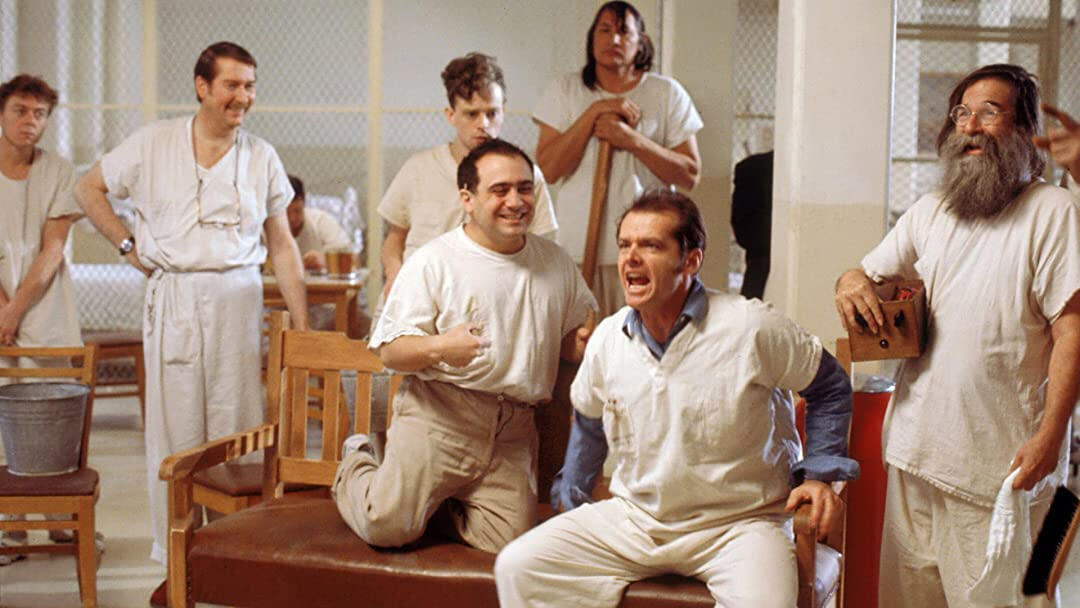
So yeah, I finally watched it. Often regarded as one of the greatest movies of all time, this film has always been on my watchlist. I’d never seen it before and got it on blu ray for Christmas, so... here are my thoughts on the critically acclaimed masterpiece!A question of sanity...One Flew Over The Cuckoos Nest is a psycho-drama at parts, a feel good movie at parts, a disturbing movie at parts, a romance at parts and an almost coming-of-age movie at parts. It can land at a scene of deep psychological endeavour one time, straight from an upbeat scene of bonding and fun. It’s a rollercoaster of emotions much like the crazy mind of McMurphy, but at its core, it’s a film about a dangerous man in a mental institution who may or may not be mentally ill.Take Jack Nicholson’s character in another setting: It’s a party, everyone’s getting along well, drinking, playing games, and McMurphy suddenly goes all... McMurphy. A sick sense of humour, almost no moral compass and a laugh that truly shakes ones soul. It’s clear that he is mad. Bat-shit insane! But here, we see McMurphy in a mental institution, surrounded by wacky insane characters, all distinguished by why they are seen to be outta-place from the general consensus of how people should act. You’ve got anxious stutterers, child-minds, anger issues, people who can’t talk, people who won’t talk, even Doc from Back to the Future! And here amongst these strange folks. McMurphy is now under the spot light as, to us, a voice of sanity and acting as you’d expect a rebellious, but sane, man to act. Now it’s up to you to decide, is he mental, or just dangerous?He’s not a goody-two-shoes that’s for sure.Fade in: Mental Institution...Films that are set in one location are stripped of the, often admired, ability to linger on a beautiful tracking shot or drone recording of an incredible landscape or set, whilst beautiful music plays over, progressing the story and adding tonal value. Just look at 12 Angry Men or His Girl Friday - visually, they’re nothing Oscar worthy, but now it’s up too the script and acting to carry the vision of the film. Despite the temporary ‘school-trip’, this is all set in the single location of the institute, where meetings are held, people sleep, eat, pray and piss... they do everything there! And what stands out when cinematography is restricted to nothing more then tracking foreword in a hallway? the acting! Of course! The cast really well portray people that are clearly mad, and not just by what they say, but their mannerisms. Small ticks or strange habits. Any small gesture that is out of the norm causes us to subconsciously determine their sanity which is helpful in distinguishing the nutty from the normal. The acting is just sublime and one of Jack Nicholson’s best who has many great films to his name (The Shining, The Departed, Chinatown etc).What else does the film do?It questions authority. I quite often find that my favourite films are less black and white. I don’t mean in colour of course, I mean in the way good guys and bad guys are shown. Lots of films quickly establish, these guys are the bad guys who we don’t like, but you do like these guys. It’s all very easy. But this one audaciously questions authority, as the nurses and doctors are shown in an antagonistic light to the victimised and likeable lunatics that are the patients. We grow fond of the patients, following them on journeys, learning about their past and struggles, watching them get into this new found McMurphy form of mischief that suddenly interrupts their daily routine, giving it that coming-of-age feel like I mentioned earlier. However, the people that society tells us to like (nurses and doctors) are now seen as the ‘no fun’ party poopers, giving restraints on the patients possibility for growth despite the nurses and doctors just doing their job. Funny isn’t it. An Alex DeLarge twist with McMurphy.Anyway, if you haven’t seen this film watch it, it’s truly powerful, interesting and compelling with moments of sadness, laughter and pure psychological fuckery.January 2021
A TELEPATHIC LOVE STORY

From the maker of a tranquil Korean masterpiece, comes a hard hitting romantic modern classic set in the streets of Seoul.Whats it about...The film depicts a homeless man who breaks into vacant houses to stay over night, covering his tracks and leaving a trail of undiscovered crimes that he’ll (seemingly) never get convicted for. This all changes when he makes the mistake of breaking into a house with a women still in it, hiding. A mistake... or fate. The homeless man purely trying to put a roof over his head, and women who is in a bad relationship at that time, form an unspoken connection, and I mean that because neither two speak in the duration of the movie. Their not mutes or people who can’t hear, it’s just a plot device that sets this film apart and makes it much more wholesome and original. Only a master like Kim Ki-duk could handle the task and never make the film boring or slow. It just demonstrates the magic of cinema that doesn’t always have to be reliant on having an overwritten script or cliche love story.Kim Ki-duk is the master of silent dialogue. Now I know that’s an oxymoron, after all dialogue is information given via speech. Silent movies like The Red Turtle that have no speech or title cards give information by visuality. But this film feels different, this film doesn’t express information in a ‘first-ten-minutes-of-Up’ kinda way where dramatic actions and extreme facial queues feed you all you need to know, this film behaves exactly like a film with a script would do with its characters actions, situations, and even pacing, but seems to mimic the character's thoughts and words through its surroundings.Just look at the opening. The film wants to tell us that that the protagonist breaks into houses to stay overnight then leaves. How does it tell us this? It doesn’t have the film open with a phone call of him talking about how he’s gonna do business as usual and break into another house - or have his narration give context to another day in the life. Instead we see him suspiciously enter the house in an unconventional method and then play the answer phone’s home recorded message that says “we’re out on a family holiday call back on Monday”. Now we know he doesn’t live here, we know he has a time limit till they return, and a sequence of chores and careful track coverings show us he’s done this many times before and is not taking any chances. Which is so much more enlightening and natural, then the alternative dialogue or narration (the easy way out).The two main characters have a seemingly telepathic connection. Neither speak nor do they need to, and (luckily) it’s never referenced that they don’t. The film forces us to figure out what’s happening, it’s ‘show, don’t tell’ of which we already know Kim Ki-duk has mastered in his phenomenal and visually inspirational masterpiece Spring, Summer, Fall, Winter... and Spring. 3-Iron manages to move like any other romance flick but does so in a much more entertaining and fascinating way that perfectly examples the beauty of cinematic visuality. I love this film, and I love Kim Ki-duk. Genius throughout as well as genuinely heart felt and sincere. I cannot recommend it enough, and I recommend the frustratingly named Spring, Summer, Fall, Winter and... Spring even more. It’s not long, watch it!Feburary 2021
THE PHOTOPLAY PHANTASM

I hate using the phrase 'ahead of it's time' because it's used so freaking often that it defeats the purpose. But this film is from 1921 so yeah, we're safe, this film is light years ahead of it's time!The films clever structure is of a Salvation Army sister on her death bed who requests to see David Holmes one last time (for reasons unknown). Well, we think the film is about her until we do see David Holmes and he drunkard friends on that same day of New Years Eve, gathered in the streets trying to keep warm and exchanging stories; David's spooky tale was of the Phantom Carriage. Don't worry, this film isn't all some tale that starts with a couple people saying it by a fire and we never see them again until the end, this film is different. There's a tale within the tale that then links back to David who links to Salvation Army sister and there are flashbacks to explain how they are acquainted and the spooky story links to why this all being addressed now and... it's impossible to explain without giving a full synopsis of the narrative.It's an episodic structure never before seen that'll continue to surprise you along the way. It never get's boring or stays on a flashback for too long or has pointless plot points, all of it links which is what gives it such a 'scary story' like structure that'll make it easy to tell this whole film over a campfire (if you remember the details). Some things will be unexplained until you learn why that happened later, a bit like Pulp Fiction, so there are many 'that's clever' moments in this film which is always good to have. With a poetic story, a similar (and better then in my opinion) narrative much like A Christmas Carol this film is all about man's ability to change from hopeless to renewed in one night through multiple life changing events, re-imaginings of the past, dances with death all to blossom a new found respect for life and what you have in such a pitiful time. There’s even a prayer in it recited by David about him wanting to reach maturity before death so he will never be Deaths ‘Phantom’. The film shows a plethora of different characters, ones that never give up hope for mankind to thrive, and ones that believe the complete opposite, making this a high concept character study on opposing outlooks for human nature under layers of spooky scary imagery (not unlike Spirited Away) . Speaking of re-imaginings, it would be interesting to see this story re-imagined by modern minds much like how A Christmas Carol has done again and again and again and again as it's the genius story that has stood the test of time with the powerful themes it proposes and how it is handled in the structure. Maybe even on stage... all I know is that I will be reciting this whole thing word for word next time anybody asks to hear a scary story...Plot and heart aside, the visuals are pretty damn impressive too. When you look back on a film the first few images that pop into your head are the most memorable and un-mundane ones in there. This film has so many. The few scenes with the phantom carriage are visually breathtaking, with a transparent ominous looking silhouette of the grim reaper being carried by the horse and carriage over streets or oceans, collecting the dead - it reminded me very much of the visual poetry in Ingmar Bergmans The Seventh Seal who also features Death as a person. Not to mention that this is one of Kubrick's favourite films and an almost shot for shot prophetic imagining of the 'here's Johnny' scene in The Shining features in this 1921 classic (look it up on YouTube, the resemblance is uncanny). Mixing those shots of visual despair with the unbelievably amazing soundtrack and this film had me giving it a round of applause.I genuinely cannot explain how incredible the score was. By the time of (and I hate to give this unbelievably racist film any credit) The Birth of a Nation (1915) photo-play had been completely perfected with a combination of ragtime and alterations of certain famous music pieces to associate certain sound to certain scene emotions (like we still have to today), and out of all the silent movies I have seen this film easily had the best soundtrack. Genuinely scary scenes that shook my core carried not only by the horrendously haunting concept of the phantom carriage and the dim visuals but by the bleak and somber soundtrack, ameliorated to Bernard Herrman Psycho level scary at scenes of upmost anxiety inducing fear. Hauntingly beautiful and this was 1921!I can't explain how much I loved and was surprised by this 'better-then-A-Christmas-Carol' century old movie that scared me a surprising amount as I'm getting harder and harder to scare, moved me by all the heart and message in the film and had me cracking up of laughter at the end. Why? This film is Swedish okay, and does anyone know what the Swedish word of 'The End' is? Anyone? Anyone?! Slut. So right at the end of a heartfelt ending that I'm not gonna lie I got a bit teary at, what appeared on the screen...slut.Never laughed so hard in my life.January 2021
THE CRISIS WITH CHRISTIAN CINEMA
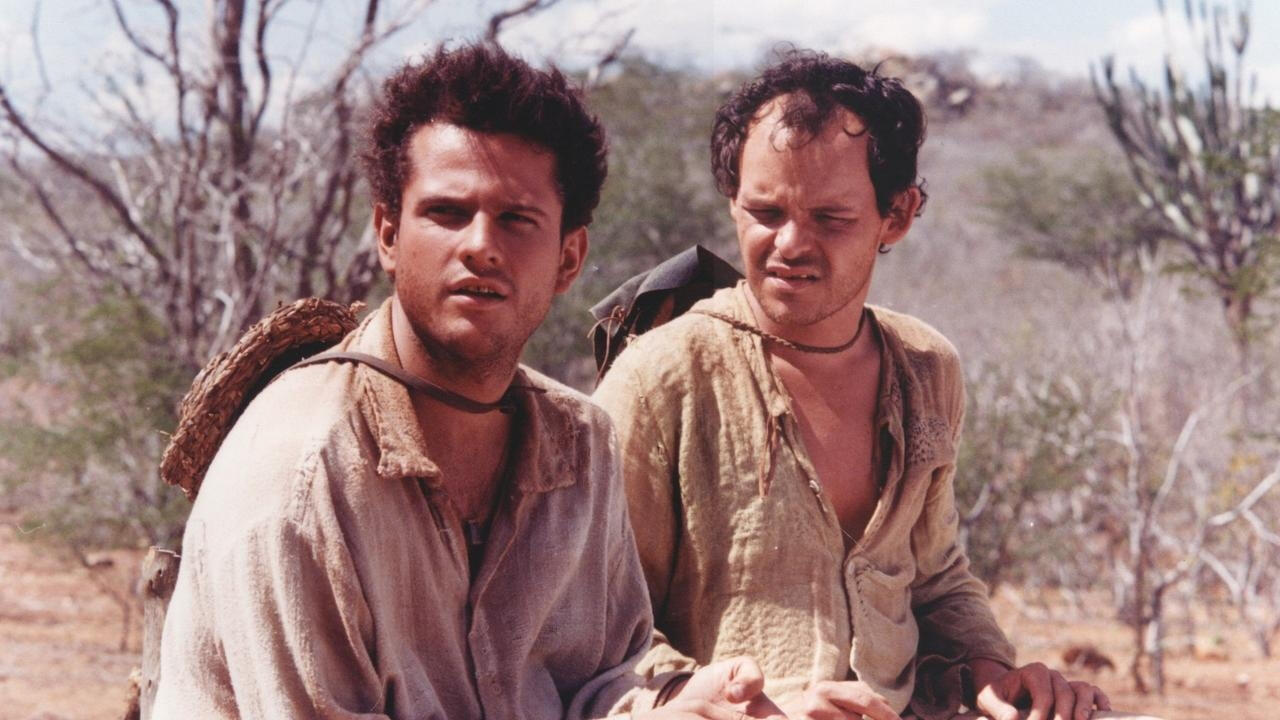
I was expecting, from the IMDB and Letterboxd ratings, for this to be a masterpiece, but I wasn't expecting it to be a Christian masterpiece!As a Christian and a cinephile, I often find it hard to find great films that are explicitly theological. You'll often find great Art House foreign films like that of Ingmar Bergman and Carl Theodor Dreyer's that implicitly reference scripture and imply biblical values with unspoken but parroted liturgical narrative intent, but usually films that are aimed at a Christian audience tend to loose integrity of film-making by purely trying to brainwash the audience with an extremely boring story... mostly aimed at kids which is okay for what it is. I say boring because films should draw off the sin of the world. The sin of people, the sin of society. It can be used destructively to promote that sin but it usually has a hope-restoring narrative that is for human kind and promotes the way us, as humans, should live. But Christian marketed films seem to handle these subjects of life with a small minded bias that has no entertainment when only handling an extremely innocent story that disregards half their audience (again these are mostly aimed at kids). For this, it was fantastic to find a film from the Catholic heavy (64.6%) country of Brazil that was genuinely brilliant and effectively compelling. It deals with the hard to handle topic of religion that sticks to Christian morals but doesn't force it down peoples throats with a brainwashing plot intended to scare people to Catholicism. It does this with an edge... it's a comedy.Originally a TV mini-series of four parts, A Dog's Will shortens a 2 hour and 54 minute version to the feature length 1 hour and 44 minute film that is better known. You can really tell it was originally a series as, at first, it felt very rushed. I actually checked to see if it wasn't mistakenly on 2x speed as the dialogue was rapid, the plot points where hitting like bullets... the film never breathed and that stayed true throughout. You've just got to adjust, and hope your a fast reader because the conversation speed was close to that of a western auctioneer. As you can expect, I wasn't sold immediately. It felt very made for TV with it's comedy, cuts, even music and I really didn't want what was happening to carry on throughout. After an hour and six minutes however, it all changes and becomes something that puts the rest of the film in perspective (more on that later). It's not like Audition or Don't Look, Now where it get's good near the end then you'll love it on re watch, as for the first, what I assume are three episodes in the mini-series, it's just fine. We follow Chicó and Jack the Rat on their mischievous adventures all well stringed together in a fun, well moving and clever narrative that I liked. However, I found myself asking is it really the kind of thing that is top 10 Letterboxd worthy, regarded in the same right as Parasite, The Godfather duo even Seven Samurai! Not quite. I knew it hadn't fully picked up yet and despite my many laughs, my adapting to a break neck pace and the amount of times I went 'oh, that's clever' it still felt made for TV and still didn't feel like the holy grail it's referenced as. Until......something remarkable happened. The narrative shift at an hour and six minutes is such a strange one that soon makes sense. Through an event (of which I won't reveal for your sake) we see the first narrative tone of a fun, offbeat, clever comedy be forced to look at itself again and re evaluate what it means when it comes to the presence of God and eternal life. If you can overlook the insanely bad cheap special effects, the scenes with Jesus, the Devil and a surprise cameo from Fernanda Montenegro who is the leading lady in the only other Brazilian film I've seen and adore (Central Station) are excellent and so well written. We see all the characters previously introduced challenged to redeem their actions in the form of a clever McGuffin with genuine theological insight. We see the meaning of the strange first hour or so that has previously ran past our eyes, it all links for the perfect re evaluation of something that seemed fairly basic, now becoming a transcendent masterpiece. However, the comedy doesn't fade.When dealing not just with archetypes of Jesus and the Devil but the actual Jesus and the actual devil, it's easy to make a cheap and slightly offensive comedy that goes against liturgy for cheap laughs (just look at most CollegeHumor shorts)... which is fine, however with this, here we meet the huge omnipotent figure of Jesus and the merciless Devil matched with the well played and mischievously clever Jack the Rat who knows he can never justify his sins. With a situation that plays out like a court case, morals are questioned, and the film becomes something much much bigger then a silly TV comedy. With laugh out loud moments as well as compelling scenes of biblical reasoning it propels the narrative at not just something that makes jokes in the confines of Brazil at the people in a village who are trying to get by, but it's now making jokes at something of abstract theology. The comedy is a reminder of the light-hearted tone, but not distraction from the overwhelming themes it deals with. Because of this, I feel the TV show would be even better as we'd get to know the characters better in the first hour and six minutes of the movie. It's both funny and deep.So yeah, that's my thought’s on A Dog's Will or O Auto da Compadecida, a film of motivated passion derived from Christianity as well as a well formed comedy/ drama that cleverly twists on it's head. It also has a certain social commentary edge that is briefly addressed when displaying Jesus as black and playing off the common racism in Brazil. Check it out if your interested you won't regret it and it's one to tick off from the Letterboxd top 250 (top 10 for that matter). Just please do not read any descriptions as it gives away what the twist is and I tried to be as vague as possible whilst still saying my thoughts on the film. I really enjoyed it and hope to watch more Brazilian films in the future as the two I've seen are great. Any recommendations are welcome I've just bought the DVD for City of God which I'm excited for. Also if any of you know how to find the TV version of this please tell me I'm desperate to watch it.Febuary 2021
THE FACADE OF CLASS
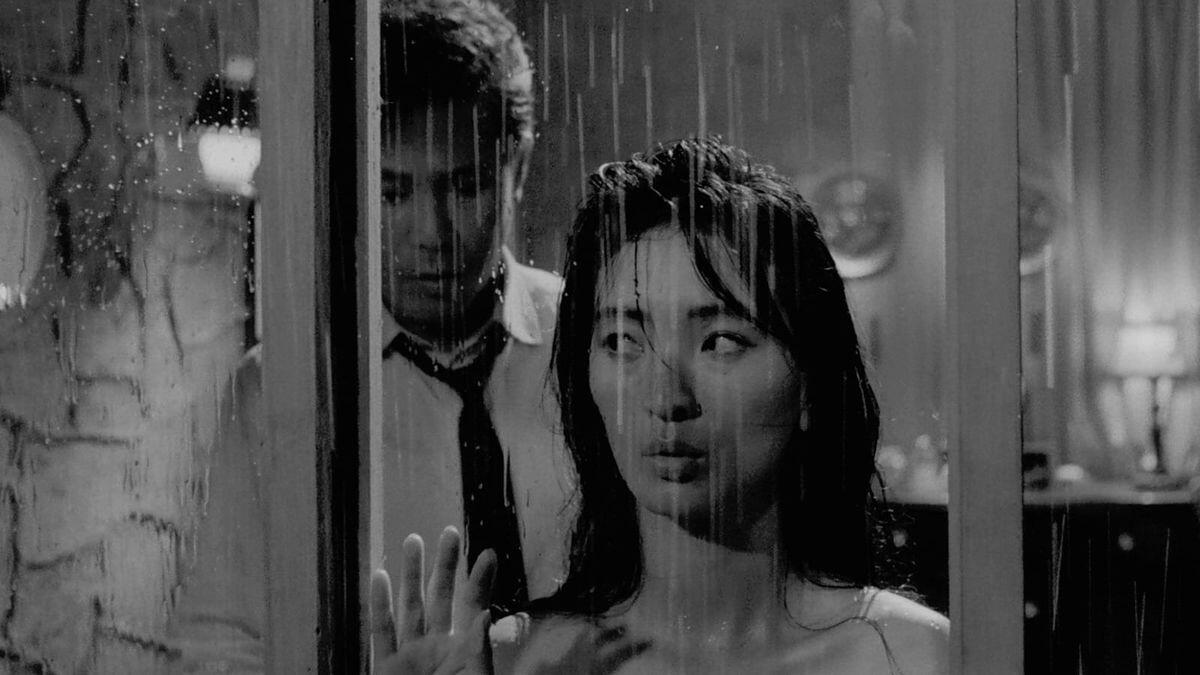
Before Parasite, there was The Housemaid...Parasite is a film about a higher class, rich family who’s lives are totally ruined by one much lower class, poor family. The dirtier, semi-basement living group decide to infiltrate the beautiful two story house of the rich family in a clever scheme to bring them all in one by one and, in turn, they bring out the worst in the, once happy upper class family. Of course there’s loads more too it but, in a way, that small synopsis was totally this film too. Bong Joon-ho himself has talked openly about this film being the main inspiration for last years best picture winning epic, and it’s easy to see why. Kim Ki-young use of semiosis to suggest character authority is very similar to that of Joon-ho’s in all of his movies especially The Host. The linear structure that escalates rapidly from one plot point to another couldn’t be more like Parasite. And of course the overarching themes of this movie that’ll I’ll get into later are also explored by Joon-ho who, like Ki-young, has a lot to say in these films, from a political and filmmaking standpoint.“Housemaid is a melodrama, a crime drama, as well as a horror movie.” - Boon Joon-hoRight from the start of the film it is clear that it’ll be character-driven. We are introduced to the Kim family and the actions/script have already shown us that the father is in authority, the mother is kind but submissive, the son is mischievous and the daughter is patient and rule-abiding. We know that they are moving house and Mr. Kim is a piano teacher at a school and does lessons from home; a simple and traditional family status to follow. However, interactions with others outside the middle class household suggest a change in characteristics all linking to how much of human nature is down to your living situation.For example, when we are first introduced to the housemaid (who through most of the film is seen as an antagonistic figure) the first thing we learn is that she can kill a rat by poisoning food. A clear omen of the trouble that’ll be caused later. We now know from her class that she isn’t in authority, but by her actions that she won’t be a goody two shoes throughout the duration of the film. Bong Joon-ho also noted that in Korea 1960, to have a house with two floors showed wealth as most only had one. This is why (as the film is mostly all set in the house) stairs are constantly shown in different scenes to remind the audience of the Kim family’s social status, in the same way that Parasite uses windows and a High and Low style visual representation of upper/lower class to indicate the clear disparity in social authority.As I mentioned earlier, the film is also notably linear. It has an almost ‘keep-up-with-me-if-you-can’ structure as an important narrative moment is shown in almost every cut, to a extremely focal extent. The film gets straight to it, plot-wise. No Tarantino-esk random pieces of dialogue, no outta place comedic moments, no random gratuitous sex scenes or off track character ahrens, it’s just plot, it’s just story, which gives the melodrama that narrative inducing edge that puts others to shame. In fact, early in the film, certain plot twists are already revealed to the audience in a way that most movies would present them near the end. It’s truly unique and fantastically executed leaving you leaning in, and never boring you once you’ve adjusted to the distinctive narrative pace.Who did it better?When it comes to the comparison of 1960’s The Housemaid and 2020’s Parasite, I am more in favour of the latter. I first saw Parasite months after its UK release. I’d heard about the domestic box office success in Korea and later learnt about the ground breaking Oscar wins (it being the first foreign film to win best picture and all). When I sat down to watch it I knew nothing. I was totally blind and extremely excited for what was to come. And (surprise) loved it! I’ve seen it twice since and it’s held up each time, always something new to notice or/and analyse. I haven’t met or heard from a soul who could possible conjure a pessimistic word about this holy grail of a movie with an impossible-to-pidgeon-hole genre. Visually, it’s INCREDIBLE and I plan on watching the black and white version in the future as Bong Joon-ho said it is important to showing the contrast in class. I could watch it any day of the week, any mood and it’ll still captivate me. But! Does watching the similar The Housemaid take away from Parasites originality? No! If anything it enhances my understanding of Parasite. The Housemaid is slightly more obvious in its themes as in the end we have a literal fourth wall break telling us about the urges of men, so you can even view this as a pre-parasite analysis on Parasite and what it was trying to express to us. Still, The Housemaid is its own, uniquely enjoyable and unpredictable masterwork from Kim Ki-young and continued to hold up as a fantastically ‘edge-of-your-seat’ thriller.So what makes Parasite better then? Again, Parasite is much much more visually inclined. In fact, about half of what made Parasite so unique and Oscar-worthy was the bold cinematography and plot carrying visuals. With The Housemaid, there were lots of nice looking shots and nothing about the camera work was boring... but it just didn’t compare (visually) to the many locations, bigger budget and incredible design of Parasite at all. As well as that I did also find Parasites plot much more mind bending and unpredictable with so many jaw dropping moments of fear, laughter or tension. It had so many recurring moments that will stun you and make you go ‘oh yeah, forgot about that’ served up with ingenious plot points that’ll make you wanna give the film a stand ovation. When it comes to similarities between The Housemaid and Parasite, it’s generally in what they are politically saying and the way they execute that. Kim Ki-young and Bong Joon-ho seem to be very similar minds and I’m sure would be best of mates if he was alive today, as well as really enjoying each other’s movies. Parasite is the opposite of a rip off of The Housemaid, just an emilioration of what The Housemaid got right!All in all, without spoiling anything, this film is about human nature, sexual urges, blackmail and of course class, with people of all different social status bringing out their dark side when inner human temptations come out in a flood of unavoidable sin, as classes mix... not to mention the string of consequences that come after the initial point of contact with dissident young outsiders. The film shares many similarities with Parasite in its character roles and it’s political Korean commentary on the dispersion between social classes, yet both still seem very unique and, if anything, it’s boosts my understanding of the complex masterpiece that is Parasite. The film isn’t about good guys and bad guys, it’s about deep human instinct and how that can be exploited by class and temptation (again very similar to Joon-ho’s movies). If you liked Parasite (which I can only assume you did) I can guarantee that you’ll enjoy this black and white masterpiece:
The Housemaid.January 2021
BROTHERHOOD BEYOND POLITICS
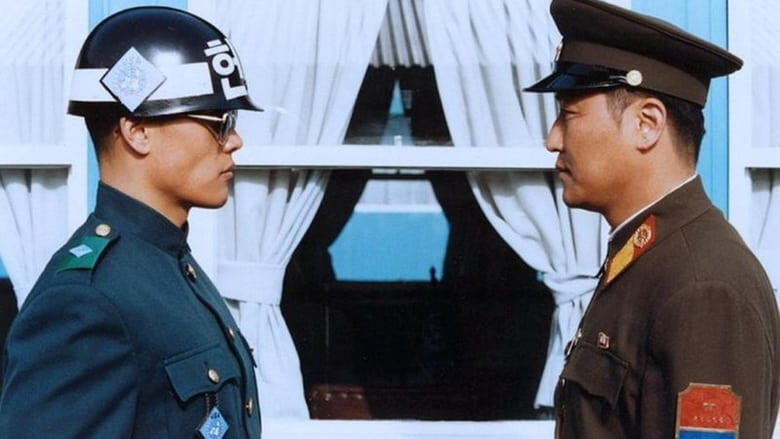
Trust me this film is better then it sounds and looks from the crappy poster. What appears to be a low budget, high octane, South Korean military action movie is a masterpiece in disguise, and a hidden gem at that!Park Chan-wook has produced many masterpieces from Oldboy to The Handmaiden. Darker modern classic like Sympathy for Mr. Vengeance and Sympathy for Lady Vengeance have still managed to amaze and disturb audiences today, and the hypnotically stylistic horror movies like Thirst and Stoker that have shocked fans for years. However, there's one of his features that is criminally overlooked. Joint Security Area may sound like some budget action flick, but it's so much more. One of Park Chan-wook's most political features, this film addresses the divide of North and South Korea after the Korean war showing the stupidity of separating people of the same blood. The film has a defined three act very episodic structure that jumps in time ingeniously making a good story great. Although I don't want to spoil anything, I could give you a rough tease of what it's about.Picking up at the Joint Security Area, a Korean by blood officer (Sgt. Jean) who has never visited Korea before, comes to investigate a strange and still unsolved case that happened at the border. Throughout the film, as it commonly references the Korean War, we don’t know whether Sgt. Jean is North or South Korean - we don’t know what side her ancestors took. This makes her neutral ground when it comes to confrontation, as she is without bias unlike the patriotic others around her. The case is that after military soldiers where alerted that North Koreans soldiers where massing from the border at the DMZ (where most of this will take place), two North Koreans where found shot dead with South Korean soldier Sgt. Lee escaping and North Korean Sgt. Oh played by Song Kang-ho (Parasite, The Host, Sympathy for Mr. Vengeance) having survived. It is under the JSA's awareness that Sgt. Lee was kidnapped and shot his way out but Sgt. Jean spots many anomalies in the questionable accusation. Quickly gathering evidence she notices that there is a missing bullet in crime scene that asks questions about the liability of Sgt. Lee's confession. We, as the audience, are also confused, so don't be confused when your confused, your meant to be. As time progresses in the runtime, time reverses to show us how we lead up to the incident, in many spine chilling scenes of tension in the highest form. A scene could ameliorate to a casual scene of upmost comfort, pierced like a balloon with just one frame to shift the narrative on it's head. It's all about discovering the brutal truth of such an open ended case. And the truth takes form in an unpredictable tale of brotherhood and bold political commentary.You can tell Park Chan-wook really pushed the boundaries with the ideas he explores about the difference between communism and capitalism not effecting the bond of man. Much like All Quiet on the Western Front, it boldly talks about how sides don't matter when it comes to basic human nature, and how communism is a facade for North Koreans. At times it's heart warming, at times it's utterly heart breaking, but the key thing there is that it has heart, and a beautiful message that unifies all Koreans in an extremely interesting and bold story that could easily become true. It often references the Korean war to enhance it's stance of the idea of division, perfectly exampled with the different perspectives that we eventually see play out in an epic scene of explanation, that acts almost as a conclusion despite being set in the middle of the narratives time span, ingeniously differentiating continuity from structure. A unique structure that gives us everyone's verdict and the definitive truth. Not the mention the incredible ending where a photo that seemed irrelevant helps conclude the movie perfectly as the camera zooms through the frame and shows the definite link between the main characters. One of the most surprisingly visceral moments as it lets the film breathe for a second before ending.As well as talking about the stupidity of political division explored through an unlikely tale of brotherhood, it also dives into and exposes the flaws when it comes to Korean military. The stupid rules you must follow that are immoral yet legal. Anything deemed illegal being a crime with no human emotions allowed to enter the equation. It shows the confidentiality and precise nature of Sgt. Jeans handling of the case, making her the flawless protagonist from the outset, then shifting to a new character focus in the narrative - a complete tonal and chronological shift that enforces something Park Chan-wook is so good at. This is something I referenced earlier when talking about any plot confusion when watching. Much like Sympathy for Lady Vengeance this film will take you to a different time in story, or a different location or character completely without any context and complete lack of cut continuity... and you will be confused. As time progresses you'll come to realize where you are as this situation has been talked about and leads to something in the future but it's something so briefly talked about that you are unsure of whats gonna happen and more importantly, you don't know why the film has taken you here. But by the time the credits roll it will all piece together like a jigsaw and what seemed like an incoherent mess, will be a cultivated story, with cement of continuity to fill the cracks of utter confusion. Just trust that everything there is for a reason and don't expect a recap. You figure the film out by paying attention much like an officer gavering information from a case and figuring out the definitive thesis. That same thesis: is this movies pay off. It's one of those films when you can only exhale when it's all over.Structure and plot aside, what about this film's visuality. As Park Chan-Wooks first major film it had a low budget, and at times it shows. We know from his other work that he is an extremely visual and a style depended director, so how limiting was the factor of money? Well, it still managed to be the highest grossing Korean film in film history at the time. Why? Because it didn't let budget restraint it's cinematography. It was shot like it had all the money in the world. Not only high quality camera but style was substance when it came to filming. The shot composition was either perfectly symmetrical or pleasingly asymmetrical - they managed to find great shots in even the most mundane situations making me spoilt for choice when picking images for this article. Just look at the scene in the mine field, one of the best moments of the film, not to mention one of the scariest. That was shot with such confidence like it was some big blockbuster and really worked for that attitude, making that scene petrifying in it's own right. The cut's in time where seamless, the archive footage scenes showing real clips from the Korean war where done in a very stylistic way, it's a unique movie to say the least and the cinematography captures that same audacious story they tell well. As we see Park Chan-wook further in his career we see his style only getting better, now being able to afford his full vision!It's a great, unique and very visceral movie and that's not nearly talked about enough. I'd highly recommend you give it a go especially if your familiar with the director and recognize his approach to film-making. It's a roller coaster of a film as well as sorta educational on the political system of North and South Korea. An important film for Korea and a fascinating one for us. Don't put it off because it looks crap from the cover, I almost did.February 2021
DEATH, DESIRE AND DUALITY

This film catches your attention before it even begins. The title is obviously a play on word's with the ' Thank You for Not Smoking' signs, which itself stands as an intriguing piece of socio-political propaganda... but the automatic marketed intrigue doesn't end there. The poster is a self standing piece of art with a large cigarette dressed in a suit presumably representing the anti hero of Nick Naylor. Removing any tagline or cast list tease from the image would make it a political comment already, so just imagine how powerful a feature length film of the same audacious nature would be. Or, is the poster the best thing about the film?Well it's not.Although you shouldn't judge a book by it's cover I totally did. Knowing nothing about it other then a possible moral to the story, this films advertisement has lasted to be as original and interesting as it was 16 years ago. Thank You for Smoking is an adaptation of the fictional novel by Christopher Buckley of the same name, however it is perfectly believable as a dramatized true story expressing extremes of real authority figures. It depicts the character of Nick Naylor, a tobacco lobbyist of the 1990's who's one of the most hated and at the same time admired men in America. The film makes it automatically clear that he is responsible for hundreds of thousands of peoples deaths from advertising cigarettes as a harmless purchase. However, he isn't shone in an antagonistic light, nor is he shone in a light of pity. He act's just like a harmless millionaire but with the explicit facts eliminating any real sense harmlessness. All done with a stylized and fun approach to narration that shows all aspects of Nick's job yet showing off a tough to hate personality that got him to the top. The statements about his job as a seller of one of the biggest killers in America is pretty on the nose, but how he is portrayed is much more confusing. We're told to like this 'cancer trafficker' all so we can see both sides of such a hard yet profitable job. He's faced with the burdening duality of a well payed job of high status, but putting many others in danger; not unlike the duality of a cigarette, that one puff of pleasure and relaxation is the same thing that's killing you. When it comes to walking the anti-hero tightrope i think Thank You for Smoking tackles it not just well, but in a more more original and enigmatic way to other films of it's era. Aside from the character study of Nick Naylor this film also questions authority's roles in health and safety as well selfish morality. Making it more of a commentary then just a character based satire.I'd also like to mention how it tackles not only smoking but some of the other big international murderers. Such as alcoholism and gun-crime (the latter of which is more American then universal). This is handled with the M.O.D (Merchants of Death), Nick's friends that we see continuously throughout the film. There's Pauli who works for the Moderation Council "casual drinker since the age of 14", Bobby J who works for S.A.F.E.T.Y (Society for the Advancement of Firearms and Effective Training for Youth) and of course our humble narrator Nick. They are debuted in the film with a lovely bar scene in which we stylishly see their own selfish line of work in brief but fun pieces of glamorized exposition. The set up of the bar scene will become a returning setting and meeting point throughout the runtime. One particularly satirical meeting is when they get into a pissing contest about who's profession kills the most people a day (smoking coming out on top). It a nice and evil piece of character reaffirmation that helps build our understanding of the who these people are. Interestingly enough we do see drinking and shooting in the film on multiple occasions but, and correct me if I'm wrong, the only lit cigarette is on the poster. Much like the idea of remembering a well made low budget horror film as gruesome despite spilling little to no blood, this film will be remembered as a drug dirty one despite there being less cigarettes in it then Peter Pan itself. Don't know if that was deliberate but it's a fun little fact.All my concerns about it being 'of it's time' where proved wrong by such an interesting satire that has held up fantastically. Although it's never highly regarded, or listed among the best films of the 00's or at all squeezed it's way into the cinephiles equivalent of pop culture, it's not to be missed. I'm here to tell you that it's great and underappreciated - a totally original and well made piece of art, that's message heavy, different and playful. Not to mention it's main love dynamic is the exact same as in The Dark Knight when it comes to actors (this was made three years before Nolan's big hit). It's on Disney+ (who would've guessed) and isn't long at all so check it out. Great soundtrack, electric acting, a watertight script and kinetic editing; Jason Reitman is a truly fascinating director.March 2021
.
HOW TO CRAFT ACTION
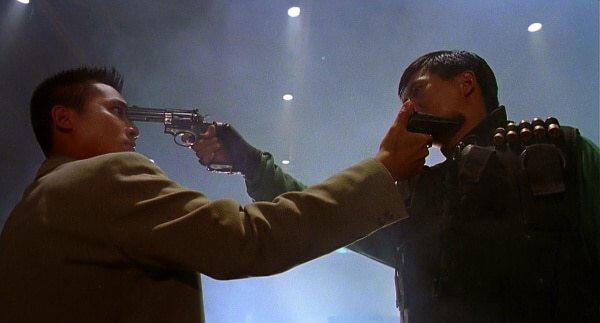
Action films can be the most adrenaline filled hi octane shots of espresso coffee you will ever have. Whether you’re leaning in from your seat, rapidly dodging debris in a car chase or cheering when the baddies get what was coming to them, action films have all the intent to give you whiplash mentally and physically. However, as we all have observed over many precariously crafted flops, action can easily slip from the stimulus of an experience to a total snooze fest. But how does a film with a big budget, a-list actors and enough cgi to give Attack of the Clones an overdose become boring? It’s pretty simple.The action isn’t the interesting part.You may have bought the ticket to see this particular film because Jason Statham was on the cover pointing a gun into the oblivion with a helicopter above him, good looking girl beside him as a well known European location burns in the background, but that film won’t live up to its enticing trickery of a poster. Whilst the concept of murder murder sex murder might sound like what some enjoyed about a good action film, it’s not. Any action film worth its salt will be good because of its narrative. Because you care about the developed characters, because you don’t want them to die. Much like Hitchcock's famous quote about two parallel but differently executed situations: in one two people are sitting at a table and a bomb suddenly goes off killing both and in the other the same thing happens but we are told about the bomb ten minutes before the explosion.Whilst the first situation will be a momentary burst of heightened spontaneous insanity, your gut feeling of epinephrine will quickly reduce back to boredom and any remnant of film-making dignity will have disappeared as thousands of pounds was just wasted on a ‘cheap’ thrill. However when you are given the information of the bomb prior to the explosion you spend the next ten minutes on the edge of your seat. Shouting at the screen for them to walk away. The conversation isn’t boring and meaningless; it's a tedious piece of frustration for the audience as the protagonist’s ignorance is now causing you to literally shout and jump. What I’m getting at is you need plot, development and tension in order for the explosions and gunshots not to be money down the drain. You came to see a man arbitrarily giving out bullets like a game show, but you stayed for any layer of ‘stake heightening’ development that gives the action purpose.However, today I’m going to look at Hard Boiled and talk about how John Woo’s approach to action film-making is so perfectly crafted. First a small disclaimer, there is no one way to craft an action sequence. One thing that people who have been exposed to the genre think they know about action film-making is that it needs to be fast. In Walter Murches book In The Blink Of An Eye he talks about how our blinking influences the normality of screen jumps in films that lack continuity between cut. Blinking usually occurs when one subject in speech or just a situation has changed. In fighting you are constantly changing thought; wondering where to punch or where your next punch is coming from. The thought pattern represents the code of editing that works differently for different scene’s of action. This idea of a fast pace, however, isn’t always the case at all. Jackie Chan’s wider screen approach where he comically and ingeniously uses his surroundings to pack a punch is perfect for his light hearted tone. In the same way that The Raid’s more kinetic yet much more brutal form of editing and shaky cam shooting, is cause for a more painful and edge of your seat sequence then you’d find in a comedy. The style of action editing/ filming highly depends on the tone, the fighting style, the scene’s focus and most importantly the context.In John Woo’s Hard Boiled, the tone can vary from a fairly lighthearted yet adrenaline-filled and cringe inducing sequence, to scene’s of utmost tension where so much is at stake. The first action sequence is at a bar. We don’t know the context for the scene but slowly develop theories as the cinematic language suggests something shady and who the people are. (Who’s the ‘cops’ and who’s the ‘robbers’ of the scene). Then as a range of techniques build up that tension, it bursts into an epic fight scene and teaser for the hectic ride ahead. This scene is obviously very gun based, different to the likes of Gareth Evans (The Raid) or Jackie Chan’s of which we discussed earlier. The core sense of blood pumping action isn’t dependent on editing, nor the approach of barely-on-camera punches creating the illusion of violence despite little being shown (much like the suggestion of the shower scene in Psycho). Instead, we see genuinely good set’s getting destroyed in easy-to-observe way’s as genuinely good choreography hit’s the screen. The director clearly isn’t in his seat asking for a one second close up all the time to be meshed together in some epilectic nightmare, but is making a cool and believable unbroken gunfight where the camera is purely there to capture not fool.Now let’s skip ahead to the better known hospital fight. A Die Hard worthy chunk of the movie in which stakes get higher and higher. We’ve seen a whole feature of ‘cops’ and ‘robbers’, the film’s set up the dynamics and displayed all outlets of now colliding plot-tension that will be put together in one location like a tsunami that’s been getting bigger and bigger for the last hour and a half and is about to hit the shore. Now, Woo switches it up a bit. He has the main two characters with the strongest central dynamic put together going in an elevator and up a level full of baddies. Woo uses a oner to capture such carnage. He has them enter the lift then scutter around a hospital floor as the camera follows their tail. Then re enter the adjacent lift and have the crew tidy up the floor to mischievously portray the same set as the second level. Lot’s of this is in slo-mo and we have more time to process every gunshot and every important piece of information. We feel their hearts beat and eye’s flutter much like how the editing would be in normal time. We capture each moment of the scene rather than have it run past us and it works. Almost like the film is breathing despite it still being a raging battle. We feel the emotional connection of panic and a lust to take-in whatever you can rather than just the kinetic thought patterns of fighting. Oldboy similarly does a oner for a hallway scene but in that it’s to show the tedious nature of an exhausting encounter. The audience is left out of breath. In Hard Boiled however, the oner leaves us with the same feeling of dread the characters do. The diversity of action film making.Woo had a similar approach in his earlier film The Killer. With a complex dynamic undergoing brutal action. The stakes would be heightened and action would be meaningful with every shot endured by the team we are supporting. The more power that is brought to the scene the more we will both enjoy and dread it. So that’s my take on Hard Boiled and action as a whole. There are so many unique and equally brutal approaches from Bruce Lee’s martial art’s duel style, to Park Chan-Wook’s (Oldboy) painful simulator of a merciless battle. Which one works best for you? I’d recommend checking out both The Killer and Hard Boiled. They bare many similarities, the former of which suffering greatly from certain aged 90’s tropes that just look silly now. But both still very clever films, and well made examples of how to shoot conflict on screen.
CENSORS VS. SCREAM
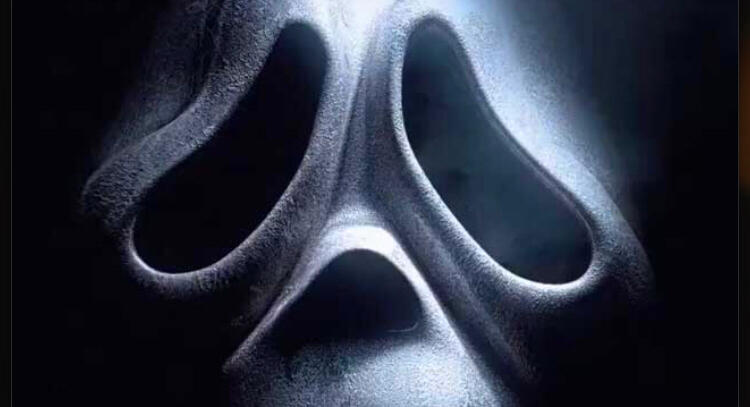
1996 gave birth to a horror film that then gave birth to a new wave of horror films that then gave birth the modern jumpscare subgenre that is dominant today.Let’s rewind...generic iMovie rewind sound playsThroughout the 80’s, horror was a big thing. For me, I see 80’s horror as the birth of blood and guts on screen, yet also the year where banning and moral panic around horror films began to rise rapidly. Why? Like I said, blood and guts! Practical effects had never been so good, with effects wizards like Rik Baker (An American Werewolf in London (also first person to win an Oscar for best makeup effects and Hairstyling in 1982)) Mark Showstrom (Evil Dead II, Elm Street films, The Mutilator and Videodrome), Rob Bottin (the mastermind best known for his incredible work on John Carpenter's The Thing) and most famous of all Tom Savini (Dawn of the Dead, Friday the 13th, The Burning, Creepshow, Maniac, director of Night of the Living Dead remake and had a cameo on The Simpsons). Horror movie buffs around the world in the 80’s had a real blood-lust for the gore only teased in late 70’s films like Texas Chainsaw Massacre and that of the work of Dario Argento. It was the spawn, of the Blood Fest sub-genre and of course very present when it came to slasher films! Peter Normanton's great book ‘the mammoth book of slasher movies’ pointed out that from 1980 - 1984 cinema saw the golden age of slasher flicks, abruptly interrupted by the paranoid parents ruling the Video Nasties campaign made in 1983. Absurd slashers like The Burning and Giallo films like Feluci’s Zombie Flesh Eaters were getting banned left right and center, with some cult video nasties not seeing the light of day until the 00's! It was a horror movie of it's own. In the end, the BBFC and other companies were much harsher on censorship when it came to horror films. A prime example is the Friday the 13th franchise. The first installment was very bloody indeed, but as time progressed, we started to see less and less gore, more off screen kills and slapstick humor to lighten the mood. Films like Evil Dead II were using differently coloured blood to make it less realistic (as in the first film director Sam Raimi had to go to court and prove the effects weren't real)! Despite this, horror still thrived throughout the 80’s but slashers both being largely demonetized by censors and having the formula done to death, was fading away into oblivion. By the 90’s we were in new territory with horror. More psychological films like Silence of the lambs, Se7en and Misery being brought to screen as it was seen as ‘more sophisticated’ and required less (or no) visible blood and gore in general, and despite Peter Jackson's wild and more inappropriate gore-fests being made in New Zealand (Braindead, Bad Taste, Meet the Feebles) for America, blood was scrubbed from the white tiled floor, off into cinematic abyss, and Slashers were both looked down upon, and truly dead with the exception of Candyman 1992. But then a ghost-faced angel came to the rescue. A largely released and talked about horror epic, that would have a big star cast of Drew Barrymore, Courtney Cox, Neve Campbell and David Arquette and made by legendary Elm street creator Wes Craven. Scream would hit cinemas with a bang and a new breed of fright!SCREAMThe bloodily funny stab-fest was everything a horror fan in the 90's could want, and so much more. It was self-aware… for the first time. Commenting on the blueprint of slasher movies and the flaws of the design of horror movies in the past. The stupid decisions and unrealistic characters, it was making fun of them to the max, even though it was directed by the creator of the horror franchise that obeyed the formula like any other: A Nightmare on Elm Street. But here, for the first time, we had real people, talking about how real people feel about horror films and how they usually are repetitive when it comes to the absurd slasher flicks. For an example in Scream, the infamous three rule scene at the Stu’s party “never have sex, never drink or do drugs, and never say “I’ll be right back” does it get more meta then that? But, years later, there was a flaw in the self aware comedy, soon becoming a done to death formula of itself.SCREAM 2: SEQUELSThe second installment Scream 2 was made the next year with the same cast and crew. This bittersweet sequel that I rather like, commented on sequels. With film school classes listing their favourite second-commers from The Godfather part II to Terminator 2, it became quick to realize that this film would take on the usual sequel tropes, but how well will it do so? It had similar horror to the first, a similar but less well done Ghostface reveal to the first and of course relationships of the characters developed. Most like it, no-one prefers it to the original, but it was a fairly clever commentary on the tough job of making a second horror film to the phenomenal first.SCREAM 3: ROUNDING THINGS UPThen, in the year 2000 came a much less well received third installment. Scream 3, as you would have guessed, commented on the final installment of a trilogy. The close off of the series. The finale. The Godfather part III. And much like The Godfather part III, this film was by far the worst! A boring generic plot, you began to see the issue with overuse of self awareness, and that Ghostface reveal at the end was AWFUL! Anyone who has seen it will agree! I don’t want to complain about this film too much so all you need to know is that this film was about finishing the series. The only good thing was the ending when the incredible looking Sidney Prescott looked at an open door and kept it open as nothing bad would ever happen to her again...but not quite yet!SCREAM 4: REBOOTSWes Craven's last film before he sadly died in 2015, was 2011’s Scream 4. Often referred to as the best since the first, this film was a fair crowd-pleaser. The original cast were back with some fresh faces too, and it was by far the goriest yet (which is always nice). However now it was clear, being meta did not work anymore at all! The writers knew that making fun of a cliche in a horror film whilst being stabbed to death was a cliche of its own so went ahead and parodied that too. But with that, the film, to me, felt much more like a collection of cliches then a parody of them! (A cliche within a cliche within a cliche etc). Like I said, there were some new faces as this film made fun of reboots (new casts) and although this was clear, they cared more about making fun of reboots then actually giving the audience any chance to like the new cast at all. It was totally rushed and hard to enjoy.In the end I was debating how much of a movie is meta, before it becomes a cliche and not a well done movie. All I can say is this film was too self aware to enjoy, but still wasn’t quite as bad as the third (at least it had a good Ghostface reveal).So that brings us back to the start with Scream 5.SCREAM 5The original cast are returning (which Scream 4 proved not to totally be a good thing), the film will nonsensically be called Scream instead of Scream 5, it’s coming out on the 14th of January 2022 and will be made by Radio Silence, the legendary directors that brought us Ready or Not, Southbound and the third best V/H/S sketch 10/31/98 (the haunted house Halloween one). That’s all that we KNOW, but what do we predict? Well, as Scream has always made fun of the structure of slasher franchises in the different periods and stages of their films, we need to figure out where long running slasher franchises are now, and the answer to that is, they’re finally ending! Late 70’s early 80’s were the first installments. Sequels would follow closely in the years to come until they came to an apparent end in the 90's. Then reborn in the late 90’s and 00’s with reboots, prequels and spin offs (all bad usually) and in the 10’s it was all remakes (always bad for horror)! But now in the 20’s (that’s kinda weird to say we're in the 20’s by the way) were getting films like Halloween Ends. We’ve realized (finally) that we can't milk out more sequels and it’s time to finish them and hopefully focus on more original horror films to announce irrelevant remakes of in the distant future. There will be the odd remake here and there for example The Thing is getting ANOTHER remake and so is Elm Street, but it’s safe to say, old horror franchises are appropriately finishing off long after everyone lost respect for them selling out to MTV, and that will be the same for Scream too. Scream has commented on slashers, sequels, third installments and reboots, but now it will comment on endings, and this film will be the last Scream. So I re-title this paragraphs heading to...SCREAM 5: ENDINGS...and hopefully we won't get to six, or worse! A remake shivers in fear and they call it Scream literally hiding under the covers!So there's my point about Scream 5… or should I say, the stupidly titled Scream. Sorry it took so long to get there but this point needed context and with no research, I managed to context Screams arse off. Thank you for reading and comment your thoughts on the Scream films down below. Bye!ps. I haven't seen the Scream TV show, but I'm almost 100% sure it's non-canonical. If you have seen it and I need to know anything please tell me! Thanks.
what makes a perfect trilogy

"""A SMALL DISCLAMER: this was written in November of 2020. I have since watched the flawless Human Condition trilogy of which I will make an unrelated blog on in the near future. However, this specific trilogy I zone in on is still one of the most interesting ones I've had the pleasure to have watched and TG,TB & TU remains one of my favourite film's of all time. I haven't changed anything of what I originally wrote about The Man With No Name trilogy here in this blog, enjoy.Sometimes ideas need three installments to fully be expressed at length. Or sometimes characters or worlds can be repeated in self contained but fun adventures with little to no links between the narratives. But today I’m going to ask... what makes a PERFECT trilogy?TYPES OF TRILOGIES:Is it: Three films that tie in and NEED multiple sequels to be finished (like Star Wars)Three films that don’t NEED sequels but have good ones, strained out of characters or unfinished business (like The Godfather)Three films that are totally different but with similar style and director, and no canonical resemblance (like Krzysztof Kieslowski’s three Colours trilogy or Edgar Wright’s three flavours Cornetto trilogy)Is it a trilogy where the films get better and better (like Toy Story)Or is it three films that are all 10/10 (again Toy Story)(Did I mention Toy Story?)Well, there is no formula to a great trilogy. Each can be good, or can be done really badly (there are many examples of both). You can have a preference of how you like it done/ which one you think works best, but for a series of films to be ‘perfect’ they won’t have to obey one of the above, but... here’s a trilogy that I think is perfect and here’s the unique reason why.Sergio Leones esteemed The Man With No Name trilogy. They’re not all 10/10 but they perfectly set each other up.You need some context for this:A Fistful of Dollars (1964)Italian director Sergio Leone who was practically born into the film business with his father being the pioneer of Italian cinema that is Roberto Roberti, started to get into film making in his teens and starting writing films in the early 50s. His first solo feature was Colossus of Rhodes, a low budget film that did not make it anywhere or ever truly be discovered by cinephiles even now. But... then he made the Spaghetti western A Fistful of Dollars. There had been Spaghetti westerns before but this one really launched the craze. It was made for $200,000 and is, although cheap and rough around the edges, truly brilliant. It launched both Leone and Clint Eastwood into stardom but you can tell his skills needs improving and a sequel is the right thing for that!For a Few Dollars More (1965)For a Few Dollars More was made with a budget of $600,000 the next year in 1965; still not loads of money in comparison to other films, but in it you see Leones talent for storytelling shape much more into form. Most consider it superior to its predecessor and it looks, sounds and is made much more professionally. The film is much more entertaining to watch, it’s much cleverer and visually appealing and it truly established the tone of the trilogy. Leone had ameliorated his work to the next level with this memorable epic that was much more noticed by the public and approved by critics.The Good, the Bad and the Ugly (1966)Then comes the third installment the next year, made with a considerably larger budget of $1.2 million (still really not that big). In 1966 Leone and Eastwood partnered for the last time with the definitive western of all time. A film SO good, that I might even put it in my top 10. An adventure all about greed, ethics, war, partnership, law and trust. This is of course The Good, The Bad and the Ugly."The best-directed movie of all time!" Quentin TarantinoI’d heard nothing but good about this film and watched it straight after A Few Dollars More due to my excitation for another film (note: excited/ wanting a sequel is a good sign). I cannot stress this enough, watch the first two before and watch them in a short amount of days... why? I was in the mood! When I hit play and Ennio Moriconnes incredible score came on, I knew this was gonna be beyond great. And it was! Leones talent for storytelling had now been perfected to the highest level a director can get to, in the film that changed both westerns, and cinema in general. Gripping from start to finish with great characters, plot and action! I finished it and genuinely said I could’ve done another three hours of this quality of film making, but I doubt another great three hours could be strained out of it and not cheapen/ ruin the film. It truly is an experience to watch it and all because of what Leone had learnt from the previous two great films. Only with them he he reached this high point of cinematic achievement, but another film would be too far as this one is impossible to top!With Eastwood on form, Leone at the height of his game and Moriconnes composing perfectly wrapping the film into a neat bun (I would genuinely say 50% of how great the film was was down to the score and how it made me feel) this film is perfect. And the journey of the other two making it a perfect watch was what I would call a perfect trilogy and a perfect endeavor into a directors growth as a filmmaker.So, in conclusion, there is no formula to a perfect trilogy (like I said) but I don’t want the way Leone did his trilogy to be the way I want all trilogies to be, it’s just the most fascinating and interesting trilogy I’ve watched. You dig?November 2020
"YOU STILL THINK IT'S BEAUTIFUL AND SWEET TO DIE FOR YOUR COUNTRY, DON'T YOU?"

It will come as no surprise for me to say that cinema of more recent years, glamorizes the pain and pointlessness of war. After all, the concept of millions and millions of people dying over something like race, religion or a Serbian killing an Austrian is not easy to handle in a film’s runtime. It’s not only about the pain of battle, but psychological trauma, and patriotism torn from a soldier as they come to loathe their country for putting them through the efforts of war. You must discuss all inner torment and personal damage that will completely change one’s life. Usually war film’s will show some pre-war naivety. The humble feeling of service for your country as the conscription papers come. The abandoning of your family as you know you may never see them again. Finishing with the wave from the backseat of the drive away, with one last glimpse at your loved ones… usually about ten minutes of the film. But then the film’s majority will be battle. Losing friends, marching beaches, and maybe even dying yourself with heroism and pride. As long as that sense of righteousness is present in war film’s, then they fail miserably and dangerously in message.Today I had the pleasure of re-watching All quiet on the Western Front. One of the most unique war films and boldest film’s in general of it’s time. After the tragedy of WWI, no film’s or novels or anything of such were written about the tragic events, until R.C Sheriff broke the spell with his 1928 play A Journey’s End. After this a plethora of books and films and plays would be released, AQOTWF being the most well known. A novel by Erich Maria Remarque, AQOTWF is one of the most depressing pieces of fiction ever. Autobiographically written, it tells the tales and inner thoughts of German soldiers like Erich himself in the trenches. It’s easily one of the most brutally honest pieces of war fiction. I’d recommend it if you haven’t had a good cry in a while. The book was both a hit and, as expected, controversial. Lewis Milestone would soon buy the rights to the book under heavy demand and work with writer Maxwell Anderson to adapt the horrors of the novel onto screen. Lo and behold, one of the best anti-war films is made.The film initially shows the lies that young men are told when conscripted, creating a false sense of patriotism as they march to their impending doom. The unforgiving truth of war would soon become apparent as day by day more would die and the conditions would worsen. Around half way through we also see a shift to the English troops, making this film much less one sided then it’s apparent successors of future war film’s that would generally be fixed to a patriotic bias. The third act is much more message heavy and much less battle heavy. In my opinion it's the most interesting act as we see the protagonist cope with the effects of war. Giving us the film’s most compelling monologue: “You still think it’s beautiful and sweet to die for your country, don’t you? We used to think you knew. The first bombardment taught us better. It’s dirty and painful to die for your country. When it comes to dying for your country it’s better not to die at all! There are millions out there dying for their countries and what good is it?” The scene is much longer and I’d recommend checking it out. It’s loaded with great and stand alone compelling lies from the great acting and unique script lines. This piece of war film is, sadly, what’s missing from them today. You can show the pain and ugliness of the trenches all you want, but at the end of the day the real horrors of war are the lies, and stupidity of it all. On that note I’d also like to talk about another scene, an overlooked moment that is classic in my eyes. One man’s line in this scene sums up the thought patterns of every soldier on the front. After a meal and recovering from the first bombardment, German soldiers sit and discuss how the war that is killing them actually began. One soldier says that one country made another country mad and felt the need to attack. In light of the lack of personal investment in the cause, another soldier says “well I’m not mad, can I go home now!”. War may matter when it comes to land or coal or whatever, but those greedy reasons overlook the thousands dying for something that they, on the receiving end, don’t really care about.Another film that comes to mind is Full Metal Jacket; as the tagline reads “Vietnam can kill me, but it can’t make me care.” A message all too relevant for the shared mindset of American troops in Vietnam, one of the most pointless wars in history. Come to think of it, lot’s of the best war films (or at least my favourites) are about Vietnam. Apocalypse Now is a contender from the six films that I cannot pick from to be my favorite film of all time. Why they are, is because the Vietnam War ended in 1975 and unlike WWI, film’s came almost instantly. These films were more often than not, made by people who had been in that war - or to be said more accurately, had been destroyed by that war. These films were faithful to the time rather than being made 50 years after when people have lost all touch in what sucked about that event. Francis Ford Coppola's famous quote about Apocalypse Now is that the film isn’t about Vietnam: it is Vietnam, it’s what it was like. It’s not a replica of a cool story that you can needle drop like a track into the setting of a war so you can finally use all those bombs and all that green screen you ordered. It should act as a time capsule to what the war was like mentally and physically. The victims of Vietnam were so disturbed by it’s foolishness that George Lucas, when pitched with Apocalypse Now, wanted to show it from the perspective of the Viet-cong. And so formed the plot of Star Wars. There's a whole discussion from Anthony Swofford about Vietnam war film's like Apoc Now, Platoon and Full Metal Jacket, saying that they are not actually anti-war as the depiction of war violence acts as a source of rallying interest for people already interested in war. All discussed in his book Jarhead and later depicted in the film adaptation.Circling back to AQOTWF, the film is a complete time capsule. When released in German theatres, it’s said that Nazi propagandist Joseph Goebbels and a group of Nazi brownshirts all to young to have been in the first world war, stormed the threatres on opening night, throwing smoke bombs and shouting anti-semetic phrases at the crowd from the balcony. Former WWI soldiers in Germany, however, loved the film, as they all (more or less) hated the war and the attitude of those Nazi brownshirts that “still thought it was beautiful and sweet to die for their country.”To wrap this up, war film’s today can still show the pain of war. The trench-bound suffering and barbed-wire gore. 1917 does this excellently by being put in the soldiers shoes for almost two hours, but the truth of war, the silliness of patriotism, pride and it’s existence entirely, is brushed over way too often. And if we forget that, if we don’t represent that through future mediums, history might repeat itself as humanity begins to regain ignorance. So thank god for Jojo Rabbit!P.S there’s a reason that I didn’t mention, among other great film’s, the most depressing and compelling film series ever that uses its powerful intentions for that of anti-war propaganda (The Human Condition trilogy) is because a whole other write-up on that will be the only thing to do it justice. This only focused on AQOTWF and a few others to avoid overwhelming the point with a bombardment of films and recommendations. I would recommend all these amazing film’s.April 2021
| Name | Age | Gender | Favourite film | Least favourite film |
|---|---|---|---|---|
| Adam Albert Rowe | 20 | Male | Toy Story 3 | None of them (Morbius) |
2021 FILM LOG
*The images below are designed for phone view only.
JANUARY

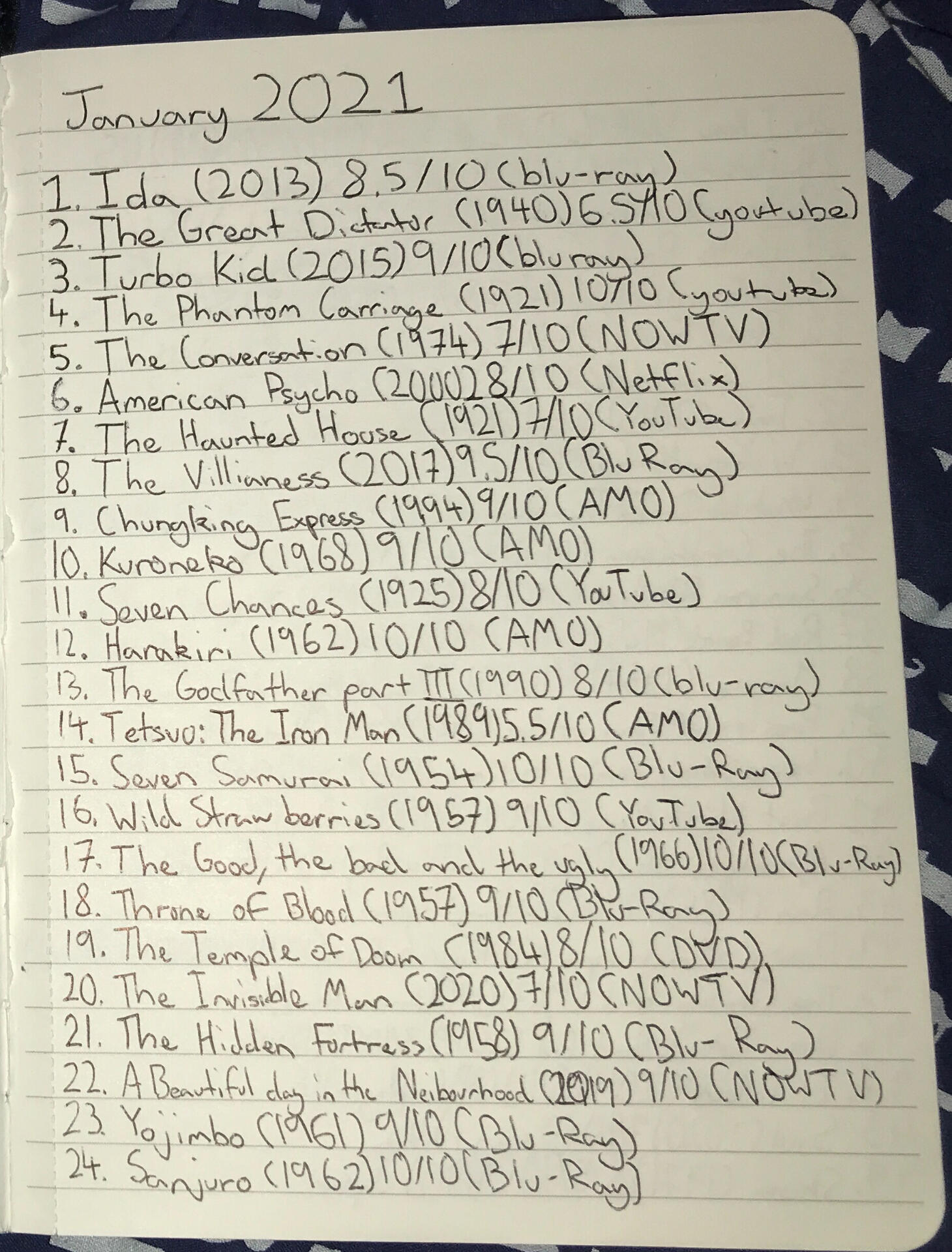
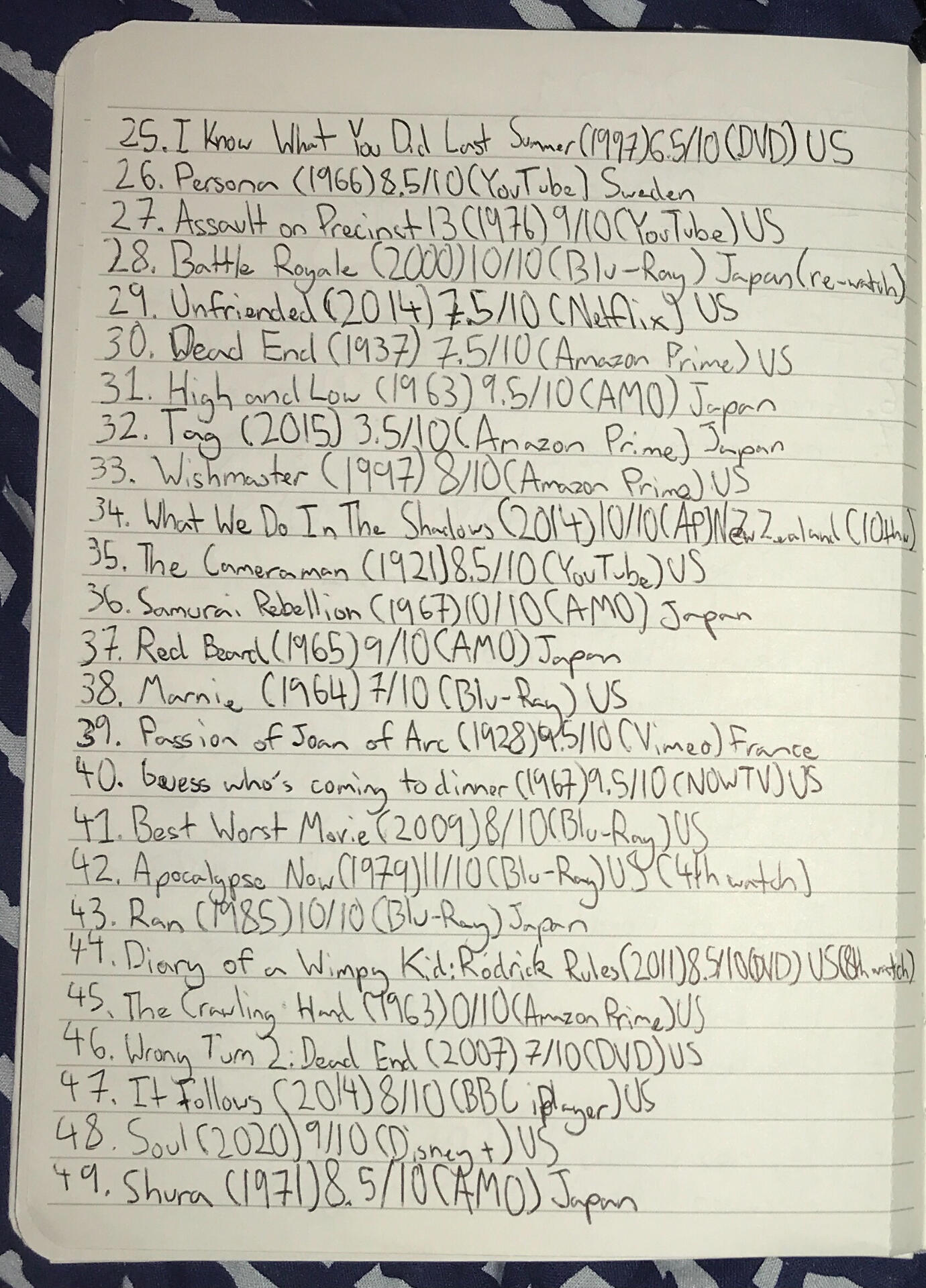
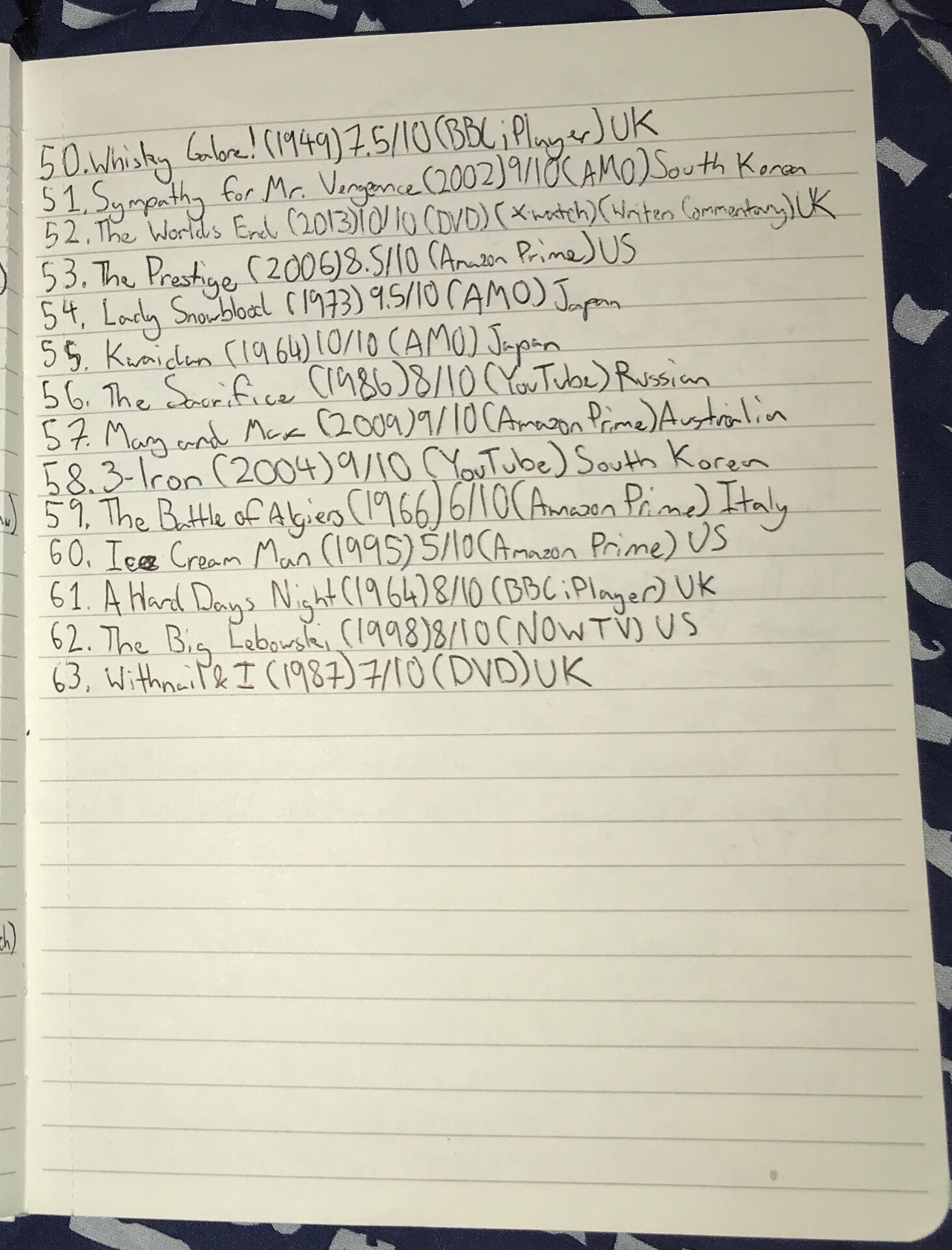
FEBRUARY
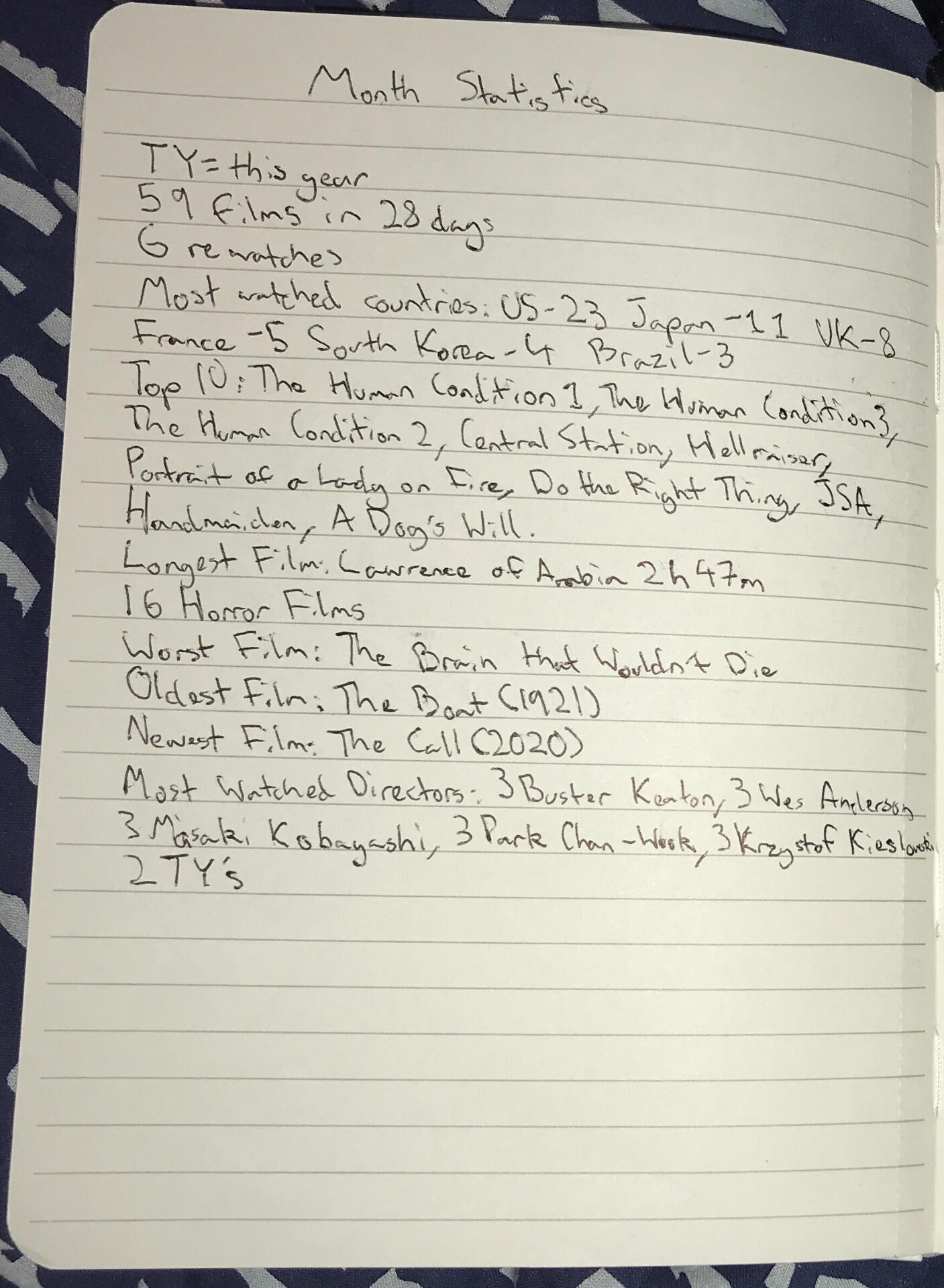



MARCH
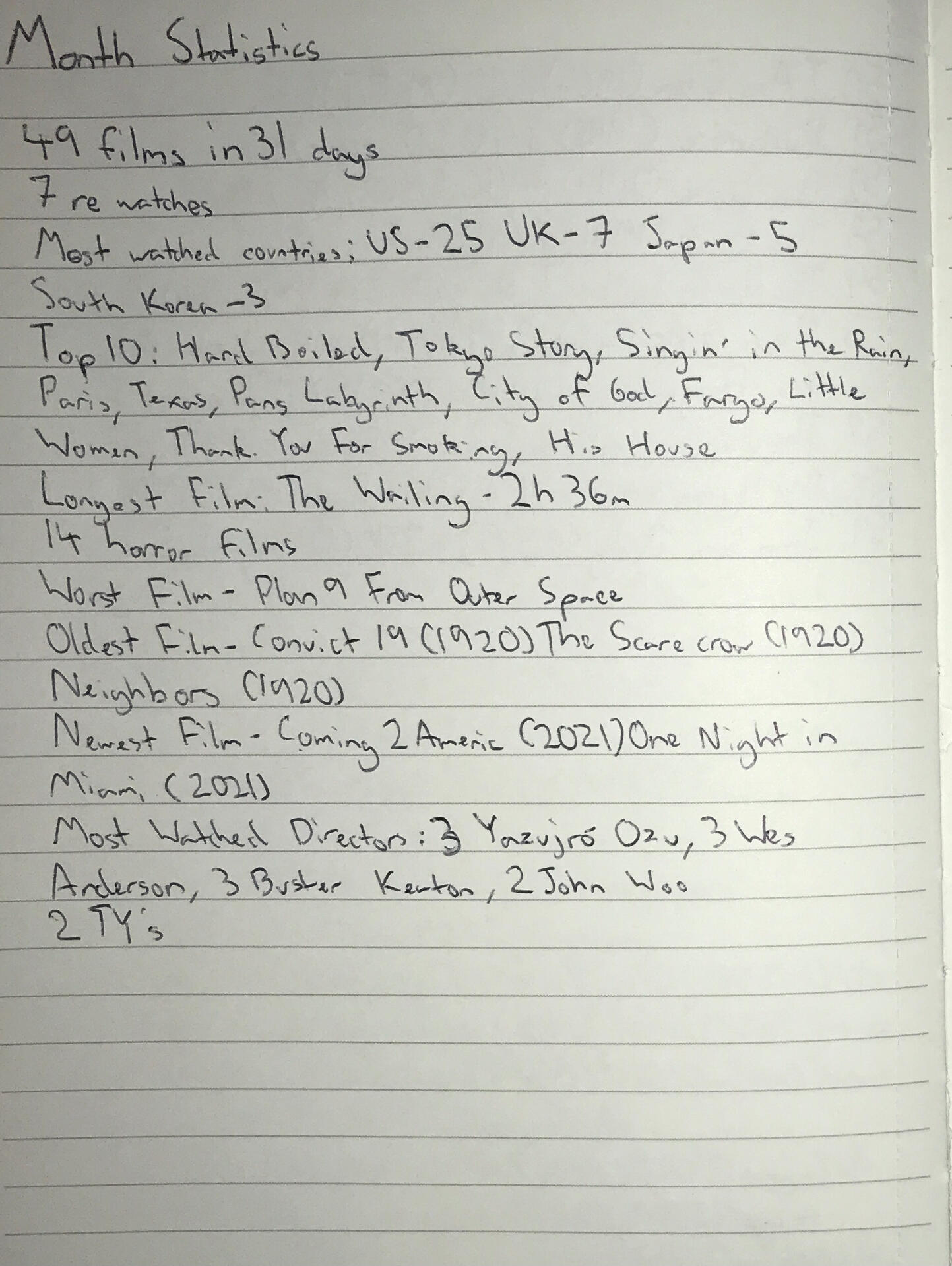

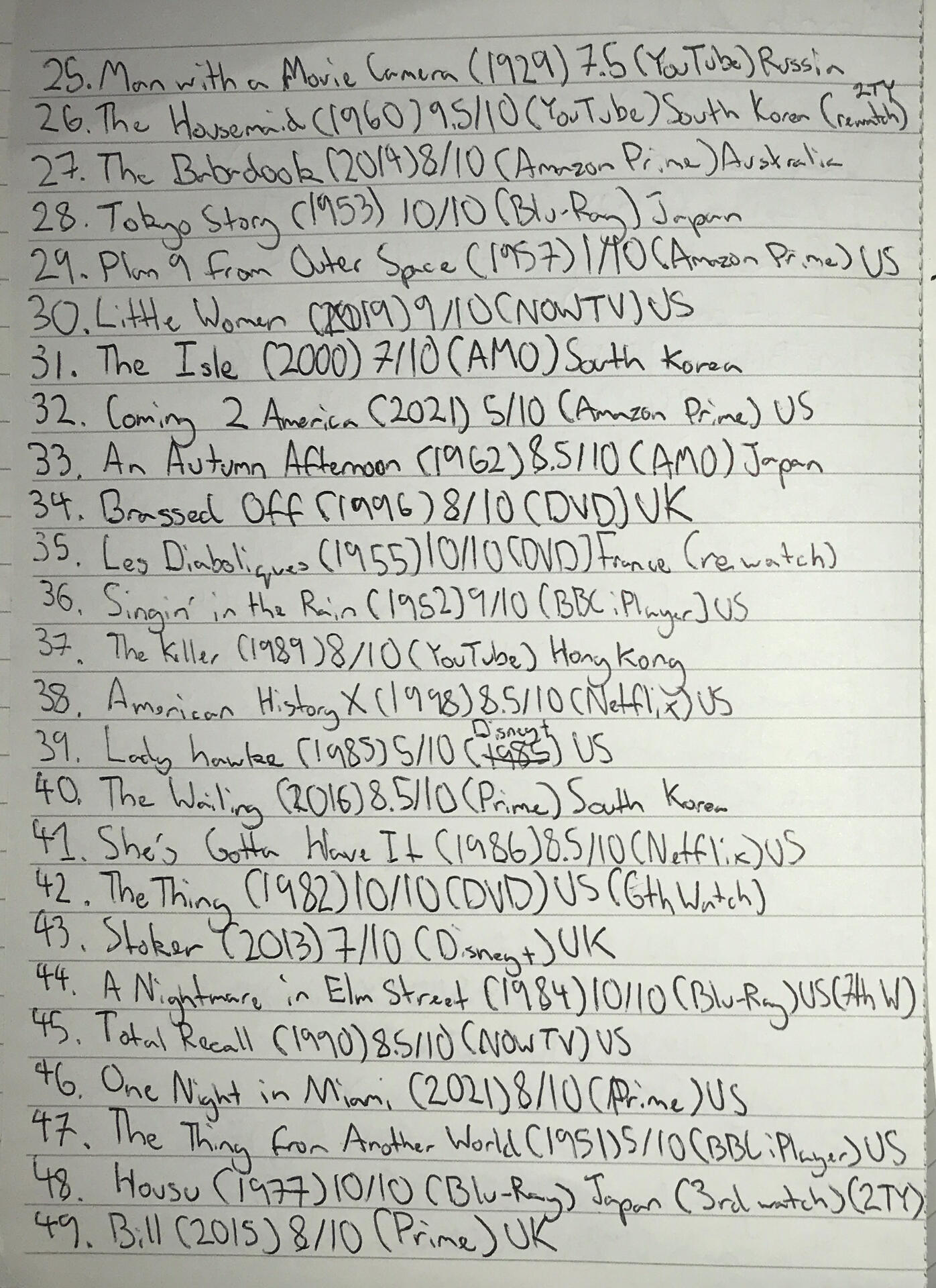
THE STATE OF SLEEP

It’s more than a safe bet to say that Akira Kurosawa is the most influential director of all time.I’m sure you could all give me a list of great filmmakers that have changed cinema from Hitchcock of the Golden Age to Scorsese of the more Modern Age of cinema, but I doubt you could name a single director working today that hasn’t learned a lot about making films from the Japanese legend himself (other than maybe McG and Michael Bay… how about we change it to name a great director working today). Kurosawa’s background has been one, much like most of the Japanese growing up during such harsh times, of tragedy. Born in 1910 he survived two world wars, Hiroshima and much much more. One interesting thing is that during WWII he was still able to make films. This was his early career and probably lesser known due to his fear of being political. That partisan sense of statement would arise later in such class questioning film’s as High and Low or The Bad Sleep Well where the legend would enforce political views to structure the narrative. However, he is definitely most well known for his Jidaigeki’s (Japanese period film’s). My personal favourite mini-genre of film where the fascinating and brutal age of Feudal Japan would produce such Kurosawa classics as Seven Samurai, Ran and Yojimbo. This would take up a lot of his filmography as he’d continue to refer back to Feudal Japan throughout his career never failing to make anything short of a masterpiece even as his films got fewer and fewer post-Red Beard. In 1985 his biggest film came to the screen and easily one of his best. This is Ran, the epic adaptation of Shakespeare's King Lear and arguably, his Citizen Kane. How would he follow up such a popular hit. Not only a domestic success but a commercial one. Loved by everyone across the world making him a bigger household name then ever. Well, he followed it, 5 years later, with what was not a safe bet at all…Dreams is an anthology film about… dreams. Kurosawa's own recurring dreams to be correct. It’s a film of transcendent beauty and also brutal nightmares. The film has eight awe-inducing shorts that can range from the delicacy of a blossoming peach tree to the fiery pits of an earthbound hell. The dreams seem to get progressively darker until a strong finish with a lighthearted beacon of hope. There’s no doubt that it’s not for everyone. It is strange and experimental. But I feel that the nature of it all stemming from the unconscious mind of Kurosawa helps separate him not just as a great filmmaker but an artist. A truly brilliant mind meant for the creative field of film. Whilst Im off dreaming about meglomaniactic Teletubbies shooting lasers out their eyes as they burn down Lazy Town, Kurosawa dreams of deep narratives that ponder the questions of life and art. Most specifically the Van Gogh short. Where a man seeking the famous artist’s inspiration gets lost in one of his paintings as the eloquent stimulus insights cultivated perspective of the surrounding world causing the man to descend into either madness or a whirlwind of creativity. At its heart it questions inspiration. It questions the power of art. It asks and asks and it’s up to us if it answers. The short anthological format fits it well, as we begin to get lost in the narrative just like the man did with the painting.All this is well and good but does Kurosawa's strange and risky passion project to capture his dreams of artistic lunacy come off like we are spending a night in his head? For me (and this won’t be for everyone as it’s a divisive film of multiple interpretation) it does so very very well. The images of odyssey and awe capture images that we never see in film elsewhere. The kind of thing only our brains make up and only Kurosawa can put on the screen. At the time of filming, the odd images being put to life must’ve been a worrying thing to film. Much like how, at the time, Star Wars was ‘George Lucas’s weird space thing’ of which no one had faith in and actor’s would just go along with because they got paid to, this film must’ve made no sense to anyone until it was cut. Only when the pacing, cinematography and visuals were perfected and then presented upfront, could us, like Kurosawa, be the judge of how dream-like and therefore successful the film is. But during production, God knows how many concerns the crew must’ve had about one of the greatest minds in cinema following up one of the biggest films in cinema, with some experiment coated in nonsensical crazy. Well they can all take a sigh of relief as it’s a truly worthy film in the master’s filmography.At the end of the day how do you create a film that feels like a dream. Dreams being this unexplainable and unpreventable mind excursion that happens every night without your permission. Well, it doesn’t really have to do with visuals or costumes, after all my teletubbie dream I referenced earlier might not even be achievable with today's effects. It’s to do with context or more so the lack of it. Something that Inception talks about is how in dreams you don’t remember how or why you are in this place at this moment but you are. In Dreams each short has a meaning to be there, some narrative progression and you might even gradually learn minor context without some narrated recap; like in the fifth short The Tunnel where we gradually find out about one man’s involvement in the war by him talking to his dead troops. But in general, these shorts are random and unexplained, they just simply exist and give off some emotion of effervescence or horror. Another film that handles this well is the otherwise flawed film Eyes Wide Shut, where the structure flows like one endless dream, or better yet odyssey of inhuman exploration. Much to Kubrick intent, you do feel as if you dreamt it up and imagine that is how the characters feel after the night. So does Dreams do this… yes. I can honestly say that I could’ve made some of the shorts up in a state of unconsciousness and would have to double check on IMDB to see if all the ones retained in my memory, where in fact what I saw on screen. The flow and originality of it all caused me to question its existence, as it exists in such narrative closeness to the thing’s I see at night and can only try to imagine in the state of wake. Has a film ever done that to me before… yes. I’ve seen House (1977) three times but still I’m not sure if it ever actually existed due to the sheer unconventional originality and craziness of it all from start to finish. So, what is a film that has had a similar effect on you?Dreams (1990) is a beautiful film, and I Highly recommend it.April 2021
A STIFF UPPER LIP

What do Brit’s pride themselves on. We’re not as patriotic as America, we’re not the most developed nation or the most happy. We have free healthcare… sure, that’s good. We have the most pubs in the world… that’s something. But what we really love about ourselves is our stiff upper lip. Our ability to handle bleak and mormon subject matter with a lighthearted approach. Our re-affirming sense of humour… dark humour for that matter, that separates our comedy from anyone else's idea of a joke. This is expressed in a number of art forms but ever present in that of the movies. Today is as popular as any time seeing TV shows like The Inbetweeners, This Country and Friday Night Dinner, and before them Gavin & Stacey, Outnumbered and The Office, and before them Blackadder goes Forth, Bottom and The Vicar of Dibley, and before them Fawlty Towers, Only Fools and Horses and Monty Py- you get the point. British TV comedy has developed as a big a cult following as the latest American sitcom with loyal and well-humoured viewers that really respect and appreciate why our humour has an added aire of both brutality and sophisticated brilliance that transcends the explicit slapstick also present in these shows. But when it comes to film, the recognition has always been slightly less than that of USA. This only show-casing how much more audacious our humour is, and how much harder it is to get unless you have a bit of a pessimist within you. The Ealing comedies of the 40’s and 50’s are a testament to both slapstick and clever humour perfectly showing the roots of British comedies today. There would be not the delights of Edgar Wright, Bill Forsyth or Paul King without these founding fathers of the genre. So how does Kind Hearts and Coronets display the ‘stiff upper lip’ of our priding sense of humour…Kind Hearts and Coronets, from the outset, looks like a serious film. Where a man awaiting his execution, recalls the tale of how he got there. But any chance of it being a tear jerking installment is abruptly interrupted by a satirical series of death-tallying events contradicting the dark theme of murder. Given time, this film becomes a tear jerker in a whole other way. Telling the story of a boy who’s a distant heir to dukedom, but 12 deaths away from the title. His mother, from marrying for love instead of wealth, is forced into poverty and ostracised by her family leaving the man with no choice, after the mothers abrupt death, but to avenge her and earn his throne. What started off as a sophisticated and genuinely intriguing use of pathos to build our liking for the main character becomes a strangely comic adventure to juxtapose what is truthfully an undeniable bloodbath. You’ll count the kills along with the film as a once struggling beggar murders his way to the top, scheming and more importantly executing. The way it handles such a hard-hitting and, in all honesty, psychopathic diegesis is truly original. We see it play out in a very surface level and unexaggerated manner that humorously romanticizes something extremely disturbing. We continue to gain pathos for the protagonist even with his sins in the back of our minds. This still being interesting now, it must’ve been a ground-breaking shocker for ‘49 in how dramatic irony can make us brush past such heavy subjects. Influencing the treatment of anti-heroes in film; ones that come to mind are the interesting ideology of Thank You for Smoking and the truly disturbing psychological manipulator that is A Clockwork Orange in which we enter the mind of a psychopath and, over time, come to almost feel sorry for such a horrible human. It’s this glamorised brutalism that separates this comedy from other Ealing installments like Whisky Galore. However, The Ladykillers and The Lavender Hill mob would take a similar sympathetic antagonist approach but still in a less moral contrasting execution to this one.However, one of the things about comedies is that it can age poorly. As the culture or drama of the period will affect the message of the satire. Comedy could be used as propaganda to get people talking about a hidden or explicit issue, much like the audacity of Charlie Chaplin's portrayal of ‘Hynkel’ in The Great Dictator or Stanley Kubrick’s bold war-crime comedy Dr Strangelove, that tests the destructibility of political power. How it can age poorly, however, is with common opinions that would pass as harmless jokes then, but forward thinking modern audiences would’ve grown desensitized to with the increase of awareness about the cause. Although this particular film has aged well in quality - making me laugh out loud and be impressed by the elaborate plot - it did have some inexcusable racist language. Much like a moment in a film I find otherwise hilarious but can’t bring myself to love because of a certain racist joke: Seven Chances. When Keaton must marry a woman before seven o’clock. He goes after a girl from behind but then realises he made a mistake when seeing from the front that she is in fact black. It would’ve got a quick laugh then but cannot be justified now and for reasonable measure. Comedy can take advantage of sensitive issues, prying off of discriminative segregation in one way or another that are within the bounds of current reason, and if humanity (hopefully) continues to become more and more tolerant and inclusive, we’ll look at the comedies of today and face palm in humiliation of how ‘this joke’ was then within the realm of acceptability. These outdated moments are part of the film and help remind us of how far we’ve come in the decades between. A big flaw when it comes to watching classic films is both the lack of cultural representation and presence of insensitive language. But as long as we continue to evolve and be less and less ignorant, Hollywood will soon become a place of tolerance not bias, and comedies will never age poorly again. Unless the film’s just shit.
THE FANTABULOUS EMANCIPATION OF ONE HARLEY QUINN

I came into this film expecting to like it. Don’t get me wrong I hate the DCEU with a passion. Aside from Shazam I haven’t liked a single installment but I’d heard this film is new, fresh and innovative. But what I got was pure unadulterated love for the feature for so so so many different reasons.First let’s discuss where the DCEU is at and why I hate it. Ever since the brilliance that is Christopher Noaln’s Dark Knight trilogy, it’s unintentionally and regretfully spawned a new approach from DC that has failed miserably in it’s latter years. For the first time these aren’t comic book film’s, these are serious action-crime-thriller type films, just with well-too-known superheroes in them. They started Phantom Menacing it, constantly showing the boring courtroom drama sides of the universe that nobody asked for and came out as pretentious BS. They start overexposing how the big names of DC fit into the conceivable real world instead of what these fictional characters should exist in, which is what this film (along with Shazam) finally realises. These aren’t supposed to be realistic, mundane film’s, these are crazy superhero films… comic book films! We don’t need to see half of what Batman vs. Superman or Man of Steel is showing us; this dull “accurate” take on what would really happen if superheroes existed no, they need to take a deep breath and realise that this isn’t a serious realistic genre. And they did. Hence Birds of Prey. This film is insane and it knows it. The craziness is revelavent completely to Harley Quinn who successfully embodies genuinely now my favourite DC character. She’s quirky and wild and you can tell it speaks to many teenage girls out there alike who know or are that girl. I'm not a 13 year old girl… at least not last time I checked I’m not, but I could both see the target appeal and find my way in there as a lover of this masterpiece. Long gone are the day’s where DC and Warner Brother’s would hire well-known directors to restrain, and make the next generic, uninspired trace of the last installment, and lo is this renaissance of superhero films where features like David F. Sandberg’s surprisingly loveable and all round brilliant Shazam, Todd Phillips problematic yet none the less original and bold Joker and branching into Marvel here Taika Waititi’s Thor: Ragnarok and the incredible Spiderman Into the Spider-verse are finally hitting the screen like Harley Quinn driving a truck into a chemical plantation. Birds Of Prey being my favorite (DC-wise), where the DCEU have just handed Cathy Yan, Christina Hodson and Margot Robbie all control to make whatever they want instead of something to fit the tedious unlikeable agenda of its miserable predecessors. And you can tell it’s their movie.Not once did I think this was anything spawned from the shitshow that is Suicide Squad, or was I constantly rolling my eyes at desperate references to the comics/ films before. Because there weren’t any. Even Margot Robbies incredible performance as Harley Quinn that could’ve easily become one-note, made me feel as though I’ve never seen the role in any other film, being so removed from the sex object she purely was in the film’s before'' (despite her acting still being the best part of Suicide Squad). Infact, the small scene where we see a slight flashback to Suidide Squad and the one other momentary reference in conversation where my least favorite parts of the film as it reminded me of it, but even those moments, despite briefly depressing me, where relevant and justified. About Cathy Yan’s directing I think it might’ve been the boldest and most successful in any DC film... ever. It moved at a Goodfellas pace x10 with fantastic and not-annoying (which is rare) main character narration. The visuals were unique to say the least and I was never lost in plot nore my attention lost in the mix. The constant insanity didn’t ever temper with the narrative as, although spending and hour and forty four minutes in Harley’s head, dealing with the characters and situations in an Amelie type bias, it didn’t forget to breathe and have those visceral moments of pathos for the deep and complex main character(s). This development and level of openness when it comes to the characters is what made this, in every sense of the word a perfect ‘emancipation’ from the ties of the Joker who admittedly everyone is sick of now. So sick of his credit that it was nice to hear him constantly referred to as ‘Mr.J’ - too tired of even hearing the name. Margot Robbie gave the performance of a decade as the previously less discussed anti-hero who you really really love and really really find funny throughout. The confidence they have in the cast and crew here really shows, and proves how the future of DC should be (looking promising with the trailer for James Gunn’s The Suicide Squad, which looks just as fun).Wonder Woman came out in 2017 and, to put it simply, did it wrong. What was aimed to be a feminist statement failed in almost every way. Their efforts were at least better than the MCU, by not waiting till Phase 3 to put in a female lead, but still it was a poor poor attempt. It has Gal Gadot play a thin model of a hero who’s entire arc orbits around her crush. She walks off without a scratch and without independence from the male dominated superhero film industry as well as doing nothing for female empowerment other than DC being passed of as ‘technically not sexist because theres a female lead’; but when the wool of those headlines is lifted from their eyes, it’s nothing but ‘white feminism’ having a zionist play the Amazonian lead with the makers not having the confidence to make her anything more then an undamaged model with no muscle. This is where Birds of Prey exells. It is a feminist advancment (the elongated title is pretty self explanatory of that) but it doesn’t at anytime feel like some hopeless ‘statement’. It doesn’t have desperate undertones of female empowerment as the foundations for its existence, it just exists and shows that you can have a female lead without romanticizing every element of a Superhero flick with a regular male lead. Unlike that face palm moment in the otherwise incredible Avengers: Endgame where all the women decide to randomly gather midst intense battle and pose for a minute, it’s not forced. In Fact, in the ending scene, when all the main character’s are together with the threat of Ewan McGregor's army, they are all women, and have all come full circle enough for it to be unnoticeable. This is a rare and great achievement for any franchise film better yet one as male dominated as the comic book universe. Infact, one of my favourite scenes of the film is when Harley Quinn (accidently) inhales some cocaine and beats up a squadron of armed men - violently may I add. It’s not some cheap move where we’re surprised that a woman is doing this (like in many many other film’s when the one female outburst of violence is met with shock or comedy) it just feels like you're watching any other action film that doesn’t hold back to be as brutal as possible. In stark contrast to Wonder Woman, she gets beaten the hell up too and not in the least gracefully. It’s clear that these moves are no longer put to waste serving Mr. J but now making her every bit as iconic and bad-ass as the next Batman villain. So brocken from the shackles of her poor characterisation and aestetic in Suicide Squad.Other than how it will impact superhero cinema with DC in a possible renaissance and a normalization of female leads without it being some big deal, I’m gonna now talk about why I like the film on it’s own. The cinematography is incredible. Shot by the legendary Matthew Libatique (Pie, A Star is Born, Requiem of a Dream, Black Swan, Iron man). No shot is dull or unmotivated unlike other DCEU film’s - with the visuals only eagerly supporting those images drawing off of the break-neck brilliance of Spider-verse’s visual audacity. All the cast were great - I’m not going to anymore talk about how excellent Margot Robbie is or this will be a book-long review, but I didn’t dislike any of the main cast at all. There were some that I thought I would get annoyed by in their exposition but ended up supporting and wanting to live through it all. It’s unique and quite bewildering that they all (other than Harley Quinn obviously) have only just been introduced but are all already developed enough for me to be intrigued in the ending battle. When they all team up as well, it’s not cheesy or misplaced, it’s relevant and necessary. The soundtrack is pretty great, managing to range from retro to modern with all of the lyrics being very apt in context. Ewan McGregor, one of the only important male characters, played a solid villain, a mix up from his usual roles and handled very well. Any complaints: thinking about it, I actually don’t think I have any. There wasn’t a moment I disliked or felt out of rhythm (which is hard to do considering how mental the feature is. Even the sillier plot points were justified and endearing. Infact, if it weren't for the Dark Knight, I think this is the most playful, original, enjoyable and lovable DC film adaptation and, although I only just watched it, my second favourite. So to wrap it up I was expecting to like it… but I can honestly say that it took me by surprise in being a complete and utter masterpiece.'' A negative thing that has come from this film is the response from certain pervy older men who were annoyed by some of the things I highlighted about her being less of a wide eyed schoolgirl in this. They added certain burns to her and scratches (due to her falling in acid or whatever) and this has really pissed some people off. Only showing that there are still issues with female leads in these films when it comes to the media's response and hopefully in future years this will change.April 2021
THE OMNIPRESENCE OF FOOD

With Juzo Itami’s Tampopo I am faced with a challenge of how to review this. There’s so much thematically and tonally to explore in this feature, it being an extremely style over substance narrative and all, that it’s hard deciding where to start with this chaotic movie.I went into it expecting a straightforward story and I was granted one until about 20 minutes in and, to the benefit of those with extraordinary short attention spans, it shifted to be an almost anthological endeavour. This is by no means an anthology film, but it is, of sorts, a broad and inclusive look on the theme (quite obviously) of food. We see many different vignettes of people's lives and how emotions or actions are influenced or nurtured by food. Like the saying ‘some eat to live and some live to eat’ this film harbours on the latter and expresses an appreciation for the omnipresence of food for everyone. Poetically, it shows food as an enriching part of life and death, with a woman's last act before departing the earth is cooking her last meal for those she loves at her deathbed, and the initially confusing ending shot of a cradled baby having his first source from his mothers breast. You can really tell what you're getting into with the very opening, where a gangster and his partner go to a cinema with a whole picnic breaking the fourth wall and telling us what we should and shouldn’t eat whilst watching the film - these are the only other returning characters in a separate narrative. Throughout we see other expressions of such. Food as an expression of love, or a manifestation of temptation or lust. We see it sensually as kink in a scene where you’ll never see an egg yolk the same way, but too we see it ritually as a ceremonious act of comfort for the early and iconic tangent where an elderly Japanese man teaches a young spectator how to properly eat ramen. At the film’s heart, we centre primarily on the character’s of Tampopo and Goro. The former being an aspiring professional chef despite having a failing noodle shop just waiting to be covered on Kitchen Nightmares - but Gordon Ramsey swearing at a time-wasting chef is substituted for a passing truck driver Goro, who, although not a professional, knows how ramen should be cooked and the shop should be ran.This overarching relationship is where this constant theme of amateur and professional comes into play. As the quote is said in the film “people who eat ramen are all amateurs” the word becomes superfluous to any ranking of hierarchy, as at this film’s center, the status of amateur (or shirouto as it is here said) is merely the appreciation and understanding of something as universally nurtured as the thing that’s keeping us alive. Much like the wise old man imparting wisdom of how to properly eat ramen (which has for sure forever changed my routine) we see he is the experienced one who has a deeper emotional connection to that specific food. It is clear Tampopo want’s Goro’s critique and training as an experienced ramen lover, but what we come to learn of Goro is what he needs from her - the aspiring professional. Tampopo’s lack of ego and arrogance is evident in her immediate acceptance of Goro’s critique (harsh critique at that) and eagerness to improve. She learns to appreciate the little things and truly becomes an ‘expert amateur’ before and expert professional. What he learns of her is why the vignettes of others are present. As someone outside the field of food, he once again sees the art and craft as well as binding qualities and transgression that food brings out in people in enigmatic mind-wonders that we can all theorize whether they are in his head or not. That’s besides the point, Itami puts the main narrative on hold to show the enriching experience we all have eating, beit we’re chefs or tasters we are all amateurs in the sense of our admiration and inevitable thanksgiving; once the credits role and our minds are made up, we come to realize why the wise old man in the first vignette gently strokes the ramen as a sign of appreciation, is it something we should all do for all food; but the point is his level of affection transcends how we might take the little perks of food for granted. It’s clear this is a love letter to food, but any film of such nature is too a love letter to cinema’s capabilities in capturing Itami’s clear heartfelt expression in an unconventional and entertaining way.Message aside this film is pretty crazy. It’s impossible to pigeon hole among its predecessors and successors but I think it’s safe to say that it’s showcasing of Japanese insanity is much to the taste of the 1977 classic by Nobuhiko Obayashi Housu that also massively favors theme over story. However, in moments of genuine narrative strength among the main diegesis, we do see powerful and heartfelt scene’s that earn its reputation as a Japanese cult classic. For example, the powerful climactic taste testing scene in which Tampopo’s transformation is finally assessed by her amateur and professional peers had me reminiscing in the influence of Sergio Leone. The way something that isn’t visually compelling can be ameliorated into something of high tension and page turning quality is indebted to that of the iconic duel in one of my favourite films ever ‘The Good, The Bad and The Ugly’. Juzo Itami’s dependence on the music and shot composition as well as contextual impact to deliver a mundane situation in a ‘hold-your-breathe’, nail-biting manner is brilliant and one of the less craze dependent qualities that makes this film excellent. It’s tagline humorously helms it as ‘Japan's first noodle western’ or better yet ‘ramen western’; I feel this is a fair synopsis considering both the influence and techniques of rivalry and consequential development, on top of the outlandish moments of familiar parody. This ability to wildly dramatize something like a ramen taste test in the same manner a gun duel would be shot in the best western of all time, has been parallel throughout future cinema.That’s all for today. Tampopo is a brilliant film and if this perked your interest I’d definitely motivate you to watch it by any means possible. It’s comparison to Housu is justifiable but also not accurate as; and I speak for all Housu fans when I say there can only be one Housu, if there was another the great chain of being would be disrupted and chaos will be released into the world. Still, Tampopo is none the less fun and thought provoking as well as heartfelt and mesmerizing. Best enjoyed with a hot bowl of ramen (of course) or just on a full stomach, I made the mistake of eating after and couldn’t have been hungrier for the duration.May 2021
THE CONTEMPORARY VAMPIRE
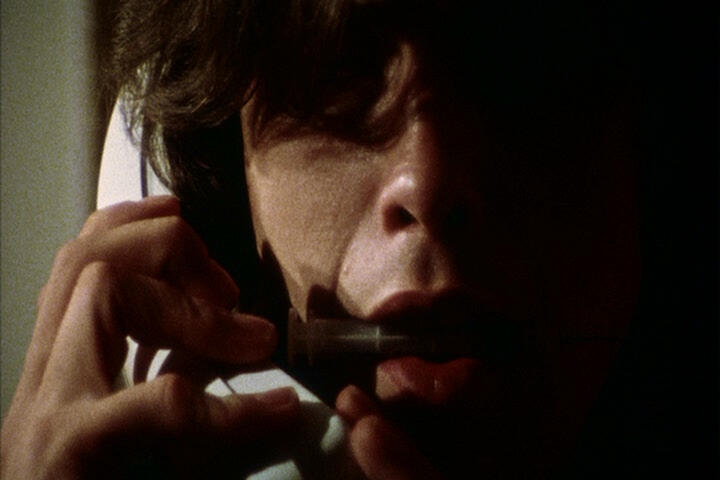
George A. Romero is one of the most important directors that doesn’t get nearly enough credit for it. Lesser known most likely for the fact that he’s a horror director which rarely makes its way into the light of self proclaimed ‘cinephiles’ Instagram feed, but nonetheless worthy of praise for what he has done.
His most impactful film is the the most game-changing directorial debut since Orson Welles inception with Citizen Kane. Night of the Living Dead was not only the film that single-handedly invented the modern zombie but was the smash hit that made western horror films scary. Before which, synonymous with Science Fiction, it was the laughing stock of Hollywood as filmmakers hadn't truly figured out how to scare an audience. Films like The Fly, The Thing from Outer Space and most memorably Edward Wood’s Plan 9 From Outta Space stapled the silliness and lack of sincerity when handling both genres. There is a plethora of foreign film’s from that time that creep audiences still today, most notably one of the scariest films ever made Les Diaboliques by the true master of suspense: Henri-Georges Clouzots. Japanese film’s like Onibaba, Kuroneko, Demons and Kwaidan hit the screen, as well as newly introduced French cinema of which managed to deliver Eye’s Without a Face the most audacious film in terms of gore of it’s time (the face surgery scene is still effectively horrific). Psycho, of course, was an anomaly of terrifying greatness but NOTLD was the first American horror film to grow a pair. If you read up on (and I recommend you do) Roger Ebberts initial reaction to the film you’ll see how lot’s of children were in the audience as parents wouldn’t see horror as any kind of threat, just a fun genre to laugh at. But with this new ‘silly horror flick’… Daughters viciously killing their mothers… bone-gnawing, flesh-eating scenes of downright cannibalism… the dead coming back to life handled in a sincere and disturbing way…it’s far from family fun. Being the first real zombie film I feel as though it’s the only installment of the aforementioned genre that really grasps that concept of the undead and lives for it. Then to follow it up with Romero’s true masterpiece Dawn of the Dead which I could spend hours talking about, and following that up with one of the juiciest zombie films to date: Day of the Dead. Delivering us all the blood and guts Savini’s got bursting from his loins making the quintessential horror trilogy that I’ve had the blessing of recently re-watching. Yeah, Romero is an important director, and maybe even the best the genre has to offer (sorry Carpenter).But today I won’t be talking of the Trilogy of the Dead, nor his other misunderstood classics (Season of the Witch, The Crazies, Creepshow). I will be talking about his one and only vampire flick to my knowledge: Martin. This film was both Romero and Savini’s first collaboration of many and Savini’s acting debut. His character is fairly sidelined in this but it’s a nice performance nonetheless. This was his third film doing effects on and it’s not a blood-dependent film at all. Sure there are some nitty-gritty wrist slashes and head bullets but this is a rare delight from Romero where he is left with nothing but his directorial vision to capture the audience and maintain them in a state of shock for the runtime.The opening ten or so minutes is genius and perfectly sets the scene. Despite the conductor's opening conversational dialogue, the film’s opening section plays like a silent movie. Romero gets straight to the point and shows us all we need to know and nothing more. Crash shots of Martin getting a needle out, then entering a room in hopes of sedating a girl. It’s disturbing and tense with a bloody, unsettling pay off. It’s clear this film isn’t messing about, and this Martin dude ain't your average Joe. This could come down to Romero’s original work in advertising. His commercials were well known for their ability to be quick but have a genuine well-paced narrative. Especially in Dawn, this is so. Every shot is essential in delivering something and doesn’t ever outstay its welcome. In relation to the opening, it’s eerie and sums up what kind of film you're watching. A tense horror thriller that will stay with you long after.Honestly, I couldn’t keep my eyes off the screen for all the murders throughout. They’re all so well executed as Romero takes your expectations and then bites them in the neck to turn them into a nightmare of their own. The sequences of violence will slowly but truly get worse and worse for both Martin and the victims, displaying that trying to get some blood for a snack isn’t easy in this contemporary age. Infact, one of the things I admired most about the feature was its unique handling of the modern configuration of vampires separated from the old-fashioned mythic approach. We consistently see scenes of the world this is set in to replicate certain moments from Martin's long past, as a sequence might briefly show you those original actions play out in a distorted capture of many years before only to bring you back to the diegesis’s current setting. This was a good way of directly contrasting vampire stereotypes to highlight Romero’s unique approach to the genre. It respects the style of film’s like Nosteru by almost playing homage to them with a new lens.My favourite moment is a botched lunch time for Martin. He goes to a random couple in hopes of draining the female's blood anonymously after sedating her (his method). But instead interrupts an affair and all hell goes loose. His shocked lapse of judgement causes him to act out and ruin his plan further leaving the lovers having just seen a random man enter with an injection and run off for him to now sort out. Martin further tries to foil their attempts to call the police by stealthily messing with the phone lines and keeping a watchful eye on their response to the encounter - the woman also doesn’t want to call the police as her husband will find out about the affair. Heavy stuff, I know. It’s handled beautifully and will keep you on the edge of your seat. The moment after is just as mesmerizing. His clearing off his tracks are played over the audio of him talking openly about being a vampire with a radio station. The way his inner monologue is intertwined with something so simple but well shot had me reminiscing of many sequences alike in Breaking Bad - most notably when Walt and Jesse are cleaning the remains of a dead body whilst a science professor teaches over the top. It gives the images a greater depth when we see them. We feel as if what he’s talking about is what’s going on in his head as he sorts everything out. It’s brilliant how the actions suit the word showing the messier parts of being a vampire as he complains about the subject in post to the event. He talks about the loneliness of it, his lust for love, wanting to be in bed with someone not having just drank their blood. It becomes a visceral character study for Martin, who is truly a man with normal lusts and erges, just tied to the bounds of a misanthropic lifestyle. It’s what sets this apart as a genre-free masterwork and that’s never bound by any consensus of what a Vampire film needs to be or have in constitution. It distorts reality as well as subverting comfortable expectations into fifth gear.Watch it and thank me later. Remember the name: George A. Romero - God rest his soul.
A DAUNTING AND MESMERISING PRODUCT OF WEIMAR GERMANY
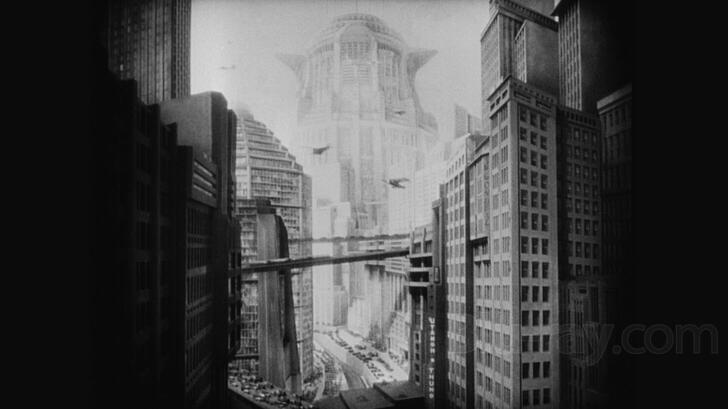
Metropolis was made in Weimar Germany when the concept of democracy was newly introduced to German citizens after the dictator Kaiser Wilhelm II ruled over the fresh, new country until abdicating in November of 1917 (no that wasn’t copy and pasted, I recently had my History exam on Germany). In that time, much to the distaste of the Nazi’s, there was the Bauhaus movement that completely remodeled German architecture to look more modern and lively. There were nightclubs opening playing western Jazz music with drag shows and even sensual entertainment. This was all because of this new idea of freedom of speech that allowed everyone to express themselves however they wanted and an absence of dictatorship led to less censorship. However, what I want to dwell on here in context to the film in question, is the architecture that changed Germany into looking more ‘modern’ and ‘avant-garde’. More simplistic and neat but often strangely shaped, futuristic designs plagued Germany into looking like a Ralph McQuarrie sketch. Why is this relevant? Because science-fiction is always a projection of it’s times and this one has aged very interestingly. It’s taken the Bauhaus design and made a work of art that is almost like a pitch for new housing in the most ambitious and extreme sense. The film uses effects that don’t look at all silly or over-the-top fake but nonetheless over-the-top futuristic. However, instead of ending up a slide show of ideas for a fun modern aesthetic, it uses that to tell a beautiful story with a heart warming message that was close to-home-then, and sadly still is now.As a total contrast to the beautiful landscapes that you’ll recognize everywhere in today's fiction from Queen’s Radio Gaga music video to Blade Runner 2049, it shows the behind the scenes that makes that possible. A messy, polluted and inhumane underground class of workers who live off of poor wages and harsh harsh conditions. The element that was very personal to Germany at the time is to do with the Great Depression. With the inflation crisis earlier in the decade making it impossible for the working class to eat even with wheelbarrows of paper money, and mixed with the Treaty of Versailles reparation clause that put Germany even more in dept, life was tough to say the least, and the illusion of a lively, high tech atmosphere instilled hope and happiness in the working class. Not to mention that the story is essentially a communist manifesto much like Battleship Potemkin, demonizing the rich assholes at the top and telling a biblical tale of unity. And I mean biblical. You can see the character arc of Freder Frederson mirroring Moses realising that he is slave-born then walking among them and subsequently freeing them. It’s one of those film’s that you feel have too enchanting and original a plot that you dig around for an earlier tale it must’ve been remade from, but no, this enchanting beauty of fiction was a product of Fritz Lang and Thea von Harvou only, which is bewildering as one of the strongest entries into what was then the ‘experiment’ of film. It must’ve been an early sign that cinema was only going to expand and become one of the most culturally and socially important parts of society around the globe as well as an early example of art imitating life before that began to switch around and become life imitating art. It’s so recognisably original that I feel it could be adapted among every platform of art from theatre, to novel to even ballet. It being a silent film did a great deal in having it flow naturally and almost stage like, to the point where I fully felt I was watching it in a theatre, and it’s a timeless experience everyone should have.Let’s not forget, as personal as this may have been to it’s time, it’s still Science Fiction and, from what I’ve seen, it’s the first great one. Earlier dables in the genre like Le Voyage dans la Lune where played purely for laughs, this one didn’t muck around and, amongst the communist subtext and Weimar agriculture, it managed to lay down the ground rules for what all Science Fiction should be: scary. Not in the conventional sense of zombies and vampires but in the thought provoking sense that plays off the unknown and relates to our own societal fears of each era. At this time it was deeply rooted in the Working class German’s fear of collapsing under the pressure of the Great Depression. Becoming subjected to slavery conditions in order to maintain the good looking avant-guarde illusion that is seen by the world, as they work to project that at the expense of their happiness and health. It does this in the background of a story about the son of the oppressor trying to solve the problem of inequality whilst an even scarier tale of family is told. The boy’s late mother ‘Hel’ (the name would later be removed for being too closely associated with the English word for ‘hell’) is being re-animated as artificial intelligence by the creepy figure of Rotwang. This is the image most will be familiar with, of her rising from her C3PO looking shell and walking as a human. The machine will be used as a toy by Rotwang to collapse the upper class but that will also result in tragedy for the working class as their world is slowly flooded. Hel will make the most iconic and haunting images of the film that still frighten today, and have influenced many science fiction films like Spielberg's A.I.All this proves that this film is the grandfather of Sci-fi, creating the abstract aesthetic for the future used in everything from Back to the Future part II’s humorous depiction of 2015 to even the 90’s Simpsons predictions of today. It can be interpreted as a desperate message from German’s about their thoughts on life in Germany or purely a time capsule of it’s culture. This is an essential piece of cinematic history that was only uncovered in full 13 years ago after many years of Nazi subjected censorship and shortening due to immediate criticism of it being ‘too long’. Don’t put off watching it because it’s old or long or silent or foreign, it’s the definition of a must watch.
IGNORING THE LAWS OF CINEMA
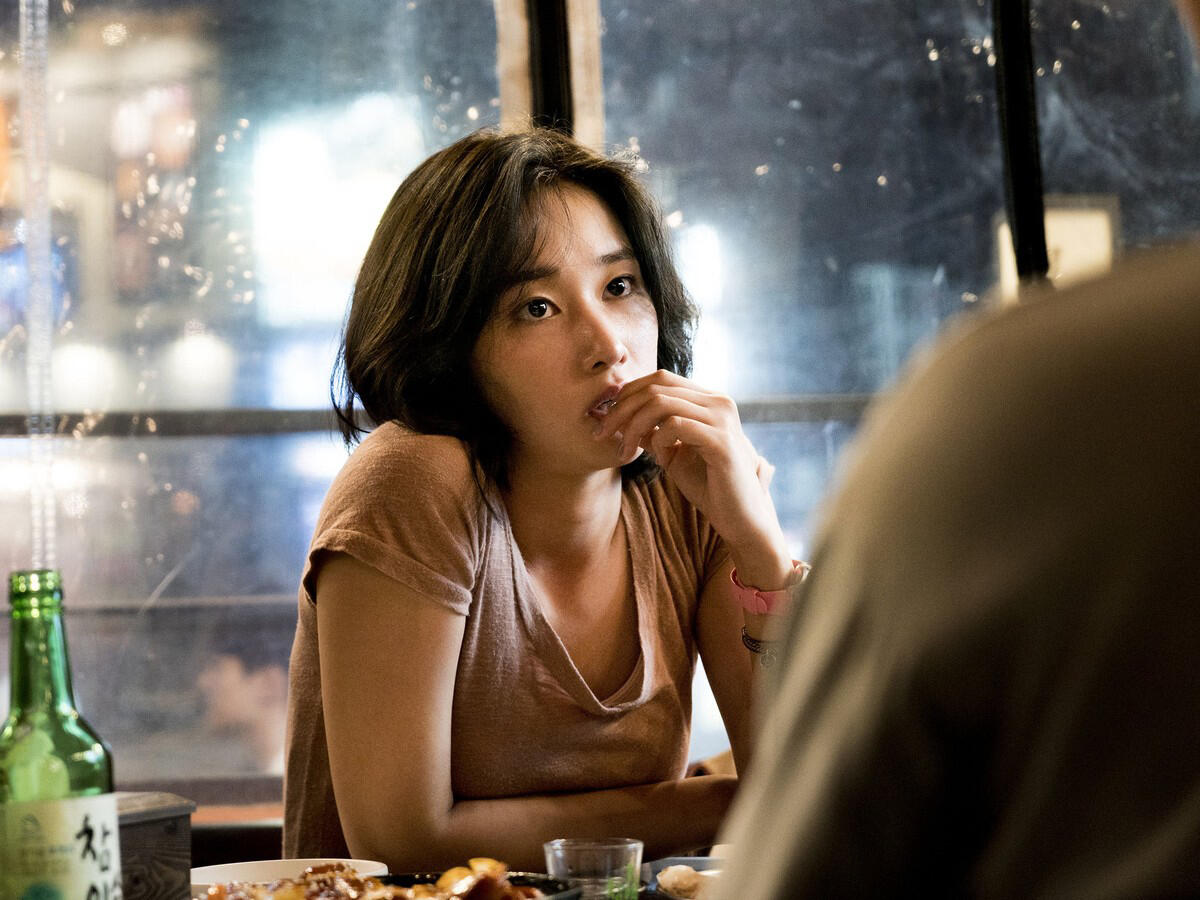
For a long time I’ve been anxiously anticipating this recent thriller, and I’m happy to say that I still have only once not enjoyed a South Korean film amongst the 30 odd I’ve seen from South Korea. Burning, in fact, may have even breached into the top tier of Korean flicks I’ve seen, amongst the better film’s in the filmographies of Bong Joon-ho, Park Chan-wook and Kim Ki-duk. Which was a shock to me, but it truly is one of the most unique films I’ve seen in a long time as well as the first 10/10 film I’ve seen since I gave that honour to Women in the Dunes over a month ago. But why did this strike such a chord with me…Well from the cover, the reviews, the cast and even the director who I knew previously from the underrated anthology masterpiece Peppermint Candy, it looked like a fun thriller reminiscent of other Korean thrillers I’ve seen. And yes, I wasn’t mistaken, it is a thriller. A mystery more precisely but it doesn’t quite have a usual structure we can grasp or a plot even, that usually makes a thriller. Nothing is concluded or even set up enough to come close to a conclusion. It’s a murder mystery that might not even have a murder, a love story that might not even have a love connection, a film about looking after a cat that might not even have a cat in it (intense, I know). The way it achieves this unique presence is by consistently hypnotising you into a state of familiarity. In the ‘slow’ first act we get so comfortable with everything. The surroundings, the protagonist, the situations… everything but the enigmatic character of Haemi who remains an enigma throughout. The only thing that makes you sit uneasy and leaves a strange taste in your mouth about the first hour of the film. As soon as we learn her quirks and enough exposition to understand her place in the story and why it might be meeting her at this time in her life, she leaves. The protagonist is left to do his bidding, everything is quiet… and to break the silence is another character, or to put it in better terms, another problem. Steven Yeun, this new character, was told by the director half way through shooting, to decide whether the character was a misunderstood good guy or a villain, Steven Yeun decided, and has never told a soul whether his interpretation/ inspiration for the way he acted was derived from good or evil.Not only is this done by a lack of information for our theories to go on, but it’s a massively subjective first person film in the most effective sense I think I’ve ever seen put to screen. We never see a camera linger away from the protagonist (Jong-soon) nor a shot where he isn’t present in that area. I know this has been done before to get into the protagonists head but this takes it to the point of that there are no cinematic techniques to help us understand anything or give the audience any sense of inclusion on what is actually happening in the scene, unless Jong-soon spotted the information too. If he isn’t in the know, neither are we, and he’s rarely in the know so that makes this whole film one big mystery. His theories become ours as we know the same amount, when our mind is blown it won’t be due to something we find out and he has no reaction to, everyone of our reactions in any sense are shared by the simple, relatable, may I even say, normal character of Jong-soon too. He’s only living thing in this film that isn’t an enigma.This lack of conclusion in the film’s plot, due to no exaggeration of any element that will transcend believability, does not leave with an unsatisfied feeling. This is because it has an unexpected ending that marks the only thing in the story that is conclusive and you definitely saw for real. I obviously will not spoil it but the fact that it happened expresses that one theory about Steven Yeun's character was taken seriously by someone, but again, it’s not fact (that was me being as vague as possible)!Anyway, ignoring my interpretation of the diegesis, this film is also good on a technical level as well as just my emotional reception to it. It’s beautifully shot and every frame has a motivation even if it isn’t clear why at first glance. The iconic image of Haemi dancing naked, which is also almost exactly the halfway point, is one of many amzazing pieces of eye-candy in such an otherwise disturbed thriller. The three central peformances are amazing all very unique and hard to grasp other then Jong-su’s subdued relatability. Burning was not made for much and benifited from a tight budget. It kept it grounded and familar with the exception of the luxurious expensive flat owned by Steven Yeuns character. It also didn’t gross much at all and although it’s been discovered by cinephile’s with the rise of South Korean pop culture due to both Parasite winning best picture and the K-pop out burst that has spread like a pandemic internationally. I hope people will continue to discover this film and the wonderful director behind this, as well as Peppermint Candy and Oasis (I’d recommend them two strongly) and that we will continue to hopp on the South Korean train of great movies, TV and music as it truly is a fascinating place for art to dwell in.Thanks for reading, this review wasn’t as long as usual as it wasn’t research heavy at all but I felt the need to talk about the most unique film experience I’ve had for a while. This film is a specimin that denies the decrees of any cinematic laws and just is it’s own thing. I love it, please check it!
THE MOST MISLEADING TITLE IN MUSICAL HISTORY
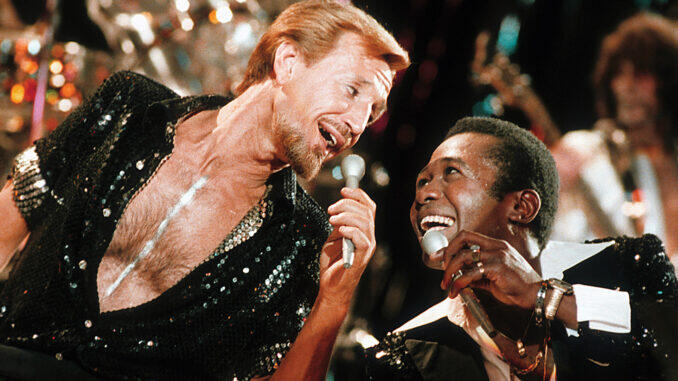
I love musicals. To anyone who knows me that is no revelation. Nor is this a confession, I have no shame despite the genre being an even more taboo one than Horror which is becoming increasingly mainstream and appreciated. So why is the genre such a swear word of a medium? It puzzles me at first glance but after hearing people's verdicts, it seems characters bursting into song and dance interrupts the immersion of the film. It’s like breaking the fourth wall, you realize it’s just a film you’re watching and not a tangible reality. To me, this convention only deepens my understanding of the characters and premise, and in no way makes it less real or nullifies the relatability of the characters and themes explored. However, I can understand the complaint. Although if that’s the case, then where does it end? Can you not relate to the social struggles of Peter Parker, a High-schooler who has the alter ego as the most famous vigilante in the world, Spider-Man, just because he can unrealistically crawl up walls and shoot webs? Is the paranoia of R.J. Macready and the Antarctic science party in The Thing, any less compelling and frightful because the threat of a shape shifting Alien entity is theoretically silly? Do you turn off Toy Story the moment Andy walks out the door? The idea of people breaking into song to express their emotions, develop the diegesis or simply to act as exposition, is no less authentic to films purpose as adding an element of science fiction for whatever moral the film serves. Still not convinced? Still find it distributive to the narrative, fine; but find solace in All That Jazz, a film whose only ‘we’re making this up as we go and everybody knows the dance’ numbers are one-after-the-other at the very end, justified as a hallucination - and for all the cinema lovers reading, it’s the most original and enigmatic use of the genre!All That Jazz is Bob Fosse’s semi-autobiographical allegory about art, success, depression, addiction and ‘showbiz, baby’! Roy Scheider portrays an eccentric, philandering and overwhelmingly successful theater director and choreographer at the top of his heap. Instead of being a predictable film about creative dead ends and the feeling of being a has-been, Joe Gideon is far from that stage and he is still shit-hot at making a unique and thought-provoking play as we see in segments throughout this film. His struggle comes physically with his health, as a result of his pill-popping habits not being able to keep up with his demand as a pillar in the New York Theater scene - not to forget his foremost personal issue being his sexual ambiguity and unfaithfullness to his girlfriend (Ann Reinking) that is as much an addiction as the pills. One lazy trope in recent ‘rockstar biopic’ type films with similar plots to this one, is the cough-in-a-napkin-and-blood-comes-out way of showing that these debauchery homosexual celebrities of the 80’s have contracted AIDS. Sure, when it was first done it must seem like an innovative way of showing and not telling but the formula has become as much a familiar language to the filmgoer as dialogue itself. However, lazy is not a word in this films vocabulary - ‘repetition’, on the other hand, is!The film begins with a montage of Joe Gideon doing his morning routine featuring a specific order of chores. A tradition not quite as exciting as his shows but none-the-less staring a famous cast of: showering, brushing your teeth, pill-popping and saying “it’s showtime, folks' in front of a mirror. This same seemingly mundane interlude of obsessive coherence does much more than count the days and let us know Gideon is hygienic. It’s a fantastically intuitive way of analysing his slow mental and psychical decline. As the film goes on, more and more the simple tasks become a burden as he grows weaker - all until he can’t say “it’s showtime, folks” without coughing his lounges out. At first, the editing of this montage and everything else felt distributive and plain wrong. Like it was cutting away from the punchline or not giving each individual moment enough screen time to have an impact. However, this was only felt because we are used to a certain editorial rhythm, a comfortable one. Alen Heims obscure, Oscar-winning and acquired approach soon inherits a place in our mind as it’s own rhythm that manages to describe Gideon’s life in a way that is appropriate to his crippling creativity as an artist. One cut that felt the most out of place in context to the depressing diegesis is the very opening shot. It features upbeat theatrical music to backdrop a beautifully lit show-bizzy sign wording a number from Chicago “All That Jazz”. I believe this tonally oblivious and not at all self-aware open to be a sneaky prank on newcomers to this film like me. It teases a vibrant, glamorous time and subsequently traumatises us with a master class of a subversive, psychological character-study.Now I’d like to talk about the only guarantee you have provided when you go into a musical: the music. The fascinating twist about this musical was that I spent about an hour and 45 minutes in complete confusion as not a note of improvised ‘we all know the choreography somehow’ music had been played. However, like I said in the intro to this review, the use of such an unrealistic occurrenallce as a sing-and-dance number is justified in this narrative as a hallucination of a theater director. At this point in the story, Gideon has been hospitalized and starts to have a dawning clarity of his recent life and reevaluates his priorities beyond being a promiscuous celebrity: his daughter, girlfriend and ex-wife all perform to him on a stage from nowhere as he lays in a hospital bed, Gideon gets directorial notes from a doppelgänger of himself in his usual healthy state, and the very last song is one the most memorable numbers of all time for its enigmatic originality. A song that balances being disturbing and flamboyant like no other to homage the film's subject matter in a way that also critiques it. A song to haunt Gideon for all his human stutters along his journey as an artist. A song that expresses regret, mortality, pain, realisation, reconciliation, fear of the inevitable and all that jazz that will mess with your mind. Bob Fosse is the king.February 2022.
IT'S VAMPIRES! BUT WITHOUT THE SUNLIGHT AND FLYING STUFF...

Not for a long time have I ever watched a film and immediately wanted to stick it on again. I didn’t in the end because I was tired but let me explain what gave me such an urge and child-like eagerness.Ganja and Hess is a film released at the peak of the blaxploitation craze. After 1968 gave us the most important horror film I believe ever to be released, Night of the Living Dead, both horror film-making and general western cinema changed for good. Night was a subversive and bold pioneer of the disturbed which taught unsuspecting audiences that horror was no longer a genre to laugh at or take your kid’s to. A medium that (similarly to Science Fiction) was previously the laughing stock of Hollywood. Film’s such as The Fly or Edward Wood’s movie’s such as the infamously poor Plan 9 from Outer Space couldn’t grasp a way to put such conceptually unrealistic and mind-bending demands for the genres to screen with a maturity that would make the film’s actually scary and visceral (although Ed Wood didn’t stand much of a chance anyway). However, this context isn’t necessary for this film, the more poignant effect that Night of the Living Dead had on Ganja and Hess was that it had a black man (Duane Jones) take leadership over a group of white survivors and kill a whole load of white zombies too! Although many victimized audience members would’ve been shocked at the elongated and graphic flesh eating scenes as well as daughters killing mothers, I’m sure seat holders of all race and ideology were even more surprised at such a strong and positive role being given to a black man. The race of actors who were previously subjected to the roles of maid’s, goof’s or thieves.The use of a strong black hero and the rioting eruption of the civil right’s movement in America made for a large change by black and white directors when it came to the emphasis of ethnic inclusion in popular cinema. What came was the mixed bag of good and bad black representation we now call Blaxploitation. The most famous of all being film’s such as Shaft and Black Dynamite. Although it was (mostly) a positive to have black characters for black audiences to resonate with, the portrayal wasn't always as positive as promised by the wave of effort. Black men where often seen as pimps who has a sexual obsession for helpless white woman, and often in film’s such as Abby, black woman where related to demonology and evil. Sticking with the strong and complex roles, Duane Jones starred in another stand out role as a doctor addicted to blood in Ganja and Hess. Being the best actor in a trend of films that he helped start.Ganja and Hess is the most experimental and unconventional entry into the vampire genre that I’ve seen. Much like Martin, it focuses a lot more on the desire and addiction to blood than being scary. It exploits the social problems that arise with the condition, of which there are limitless situations and dynamics to explore as well the loneliness of eternal life with a silent approach. Infact, the word vampire is never used in this film (I don’t think at least) instead it’s always said that he is just ‘addicted to blood’, drilling that awkward aspect of Vampire life into your head so you won’t forget. Neither Duane nor Hess are allergic to sunlight or turn into bat’s so as to distract you from the themes the director is clearly most interested in exploring (maybe this isn’t a vampire film after all).Despite this category of horror arguably being the most sexually gratuitous and exploitative, I’ve never seen a romance shown quite like this one. A match made in hell between a mysterious, blood-sucking doctor and the spoiled, rude (and eventually blood-sucking) wife of one of the former’s victims. They first fall in love before she knows the fate of her real husband, and when she learns so her true colours as a sadistic sex addict comes to surface. Although most of their romance is expressed through their venereal endeavors, a large insight into their dynamic can be seen through their support of each other’s perverse intentions towards drinking blood. The short time it takes for Ganja to accept her new taste for something as disturbingly condemned from consumption as the blood keeping you alive speaks, volumes about her character and the real mythological monster being her fiendish personality; as for Hess, Duane’s good looks and charm distract you from the fact that his serene swagger towards a demonic shift in lifestyle is in fact a bad thing and not at all endearing. They both play two halves of an unholy mold of the devil, yet manage to connect with each other in a human way, still be seen as complex and, as much as we'd love for it not to be, are occasionally quite relatable. There’s a fragment of sympathy and support for the two as they dig further into their nefarious exploration of sin, as pathos is built up by long speeches of existential thought or compassionate exposition.This gradual descent from charm and sympathy to pure evil is done very well by Bill Gunn’s enigmatic atmosphere and clear sense of direction. As I now delve into what I liked about this piece of art and what compelled me to write about it, I now find it a struggle to describe why it left me with what it left me. At various places in the film, we, as the audience, would be seated at a new station of tragedy for the cursed protagonists (or antagonists depending where you’re sitting) - and instead of Bill Gunn panicking about making this a popular success by over explaining just what that the tragic situation for the characters are with dialogue or even elongating the scene for us to give it more attention, he keeps every filmgoer who doesn’t want to think too much and just have a good time, out of the know. There are many scene’s that don’t last long or last too long where nothing is cleared up for us to make it easier to understand; you could watch this whole film and not know at all what it was about or trying to do. Some cut’s will add a small suggestion of a character's actions just to put something on the table in reference to their moral ambiguity that you could take or leave regarding your interpretation. However, by not overthinking it at certain moments, it allowed the somber tone of many scene’s do the work for me in smacking any sense as to why it was included.For example the ending: here you see Duane stumble into the church of a priest we saw in the beginning. The priest preaches and sings for about 3 minutes before we see how this relates to the film we’ve been watching; soon Hess makes an appearance, silently walking up to the preacher and making an expression that shows he is receiving the grace of God. He looks as if he’s being enlightened and maybe even cured - soon he walks out the church sprinting in joy. The loud climactic choir music that plays over his supposed reformation makes it feel like the ending, a happy one at that! Soon after, we see him wake in a dark room on a chair with no music but him still smiling. At this moment he is the only one rejoicing in his baptism of healing, and Bill Gun has taken no theatrical liberty to keep his environments on the same page. Instead we see a large cross in front of him as hollow music plays. He approaches the cross and in his naivety, he collapses, calling for an ambulance. The very beginning of this scene, just with the sound editing and juxtaposition of tone, it gave me the idea of what Bill Gunn was trying to tell me. That Hess’s cleansing from being a blood-sucking sinner was all for nothing due to the burdening mythology of vampires in that they can’t touch the crucifix. They are defeated by the force of religion. The priest was right about God loving all, but that only applied to humans. In a world where all that can redeem Ganja and Hess is the forces of a higher power, God turns his back on them and the alone - and that’s the biggest curse of being a vampire.I'm interested in what I'll see when I re watch it.April 2022
Hey Big Spender

What led me to this film? Good question. Under 10k Letterboxd members have watched it, it has a fairly average rating and I have never once heard it mentioned in conversation my entire life despite 59% percent of those conversations being about cinema and maybe 14% about musicals. My answer is like most: Bob goddamn Fosse. The guy’s a king. After recently rewatching one of the single greatest films ever made All That Jazz, I’ve gone on a journey from that 1979 station of existential questioning, back to the more popular 1972 station of Cabaret (of which could be seen as his real big break), then further ahead boarding in 1974 with the experimental biopic of a controversial comedian Lenny, then back to 1972 for a 50-minute televised concert (Liza with a Z) before going right back in full reverse to his debut. Sweet Charity had been a broadway extravaganza since 1966, being nominated for nine Tony awards and specifically winning best choreography by, you guessed it, Bob goddamn Fosse. By the end of the 60’s the broadway show was going stronger than ever (and would do until it’s final performance in 2005) so naturally a few practical producers saw it as a great investment to bring it to the big screen with the big name of Shirley MacLaine who had ideas of her own. The decision from the leading lady to have the well-known award winning choreographer Bob Fosse to direct the important 20-million-dollar musical film was an absurd one, and after the film’s disappointing box office result of £8 million, young, first-time director Fosse was the easy blame. Comparable to Paul McCartney being blamed for the breakup of The Beatles in a 1970 interview, and much like how the Liverpudlian musician revived his public image with the superb album Band on the Run a small amount of years after, it wasn’t until 1972’s Cabaret that Fosse would prove himself to the world. Having not known this underdog story prior to watching, I couldn’t imagine the direction of the film ever being a thing to slander, nor could I ever imagine the unapologetically flamboyant musical victory to be a flop, but New York Times put the public response best in their 1969 initial review, saying “isolated within "Sweet Charity" are moments that suggest that Bob Fosse, who directed and choreographed the movie as he did the show, could have made an imaginative musical had he (or the producers) felt less compelled to make a big, 70-mm. production with an established but essentially miscast star.” Things from the 60’s have aged poorly before (bowlers hats, babydoll dresses, Breakfast at Tiffanys) but I’ve never come across anything that has aged as poorly as Vincet Canby’s reaction to this masterpiece, and I’m gonna spend this review shutting his opinion down only 53 years after he said it. (Actually that seems harsh given Vincent died in 2000, I apologize to the Canby family).Mainly so I can stop saying his name in every sentence, I’m going to first talk about the direction (and naturally the choreography) first. It’ll sound like an insult when I say that this felt like his first film, but I felt that amateurish quality was for the film's betterment. Much like Charity's hysterical yet positive view on life, this film feels (almost inadvertently) as if it was made by a child who has just discovered the visual wonders PowerPoint has to offer. It’s filled to the brim with crash zooms, constant match-on-music action, freeze frames, colour washes, and although the froth of the drink occasionally trickles down the side of the glass into unwanted territories and the effects wear off, usually it works in a naive sort of vein. Especially when numbers like I’m A Big Brass Band are surreally made to reflect Charities inhuman optimism, having these quirks littered throughout the narrative is a great way of establishing that tone. This does feel like a bit of an outlier in the Fosse catalogue, whilst all his later works (disregarding Liza with a Z) deal in darker, maturer themes and use a mix of song and dance to cope with it (or if not a musical then they use bonkers editing and more style than an Edgar Wright movie), this was plain theatrical fun with no unhealthy dose of suicide, drugs, depression, exploitation or nazism to fuel Fosse’s storytelling genius. It proves that, although fun for all the family, a film can still be very mature when telling a unique message. And that leads me onto the next point of this review: the message.I seem to be nearing an age where ‘happy endings’ in these sorts of movies piss me off a little. The reality of life’s unjust-ness is becoming clearer in my vision as before when I’d bask in the uncertainty of bad eyesight; although a ‘happy ending’ is almost always the right route, I feel the perception of a ‘happy ending’ from most romantic film lenses is, you know, he gets the girl, she gets the boy, he gets the boy, she gets the girl, and so on. When done at its best, the film will spend its runtime enforcing as much hope into the audience, and the characters who are equally as oblivious as to what might happen, that said couple will end up together and that is a conventional ‘happy ending’. In this kind of narrative the happy ending is a treat, a guarantee. It sends a clear message, ‘believe in love and you will be rewarded’. Isn’t that what makes John Lennon’s most genius lyric so timeless: ‘All you need is love’ (yes I linked The Beatles back in here, so what?). And as much as it’s undeniably in the DNA of every rom-com the viewer can be reminded of the message's power when framed through a new, compelling, well executed story. However the guarantee of love seems to be commonly misplaced as the most important part of the message - the main thing you should take away isn’t (“may I borrow Notting Hill for a moment please?”) the fantasy of taking back Julia Roberts at a press conference. The part you should be listening to is the hope that gets Hugh Grant in the car, passed the strict lobbyist and straight into the press conference… because hope’s the only real guarantee. Sweet Charity did something bold and unexpected that made this not only a stand-out musical film but also a stand out love story (for me at least). It decided to reset the default factory setting that comes with being a rom-com to simply ‘believe in love’ and left out any mention of a ‘reward’. Sweet Charity’s essence is taken from the Federico Felini masterwork Nights of Cabiria, and from that is where the character of Charity is essentially copied and pasted. A down-on-her luck prostitute (in Charity’s case more of a dancer) who stays optimistic and bubbly inspite of the hand life has dealt her and the endless heartbreak that optimism earns her. For 2 hours and 10 minutes, Sweet Charity will seem like nothing special on the love-story front, but the note it ends on is not one of success and victory for the underdog, it’s one of slight anger for the unfairness of the world on fair people which is soon drowned out by the noise of ‘hope’. And to really hammer it home comes the ‘and she lived hopefully ever after title card’. For a film to preach persistence and patience with love and not giving itself the satisfaction of an easy (and conventionally) ‘happy ending’ is extremely admirable and mature. So the conclusion of Sweet Charity is no less filled with love as a Richard Curtis film that indulges in the fantasy of getting the girl, yet more important of a message to all the hopeful lovers watching, because hope without guarantee is truly the only way to guarantee a persistence of hope.Right, Shirley MacLaine. Officially one of my new favourite actors. I knew her (as most do) solely from The Apartment. One of the greatest films of all time and she was a driving force behind my love for it. The individuality given to her character was so admirable for 1960 and she executed the portrayal of a loveable, tortured, self-lothing elevator-girl so perfectly and in a way that fantastically supported Jack Lemmons happy-go-lucky character forming one of the most delightful on-screen relationships to look at. Other than that: zilch. However this was a passion project of hers. Nobody sought her out for the role nor was there really an audition, she just said to some producers ‘I wanna do Sweet Charity’ to paraphrase and to paraphrase again they said ‘yes’. Despite her itching desire to bring Charity to the big screen, her hurdle was to convince stage actor of the original Sweet Charity, Gwen Verdon, to adapt the ever-hopeful ‘dancer’ to the big screen, which was an idea Gwen adored. In fact she coached the excited MacLaine on how to bring Charity to life. Advice ranging from how to deal with Fosse’s lively choreography, the shaky mannerisms of the character that Gwen interpreted and, of course, the singing. And this leads me to my next point: Shirley MacLaine’s voice. Ranging from the melancholic tones of Where Am I Going? to the voice of a jumpy wide-eyed school child in If My Friends Could See Me Now and of course the juxtapositional conviviality as she and two other ‘dancers’ perform a rooftop number about the burden of their jobs in There’s Gotta Be Something Better Than This (which delightfully reminded me of the number America in the original West Side Story eight years prior). She also did a fantastic job at keeping my music-loving ears awake when there wasn’t a show tune playing as Charity weaves herself in and out of entertaining situations and endless rejection, allowing the sadder numbers like It’s A Nice Face to strengthen the sympathy we feel towards her. With that killer combination of compassionate character acting, a playful energy that makes you fall in love with her and heart-breaking musical deliveries in its slower numbers, the pathos feels well earned. The only time I noticed an ‘off-moment’ in MacLaine’s voice was during I’m A Big Brass Band, but even then the amateurish voice kinda worked. After all this film isn’t so much an ensemble one, instead it’s about the singular characters trials and tribulations with hope and love, so it doesn’t lend itself to operatic singing like Maria in West Side Story who eloquently adds to the collective noise of a large cast of individual show-stealers. This way when her voice doesn’t seem so up to scratch you are reminded that it doesn’t matter - because nobody’s watching her, these numbers are all in her head and she has no-one to vocally compete with around her joining in with the musical madness (most of the time). It’s solely her moment for all 2 hours and 29 minutes of the film, and that was a challenge MacLaine took on with unbridled joy as does Charity take on the challenge of life.Right I’ve talked about the direction, the message and Shirley MacLaine, what is also fundamental to my deep love for this hidden gem. Three words (or two words and two letters): Sammy Davis Jr.. The cherry on top of the icing of the cake from the top of the first place podium at a cake baking contest. His number proves my theory that musicals can take the story wherever the hell they want for five minutes even if it has nothing to do with the film and wouldn’t change anything if it didn’t happen, but as long as the song is as great as The Rhythm Of Life, not only is noone complaining about the tangent. Instead they’re worshipping the film for having it. Bearing in mind that this film was released at the very end of the 60’s, 2 years after the summer of love and right when every hippie was wearing out their Magical Mystery Tour LP’s (The Beatles are back for the final time in this review), this film, for no reason at all, takes us to a psychedelic church ministered by ‘Big Daddy’ who preaches love and peace. The church unfolds from what looks like a plain old garage to a psychedelic explosion of colour with hippies falling on top of each other in a musical race to get to ‘Daddy’ - AKA Sammy goddamn David goddamn Jr.. Not only visually but also musically it’s the best song of the film. An almost haunting mantra that worships this so-called ‘Daddy’ delivered by stone-faced believers. It’s an odd place to go to, and on paper makes no sense, but in the spirit of the whole movie it makes perfect sense and keeps you full of adrenaline for what else the film has to offer you. Not unlike the most ‘show-offy’ choreographed moment of the film, Rich Man’s Frag, where Charity finds herself out of place in a lavish celebrity nightclub. A chorus of people deliver amazing and comical dance moves for a random five minutes of the film with no singing involved. Again it adds nothing to the story but makes all the difference to the mood of the film. My second favourite number was Hey Big Spender, which I have revisited multiple times since I watched this masterpiece. It’s an early number which feels inherently more like Fosse’s kind of song with its dark undertones and brilliantly wicked execution. It’s where multiple dancers line up behind a horizontal pole and talk to said ‘Big Spender’ with blank expressions and dance moves that express themselves otherwise. It’s honestly like something out of a horror film and for that reason, it’s inherently Fosse (if you know, you know).What can I bring this review to, an ending I suppose. Sweet Charity is a musical you could very well have heard of if you were a theatre fanatic, but otherwise, as a cinephile, this film will most likely have slipped under the radar. But If I’ve managed to do anything this review, I hope it’s got you to set two and a half hours of your life aside, ready to devote to this film. And if that film succeeds, you just might go down the same Well of Bob Fosse’s filmography that I fell into - and I’ll be at the bottom of it, waiting for you. Vincent Canby, may he rest in peace, couldn’t have been more wrong.
HOW NOT TO DO A REMAKE

Akira Kurosawa is and probably always will be my favourite director of all time, and subsequently I believe Ikiru (his third best film behind Seven Samurai and Sanjuro) is a masterpiece. Unlike my approach to The Lion King, I came into my screening of Living endlessly open-minded as the idea of reimagining this timeless tale of mortality and the meaning of life excites me. Instead of holding Living to an unreachable standard that only Kurosawa himself can reach, I was ready to hear one of my most beloved stories told in a new setting by a new cast and crew and experience love for being alive once again as well as hopefully see what the 2020’s has to offer in telling the story. But much like a confused Bill Nighy sitting on his sofa and fearing his death, I sat (albeit comfortably) in the back row of the cinema fearing the death of cinema, and more so how soon it was approaching like a terminal illness.
Now that was a little dramatic, cinema is not dying. Exceptional future classics are being made every month but this film demonstrated a common fear in modern filmmakers that want to be taken seriously. While the glorious Ikiru is an existential and at times very sad film, it manages to be half an hour longer than Living yet twice as fast. This is because it doesn’t shy away from making the film watching experience fun for viewers when it doesn’t need to be mature and depressing. For example (and my rant of how this film fails as an adaptation starts now) the scene where a group of well meaning citizens attempt to get the approval for a park to be built in a local site where stagnant water floods the ground and wreckage makes it a place no one ever enters. They go from office to office in the city hall trying to greenlight the idea and in the superior Japanese original, each department is shown through one still shot facing the heads of each department as they calmly say ‘no’ in their unique ways. These vignettes are transitioned with (forgive me for not knowing the correct terminology) slide transitions, where the next frame comes in through the side of the screen. The transition varies from left to right and right to left as it conveys a sense of direction within the city hall without showing you literally. It creates a feeling that the impatient citizens are, much like the confused transitions, going in every direction, back and forth, up and down, left and right. It’s not like it’s trying to be funny, it's just the right technique for the scene and it works in spite of it possibly looking goofy in lesser hands. Living, being a remake, wanted to homage the slide transitions but with no sense of understanding why they were there in the first place. The scene where the citizens try to green light the children’s park in Living uses the technique despite their visit to each department being shot entirely inconsistently; not just inconsistent in comparison to Ikiru but to the ways they frame each department with a variety of tracking shots and zoom-ins and still shots etc. It’s all an attempt to express the same thing as Ikiru - the departments saying ‘no’ - but because of their inconsistency between each new location the slides serve no meaning. It doesn’t have the same rhythm as Kurosawa’s original sequence which begs the question, what’s the point? Why leave them in if they're completely useless?Living is clearly so afraid that such a lively sequence filled with visual energy will look silly in a 2022 film that it wimps out of the premise and makes it look more modern with longer spaces in between the cuts and cinematography that stressed me out which I won’t get into now. There should also be some consideration for how Kurosawa uses different cuts as grammar in all his films. Your typical cut you see in every film (and pretty much the only one ever used today) is like a coma. Within a sentence or even a thought you see commas, they ever so slightly change the subject and make a short break in dialogue before moving on. Likewise Kurosawa uses the common basic cut only as long as the scene stays in the same setting. A conversation between friends perhaps. As the environment isn’t changing, no fancy cut should disrupt the flow of the moment much like a comma, the clause after will say something different to the one before but within the context of the whole sentence. How about full stops then? Well full stops end the one sentence and move you to another one. For Kurosawa, a full stop is a jump in time and place. So when a character is at home then the next minute in a restaurant he’d use a slide transition (his equivalent of a full stop) to segregate them. Within minutes of a Kurosawa film you become fluent in the grammar and realize simply from a slide transition without even seeing what the next frame is that you are jumping in time and the previous scene or environment is over. In Ikiru, Kurosawa also has dashes. In dialogue, dashes are only used to show a haziness in thought. Maybe a character can’t get their speech out properly for one reason or another (confusion, fear, exhaustion) so dashes segregate their many trains of thought colliding. Kurosawa’s dashes, when it comes to editing, are fade transitions. It’s used in the scene before Watanbe learns of his cancer and feels great paranoia and fear. It creates a sense that something is wrong and Ikiru's mind is in many directions at once.Why am I talking so much about editing? Stupid stuff like irrelevant transitions aren’t something that I’m a massive stickler for, but Livings inability to replicate Kurosawa’s editing style due to fear of looking ‘out-dated’ or ‘goofy’ but keeping in the slide transitions is a great way of exposing how this film confuses itself constantly throughout the runtime - it’s also what makes Ikiru timeless and Living not. It clearly has great love for Ikiru and wants to retell the fantastic story explored for the first time 70 years ago, but I don’t always feel like it understood just what made Ikiru so unique and clever. To the eye of a viewer who has never had the pleasure of watching the 1952 masterpiece, this film must seem, in spite of the other flaws with the film in general, a delight. After all it tells the story through the same structure and that structure is genius. But what could have been a reimagining of a timeless tale with its own spin on it became a pointless half-assed attempt at just creating a version of Ikiru, accessible to those who hate old and/or foreign films. Much like those many frustrating American remakes of Asian horror films in the 00’s.Back on to the structure, something that makes Ikiru so heartwarming and genius is how it is told. The film begins with the narrator exposing that Watanbe has stomach cancer and doesn’t know it. The literal first shot is his X-ray scan, that's how quick it establishes the tone. Once he learns of his illness early on in the film, however, we experience the narrative through his perspective. From then on the audience doesn't learn anything before he does, in fact, given that the character holds back on telling anyone the truth, there are many moments of dramatic irony where side characters interact with Watanbe being out-of-the-know and we watch with an all-knowing eye experiencing the moment as Watanbe is. For example Toyo telling him that her nickname for him used to be ‘The Mummy’, unaware that he knows he’ll be dead in six months (another scene that Living rips-off and does poorer). It’s after he meets Toyo that the film’s direction changes for the first time. Before that moment he searched to enjoy life via means of pleasure, as he accompanied a young stranger to his idea of ‘fun’. That being parties and strip clubs and karaoke etc, but all that does is make him sadder. After that dead end and having a new found lust to not be boring, he sees his young co worker Toyo one day and she asks for his permission to leave work. He’d been off work for a week and she needed his stamp on a form in order to resign so she was relieved to run into him randomly. He invites her home to stamp the file and soon becomes her friend - going to dinner with her and seeing her on multiple occasions. In Living this dynamic is shown purely as wholesome and cute. Bill Nighy hangs out with the young girl because he enjoys it and doesn’t want to waste his last moments. He sees that as the meaning of life despite being unfulfilled within this peculiar relationship. In Ikiru, it’s shown more as an obsession and an unhealthy situation for Watanbe who seeks fulfillment with her.In both films there is a scene with the old protagonist and young girl that marks the moment that changes his life. Both scenes play out in crowded restaurants as the girl is skeptical about the nature of their relationship. Both scenes also (and this is key) have toy rabbits in them. In Ikiru he confesses to Toyol that he is obsessed with her as well as reveals that he has cancer. She reacts with a degree of empathy and respect but is also disturbed with his obsession and offers a suggestion of what he could do with the rest of his life. She shows him a toy rabbit she has been working on as a project and says that making it brings her lots of satisfaction (something that he is searching for). He takes this on board, goes back to work and makes it the first thing he does when he gets there to take the poor citizens up on their plan and finally get that children’s park made which will give him a project to work on and something to be proud of like Toyo is with her toy rabbit. Living plays out similarly, but without the same effect. The two go to dinner, she says that she is slightly creeped out by the nature of their relationship and he reveals that he has cancer. She is purely empathetic and he gains no new perspective on life. Oh and the toy rabbit is still there, but for no reason at all - it was simply a thing she won at an arcade game in the previous scene. Living was aware that the bunny is an iconic part of the original scene but doesn’t realise that it is supposed to move the plot along, which again begs the question, what’s the point of having it there? After the meeting in Living, Bill goes back to the same dull office and decides to work on the children’s park despite having no character development that would make him so adamant to suddenly take up the project - there was no seed planted to give him that idea of creating a legacy with the park. Both scenes play out the same but Living just doesn’t understand the point of it. For Ikiru it’s a key moment of character development, for Living it's a scene that happened in Ikiru so why not copy it with half the meaning. Why oh why did you leave it in then?Carrying on from how this film is structured, the film is all in Watanbe’s perspective until about an hour and 20 minutes in when it is revealed through a simple shot of his picture at his funeral that he has passed away. It’s abrupt and almost like a silent jump scare (unlike how Living butchered the moment with a slow zoom in). From here on we see the effects of Watanbe’s attempt to be remembered for something (building the park) through the words of those that are remembering him at his funeral. Instead of carrying on with the narrative structure and just showing him getting the park built, the story is experienced through the many accounts of those that have come to pay their respects. Initially at the funeral the grievers are talking about the park building and figuring out how much of a vital part Watanbe was in its production. At this point they grieve his death but do not see his life as significant and still believe him to have been the same boring man at the start of the film as to when he died. However only with eachothers aid do they piece together that he did something exceptional with his last few months alive and gain new respect for him by the end of their reflection. The reason it shifts to the funeral is not just to mix it up a bit but to cleverly clarify that Watanbe’s attempt of leaving a legacy worked at the same time as the funeral attendees realize. We are now in the mourner's perspective and Ikiru becomes a side character as his words and actions become the second hand accounts of others, perfectly solidifying that in his last moments, Watanbe did manage to make something of his life. This structure is something Kurosawa proved he could effortlessly do with Rashomon and it works so well being applied to the second half of this film. In Living one of the few changes is that the men who piece together the truth aren't at the funeral, they instead figure it out in the train home. Whereas Ikiru patiently sets up this new jump in time as if it’s the start of another film, introducing characters and waiting for them to recite their memories of Watanbe’s park-building efforts, Living does it differently and, you guessed it, much worse. The men on the train begin saying their accounts instantly as if they’d been actively informed to solve the riddle of ‘who built the playground’ and when it cuts back to moments of Bill Nighy getting the park built, it replaces vignettes of the men’s memories for a pure continuation of the film from Bill’s perspective for the last time rendering the question “WHAT’S THE POINT?!’ Ikiru’s ability to turn Watanbe from a main to a side character is genius and the reason that the film so abruptly jumps forward in time, but once again Living has missed the essence of the narrative decisions and just keeps it in as a homage to the great original and not at all aiding the story as an original, individualism singular film. What’s the point?!I watched this film with a friend who had never seen Ikiru before and as the film progressed I felt a crime had been committed against him. Instead of reimagining a great tale the film spoiled many elements of what makes Ikiru great and did them worse, robbing him of the full Ikiru-watching experience where he could fully be exposed to the genius of Kurosawa’s storytelling properly. I began writing this review in my head whilst watching it out of pure boredom and a line I was going to write was ‘at least it didn’t rip off the iconic swing shot’ until ahem it did! A moment that made me genuinely cry in the original but just made me frustrated with the film’s incompetence here. There’s a quote I once heard and I can’t remember who said it or what film it was referring to but it went something like “the director is using dutch tilts but he doesn’t know why” and that’s how I felt about this whole film. It tries to border the line of a reimagining and a shot-for-shot remake and that leaves it with more questions than answers. It has the time jump but doesn't know why - it has the slide transition but doesn’t know why - it has the toy rabbit but doesn’t know why! Above all else it did remind me how perfect Ikiru is and caused me to re-watch it which is I suppose a plus? There are more bad things to say about Living and good things to say about Ikiru but this is more of a comparison than a review for either. I didn’t touch on how much better the cinematography of Ikiru is to this or even say the one positive I had that Bill Nighy nails the performance and does a great job of living up to Takashi Shimura (hell he’s just the modern british version of him which is fun to watch). However, if I’m going to leave this with any positive for Living it’s how much I enjoyed seeing a ‘The End’ title card in a 2022 film, or maybe I was just happy that it was over. What a waste of a film and do not watch the remake first under any circumstances.
HOW TO EXCEED AN AUDIENCES IMAGINATION
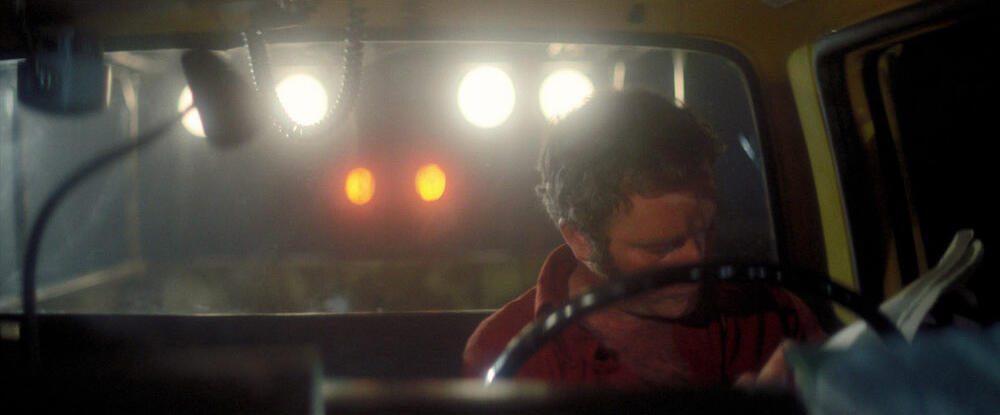
Good lighting isn’t (usually) meant to be noticed. The right shade adds to the production and helps everything look a lot more professional, and even when production value isn't a problem with bigger budget films it should affect us in subtle ways we don’t instantly notice. Some use of a certain colour or manipulation of shadow can be quickly recognisable as a nice shot, but done at its best it will be a working force in the film’s behind-camera ensemble whose purpose is to enhance the narrative and support the story in any way it can. Close Encounters, however, has the best lighting known to man and show’s that lighting can be unique and beautiful without disrupting the film’s flow in the least.Although Spielberg got his name for shocking audiences with Jaw's famous public response of making a generation scared of the Ocean, you can also see him demonstrate this talent of evil genius in his ever-gripping TV-movie debut Duel which will make you paranoid every time you see a truck on the road after watching. Despite also releasing the country-set film The Sugarland Express in between those two films with no intention of creating any sort of tension-building thriller, soon after the world's first blockbuster Jaws, he came back with another masterpiece that greatly subverts the audience's senses in a similar vein to how it's predecessor makes you look at the sea funny. Close Encounters plays off the speculation we sometimes feel seeing mysterious bright lights in the distance (specifically at nightime), the same curiosity that gets us looking at far away lampposts as if they’re the flashlights of strangers or wondering if the blinking lights of a high-flying aeroplane are those of a slowly dying star.In this film, the UFO's (that's right, plural) are introduced first through word of mouth. We hear a sunburnt old-man recount how he saw something funny a few nights prior before being introduced to a few strange anomalies happening in the world (such as the fighter jet's in the sahara desert at the start). These help build an image in the audience's mind about what these UFOs look like, how they will be relevant in the story later on and hopefully many other burning questions about the enigma; which is the perfect off screen introduction to such a strange thing as UFOs that really helps builds tension early on. Although Spielberg uses this unanimous curiosity of the audience to his defence, it can often be a burden. In horror and science fiction (two genres whose uncanny supernatural and other-worldly concepts rely heavily on visuals and spectacle) there often comes a challenge when a creature or thing gets built up by the suspense of confusion and mystery throughout the first two acts of the narrative, to live up to that intrigue with some sort of visual - with the sad truth being: you can't. When the audience images something really scary or ‘out-there’ it will always be much more impressive than anything a film’s visual staff can tangibly come up with, so it’s often times down to the director to keep that in mind and keep the audience's eyes averted from the actual sight of the enigma (hence Spielberg’s reluctance to show Bruce out of water in Jaws). This is where Close Encounters clever build up of the fear of the unknown and use of lighting come together beautifully.The scene I’m going to talk about is that one with the iconic shot. Actually I might have to be more specific given this classic is loaded with iconic imagery. The scene at the country house of Jillian Guiler and her infant son. Despite being a science fiction venture, this scene amongst a few others demonstrates Spielberg's reluctance to let go of his love for horror filmmaking with a bad-shit terrifying moment of classic suspense. Earlier on, many well-crafted moments show bright indistinct lights in the distance of the character’s keen observation or a few times in the foreground of the character’s total ignorance. This introduces that strange lights are the only thing we will be identifying the UFO’s with for a while, and once that motif is established Spielberg also pranks the audience (and characters) a few times as for example the light of a helicopter can be mistaken for another close encounter. Anyway back to the country house scene - despite Jillian’s cluelessness towards the ‘threat’ at hand, her son has already shown through an earlier scene that he is extremely interested in the enigma by walking away from his parent to follow the mystery. One deceptively quiet and normal night we begin to see unusual activity in the clouds above, and naturally this disturbing weather anomaly is highlighted not just by the unusual movement of clouds, but also light. The mother’s immediate reaction (despite her dumb-foundedness thus far) is to lock up the house and shelter away from whatever’s going on in the heavens. However the threat grows personal as it begins to invade the house which is introduced how? By light. A yellow spotlight creeping through a keyhole and teasing an atmosphere of hysteria. Of course by this point the audience knows better than the mother that this is a UFO, and when it could look silly for a large flying object to try and enter a house, or, at this point on the film, for aliens to drop down and knock on the door, Spielberg uses his greatest weapon of light to visually explain that these aliens want to get inside. Various creative decisions are made such as a brightly lit smoke emitting from the floor’s ventilation, a bright spotlight shining down through the chimney, even strange domestic activity is involved as a self-activated hoover moves across the floor with a beaming lightbulb on its head. Similarly to how Jaws shoots the sea and everything that has the misfortune of being in it to suggest a shark despite rarely seeing the actual animal, Spielberg shows an otherwise silly alien invasion by purely utilising his lighting staff and it’s far more effective than any silly alien design he could’ve used at that moment in the film.In a film as episodic as this that doesn’t follow just one character and flickers between the perspectives of important people - from those that have the resources at hand to properly investigate the enigma to common working-class folk that try and wrap their head around the mystery with nothing but their imagination at hand - it can often come of as quite cold and distant. This is where Richard Dreyfuss’s brilliant performance as Roy Neary is necessary. The unexplained law behind how the Aliens communicate with the human’s and in their mysterious ways negotiate a time and place for the anticipated meeting is shown on the one hand through the scientists and politicians who set up the structure that hosts the event but also through a prior witness to a UFO sighting (Roy Neary) who was inadvertently fed the information. Instead of him immediately figuring everything out as soon as he sees the curious lights of the spaceship’s, he is driven mad shortly after the sighting. He talks of constantly seeing the same cone shape in everything from his shaving cream to a mud pile outside. At first the unexplained obsession is subtle as he merely remarks about the coincidences, but as it goes on the obsession grows larger and larger until he is disrupting his family in the process. This compelling dynamic between his so-called insanity (despite it ending up being worth it as he navigates himself to watch the historic event unfold) and his family who are ignorant to alien’s at hand is what grounds this otherwise larger-than-life film in reality. The short scene at the dinner table when he honestly confesses to his family that he’s sorry for the pain he may be causing them as a result of his obsession but his persistence is important is one of the best of the film, and for a movie that is mainly benefitted from it’s visual storytelling (like how it pulls of the last half an hour of the film with little-to-no dialogue) that moment and the narrative of Roy as a whole allows Spielberg as well as the other writers that worked on the film to boast of their writing talent. It’s an underrated performance as Dreyfuss perfectly plays a man who is falling apart and not until the last act it’s fully revealed that he wasn’t losing his mind at all and explains the motives of his unconventional decisions. Roy is the heart of the film even if the most beautiful moment is an exchange between humans and aliens.Going back to what I said earlier about the burden of how science fiction and horror can never visually live up to what’s brewing in the audience’s mind, Close Encounters both avoids that demon with a motif to merely represent the UFO’s and aliens instead of showing them in plain sight, but it also does the incredible job of showing us the mothership at the end and exceeding our imagination. The way this is done is by lying to the audience - and if this was a video essay that'd be the title of the next segment of this review. Spielberg feeds us information about the enigma throughout the runtime despite that information being very little and not enough to yet satisfy the audience's child-like wonder. We see a few times that there are three larger UFO’s and one small yellow beam of light that trails along like Tinkerbell behind them. We spend the whole film looking out of these four - even counting the parts of the armada if they're ever on screen like we’re taking the UFO school register. We also know that the aliens have communicated in their mysterious ways to the humans that they’ll make their monumental contact at a place called The Devil's Tower in Wyoming. At The Devils Tower a team of scientists have set up a base with bright lights where they hope the aliens might see and park for a while whilst the greatest event in human history takes place. At first, we see the three UFOs that the audience is by now pretty well acquainted with arrive and communicate through the mantra of a five-note musical melody to the humans. It’s a historic and cinematic moment but doesn’t quite feel like the climax we’ve been promised and luckily, it isn’t. From behind The Devils Tower arrives the mothership we never knew existed. Something that is so large you could even theorise it’s the Alien’s mobile home planet as if the species lived in the NASA equivalent of a planetary caravan. We’d been expecting merely three small floating triangle’s and glowing dot the entire film and, despite often being spoiled by the film’s advertising and iconism in general, we are rewarded with an overwhelming visual that exceeds all expectations, doesn’t cheapen the film upon viewing take away from the it’s consistent air of intrigue and ends the film on a perfectly climatic note that will leave a great taste in your mouth - as well as featuring a moment of friendship between humans and aliens rarely seen in these types of film’s that will really make you smile. It’s lovely, overwhelming and a feast for the eyes as well as the only way you can hype something like a spaceship up for an entire film and live up to the expectation. This is what makes Close Encounters of the Third Kind not just the film Spielberg happened to make after Jaws, but a follow up to its unique sense of execution in every way. Yet Spielberg is so brilliant that it’s only his 10th best film in my opinion.
A HORROR FILM WITH A BITE
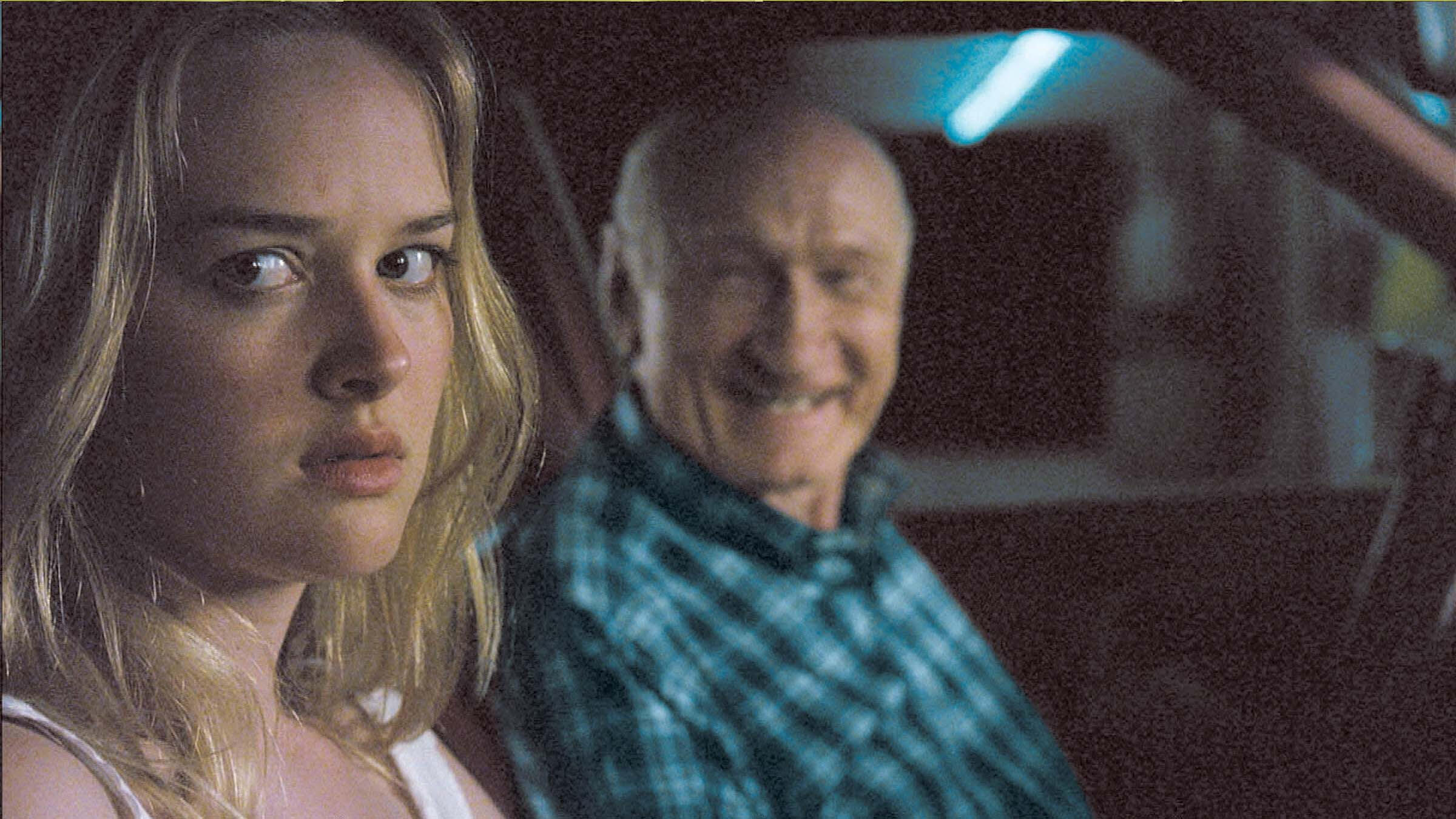
It's time I review Teeth. I quite often leave films to be reviewed at length then just forget entirely and never write a thing so here I go. My reviews usually are in three or four parts, each section honing in on something interesting I have to say about the film or contextual information for why it's so great or not so great but now, for the first time, I’m gonna walk you through it so even if you haven’t seen it and don’t want to by the nature of what it is, you can read and realise what an unbelievably strange but simultaneously quite genius film this is – and more than the trashy slasher flick it’s made out to be. This review will probably end up very weird and talking about some strong themes so, as they say, digression is advised, and this is a spoiler review, but I haven’t marked it so because if you haven't seen it, I think you can still read this.I heard about this film first as a sort of noughties cult film on the Dead Meat podcast and it pricked my interest. I mean as far as elevator pitches go this is king, I don’t think any travelling horror film producer would get off at their floor even if they were in a rush when they hear this. I almost wish it was pitched to a bigger producer than whoever ended up making it as this film does deserve better production quality than it got, nevertheless, it did great with its budget.Let’s get the negatives out the way. This isn't five stars; the lead actor was unfortunately not always all that. Given it's a lot in her perspective she obviously wasn't bad or else there's no way this would be 4 1/2 stars, I just think she could've been a tad more convincing (although the role is understandably a very strange one to wrap your head around there’s no other like it). I also think this absolutely should’ve been made by a woman. For me, it’s not so much a back-and-forth thing like with Tarantino making Django Unchained, it just straight up should’ve and would’ve been considerably better if it was. Some of the ambiguities in what certain parts of the film were trying to say might’ve been cleared up and in general for a film about female empowerment to be made by a man is contradictory by nature.That's pretty much all this film rocked.Alright let's just say it, this is a film about a woman who has teeth in her vagina. Jaw dropped? Pick it up already, please save agape mouths and wide eyes for when you actually watch it and realise, hey, I'm not lying - there is a film about a woman with teeth in her vagina. That woman is called Dawn O'Keefe and the film begins with a flashback of her as a child in a paddling pool with Brad, another prominent character. Brad is son of Dawn’s mother’s partner. The boy is reluctant to the idea of a stepsister and splashes her in the pool to his father's distaste. The short cold open ends with Brad haven cut his finger- oh wait no that’s not a cut, it's a bite mark. Now this is a bold bold bold opener; later in the narrative we learn of what a sexually aggressive character Brad is but to have that established by them as children showing the simple biting as a decline in his view of women and, well, how he feels is acceptable to act around them is, again, extremely bold. I mean this is a controversial horror film but with his an ungrusome bite of a finger the film could already turn viewers away just with the fact that they are children and what the bite suggests he did in that pool. Strong stuff.Dawn is part of some Christian abstinence group that are, as you’d expect, extremely anti-sex. Like it’s their whole thing. This stems from Dawn personally growing up very repulsed by sex and her own sexual expression that the church has seen as a great thing to jump on and make 100 times worse, repressing and demonising every sexual urge of hers and subsequently the whole cult cough cough group. At this time Brad is an edgy, dark, drugs and ‘rock and roll’ loving sort of young adult with his punk girlfriend Melanie. Oh, and he has this vicious dog that looks as hard as he is (or thinks he is). The first time we see his character introduced all grown up is with him and his girlfriend finishing a session of, well... anal sex. Again, this film is NOT messing around. They discuss why they can never do it any other way and he naturally doesn’t give the truth of what vagina related incident has traumatised him from a young age. Oh, and also Dawn’s mother is ill, and stepdad is there, he’s... I don’t remember what he’s doing but I feel like it’s relevant. Oh well it can’t be that relevant. Brad’s a sexist arsehole and Dawn is sexually repressed – that's all.Dawn has two Christian mates she attends the group with called Alisha and Phil, however the threesome becomes a four when a muscular young Christian boy named Tobey enters the mix. In a well edited sequence Dawn is seen in bed at night fantasising about marrying Tobey, however as the fantasies grow more and more illicit her teeth begin snap and the pain of that is another reason for her to supress the urges her sex-hating group demonises. I thought this was a very clever way of making the whole teeth thing feel more real, like how to her it’s just a natural part of female puberty or something; and interesting how any references to sex causing her to activate the defence of the teeth because of how shut off she is from that side of her. Anyway, her Tobey, Alisha and Phil begin to go out as a four quite a bit. Soon the attraction between Dawn and Tobey is addressed, they decide, as expected, to deny it and carry on as friends. This is until they meet up for a steamy swimming session one day without their friends. This leads them to a cave where their relationship is solidified as romantic by a kiss. She, in spite of all religiously brainwashed instincts, enjoys this. Tobey, however, like most strict Christian early adult boy feels the need to do more than kiss as long as their breaking the boundaries of their religious suppression and, you know, maybe he wants it a bit more than Dawn. Then a lot more. Now it’s rape. Here we see maybe the most emotionally conflicting moment in all of cinema as such an uncomfortable scene of sexual assault becomes mind blowing, scary, a little funny and just plain weird. She bites off his dick!! Now if you didn’t already know there were teeth down there (as the film hadn’t outright told you by this point) all was confirmed as Tobey stands up screaming with a hole where a penis once was. It’s fucking crazy. She, like the audience, is gob smacked and doesn’t know at all what to do. I actually can’t remember what she does do now I think they both just fuck off but either way absolutely insane scene maybe one of the best moments in cinema history it’s just so messed up and brilliant.Here we have one of the most iconic scenes of the film that I believe was used in most of the promotional footage as it’s the only scene I recognised. It’s her visiting her gynaecologist. She had recently read up on the legend of ‘vagina dentata’ which is arguably a better title than ‘teeth’, and wants to get it checked out. However, this man (like every other man in this film) gets too familiar with her private parts and decides, against her will, not to use a glove. She is of course horrified and as per her new defence mechanism decides to bite down to the reveal of his decapitated fingers. This alone could work as a great cold open, even better than the subversive start this actually has.Traumatised she seeks the embrace of an old classmate called Ryan, who previously in the movie attempted to ask her out to her rude rejection (not that her rejecting him was rude just the way she did it was). He’s still overjoyed to take her in and in her panic he does manage to calm her down with, of all things, a vibrator. This is effective in calming her as the teeth do not activate and she realises there is a sexual context in which she doesn’t become a vicious trap for the man. With her vagina seeming less in control and more her in control of her vagina, she begins to have sex with the seemingly harmless Ryan. She is relieved that she can do such a thing without it ending in a bloody mess and is angry that her Christian group has shunted her away from expressing herself in this way. That is until mid sex when Ryan answers a call and boasts to his friend about how he managed to pull her - its then she realises that he is only with her on a bet. He told his friends he could fuck her and followed through. With this revelation and with the first good man in her life also ending up a jerk she... you guessed it, bites his dick off. This scene is excellent as her first reaction to the gruesome castration is of utter shock and understandably so, however this time her face expresses rage at the man followed by the surprisingly comic sound effect of a chomp, and then her face changing from that of anger to “ahh shit I forgot my vagina did that”. It’s almost as if she feels the uncontrollable violence she has now used against him is a bit of an unwarranted punishment, but then that emotion is also consoled by what a twat he was just revealed to be. It’s genius.She returns home and finds her ill mother is dead, and her stepbrother Brad who lives with the ill woman had ignored her calls for help intentionally. Also, I don’t know if I mentioned but Brad is such a twat, you see him interact with Dawn in an earlier scene and he’s horrible and uncomfortably hits on her its weird. At the hospital her stepdad is of course broken up about it, but she gets talking to Brad's girlfriend Melanie and finds out from her how abusive and horrible he is. Also, his whole reluctance to have vaginal sex she figures out is because of that incident when they were younger. Here we see the third and final stage of dealing with her ‘teeth’. She went from pure shock and disgust of herself, to biting off Ryans dick and regretting it but not making a big deal of it, to fully owning it and using it for revenge. She enters Brad’s room and here is one of the most uncomfortable scenes in an extremely uncomfortable but also subversively very fun film. She seduces him and he reveals how he’s been waiting his whole life for her and is now ready. They begin to have sex and he almost overwhelmed by how long he’s waited, she, on the other hand, is just plotting revenge and naturally getting no satisfaction of any kind out of the sex. She waits a second then bites down in full control of her killer pussy (sorry for saying pussy I’m just getting bored of saying vagina). His dick falls on the floor to his dismay, so he screams at his vicious dog to attack Dawn – the dog though, he has other plans. Like the canine he is he picks up the dick in his mouth like a bone, and to Brad’s dismay... swallows it. The perfect fuck you to a man who this time, absolutely deserved it.Right, here’s where the rape discussion is gonna begin. I don’t know the full intentions of the writers and director here, but from where I stand, I think the idea of Teeth is imagining a fantasy world where woman have a defence in such an awful thing as rape. Here’s where it’s gonna get very uncomfortable but it’s just interpretation. Men, as horrible as it is to say, have a weapon in sex with their penis. Something that can be used violently, that is why it’s actually technicality that only men can rape and not women as it’s them who penetrate. Teeth isn’t essentially giving women dicks, as it requires the man to enter them so they can use the teeth against them, it’s just imagining a world were woman have a defence in sex, one that removes the assaulting man’s dick for crying out loud. Now I don’t think I have enough time on earth to fully unpack what they’re trying to say with that, whether it’s wholly empowering or a little backwards, I sort of just see it as a what if? A reverse of sexual politics, what if women had the upper hand in these situations and with the sort of self-aware and not too serious tone the film adopts, I think it’s just like one big much needed fuck you to the men that use sex as a weapon. Furthermore, it’s just sort of an hour and a half long relief from the fears that women have to look out for and take precautions against every time they’re found in a situation with a male stranger. This is driven home really by the final scene where she finds shelter in a man's truck to drive her home. As expected, given that every man in this turns out evil, he locks the door and starts licking his lips. This set up in an earlier place of the film would’ve been met with realistic fear from Dawn followed by the uncontrollable castration of the man by her abnormal reproductive system. However now a Dawn who has gone through the events of the film just turns to the camera and rolls her eyes. By this point she has gone out of her way to plague revenge with her teeth, she’s owned her talent and turned a curse into a blessing in a horribly misogynistic reality. It’s unique, it’s weird, it’s not necessarily trying to be the most political or feministic film ever but it’s definitely clever and deserves more praise than just being a campy shocking trashy noughties cult horror flick. It should’ve been made by a woman no doubt, but nevertheless what we’ve got is something worth watching – for shock, comedy, body cringing gore and above all else originality.December 2023
AN EXPERIMENT IN FEAR

I've always admired this film for being a true exercise in fear. It's like the 'fight of flight' reflex within incarnated into a story and put onto celluloid. Throughout the brutal final act of this movie everything within Sally is telling her to run despite the pure torture she's been put under, and it just makes you realise how much you can take in the name of survival. However, on this long-awaited revisiting I found myself appreciating the masterpiece for a whole other reason.This film has a very particular view on humanity, or more so a lack of it. It treats humans like animals to put it plainly. The most obviously instances of this is with the twisted family of serial killers who scream, crawl and act like carnivorous predators, but I actually think in that case of the Sewyers the inverse of my theory is apparent. Instead, it is the young adult friends where we see this inhuman lense applied especially with Sally. You've most likely in your life watched a nature documentary and some cute animal like a penguin was being chased by a predator like a Polar Bear. You were also most likely on the edge of your seat as the penguin straggles to lose the hunting beast’s pursuit. Well, if you really think about it the same is apparent here.Tobe Hooper takes no liberties to make Sally and her friends likeable or indulges in any cliches to give us a reason to care about their survival. Not that they're arseholes, there's some sympathy with Franklin, Sally's disabled brother and their inability to accommodate him, but all the dialogue doesn’t feel like scripted word instead just improvised snippets of an ordinary friend group. Nevertheless, when the titular massacre occurs, we find ourselves hiding under the covers in suspense of Sally’s survival for no other reason that her being, sure cute like the helpless prey on a David Attenborough documentary, but mainly just because she is human and does not deserve what is coming. This classic is a reminder that despite our technology we’ve created, knowledge we’ve learnt and ‘civilisation’ we have built and used to entitle our species as having the intellectual and physical high ground over all other animals on earth, we can still be just as savage, and the circle of life can be preserved when a family as twisted and cannibalistic as the Sewyers are out there - and in The Texas Chainsaw Massacre, unfortunately, they are a short hike away from our protagonists.Going back to that family I think it’s worth explaining why I think they are the complete foil to Sally and her swinging 70’s friends. The Sawyers lead a flithy cannibalistic lifestyle as if they were the sadomasochistic Brady Bunch. They have no human or moral values other than family as demonstrated by how carefully they bring down the 100+ year old ‘Grandpa’ who has the psychopath’s unanimous respect. They reject the human way of living we call ‘civilisation’ by living alone and creating their own lifestyle, where they hunt their own food brutally and eat what we deem inedible: each other. They are animals in every way. However, this portrait of them is not interesting because of that, but because of how such twisted routines of torture are framed through the lense of a typical American suburban family. They all have their own jobs like we do and work hard to put some human flesh on the table, they bicker like brothers it just so happens that they do so with knives, they respect their century old blood sucking father, they dress up for dinner, eat together around the table and when they leave the younger brother home alone he makes a mess of the place with his favourite toy (a chainsaw). In fact, the idea of such a twisted mentality being shown in a typical American way is epitomised with the character of Leatherface, everybody’s favourite serial killer.The skin mask he wears when we first see him in the daytime preparing the family’s dinner was referred to on set as his ‘house slippers’; you know, something comfortable you can slip on and stay at home with whilst you chop up the evening’s corpses. When it comes time for the long-awaited dinner, he puts a wig and makeup on the dead flesh he’s wearing to, you know, make an effort and look nice. The man kills without prejudice or true evil intent but instead because that is what he’s been raised to do and never educated to see it as wrong comparable to the lack of moral conscience in any animal. Whilst the first half of the film is spent setting up these damned kids as people living the typical American human way but reverting back to the helpless position of stalked prey at the hands of the Sewyers (devoid of using intelligence or technology but pure animalistic instinct to get out of the situation I mean), the second half is spent showing the otherwise typical and nuclear routine of a family who have the primal intent of killing and eating everything and everyone they see. One is humans turned and animal, and the other is animals trying to be humans, and The Texas Chainsaw Massacre is what happens when they butt heads.I was struck on re watch by how much of what makes this film so scary is just the constant macabre imagery. Like in the opening sequence where it flashes frames of twisted corpses, this film sometimes just lingers of skulls or roadkill, or chickens in cages and all of the above to keep you uncomfortable throughout the entire runtime. Not to mention the constant imagery of dead animals then the similar framing of human corpses later on supports my case of this film seeing humans like animals. I’ve said this before, and I’ll say it again, but I love how short this is too; it just gets in and gets out before losing its edge similarly to the Blair Witch. Leaves you absolutely cold and ready to turn vegetarian. A near-perfect film, I’m in love.October 2023
My filmography (so far)
August 29th 2020
SILENT GORE-FEST MARATHON
I did many things to fulfil my boredom during lockdown and one of them was the discovery of editing. Horror films and silent movies were my obsession, and it was whilst discovering a plethora of great flicks from both genres that I realised a great cartoonish and slapstick quality in many of these scary pictures. With iMovie I began combining them and as an editing exercise I tried converting scenes from my favourite horrors into that 1920's style. I did it for four different films then combined them into one 8 minute video with the rediculous tite above. This is not something I've made public before but have now decided to make visible to the world.Watch them here ~ https://youtu.be/MUupLfUekRg?si=_oEQN-wCfII-sy1X
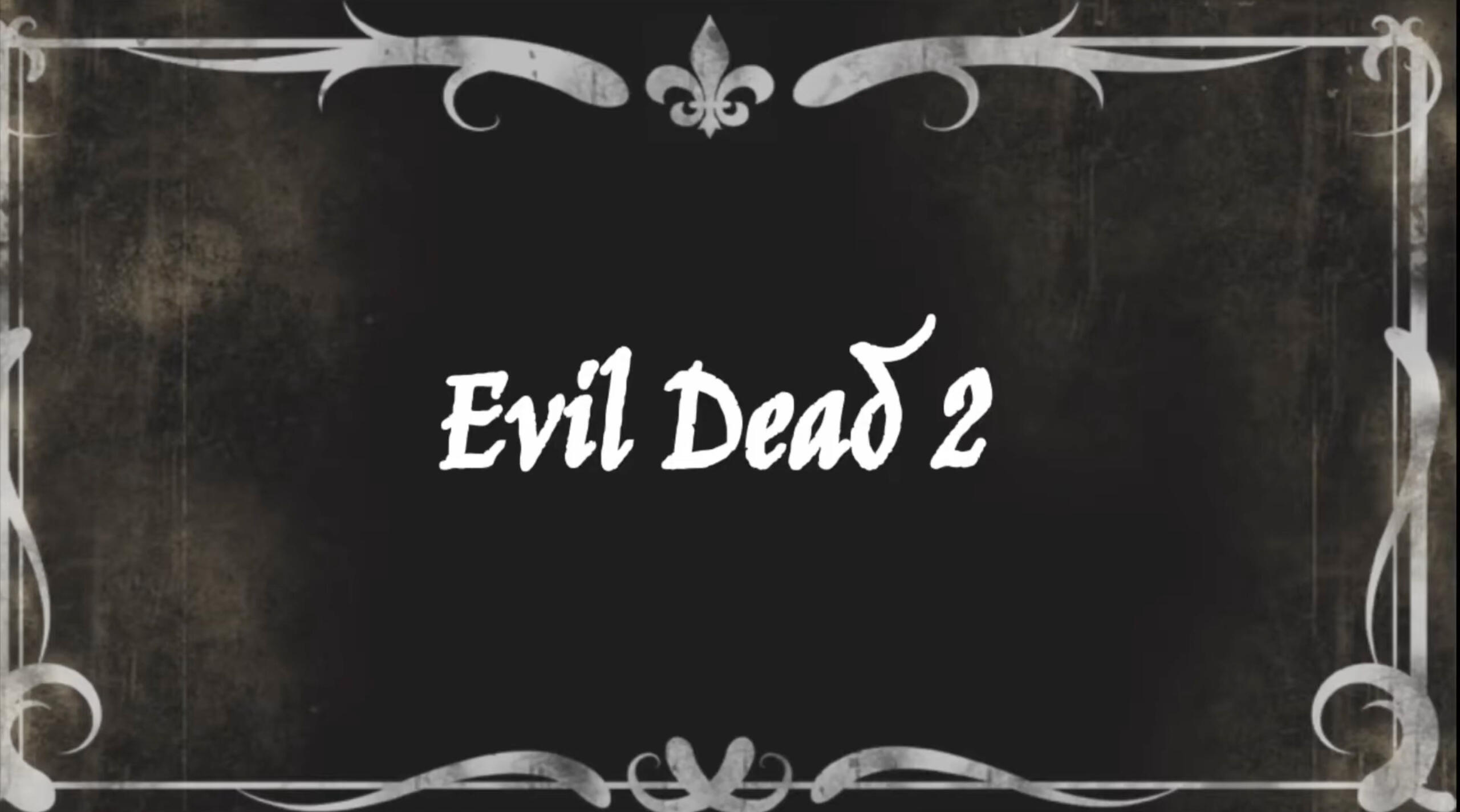

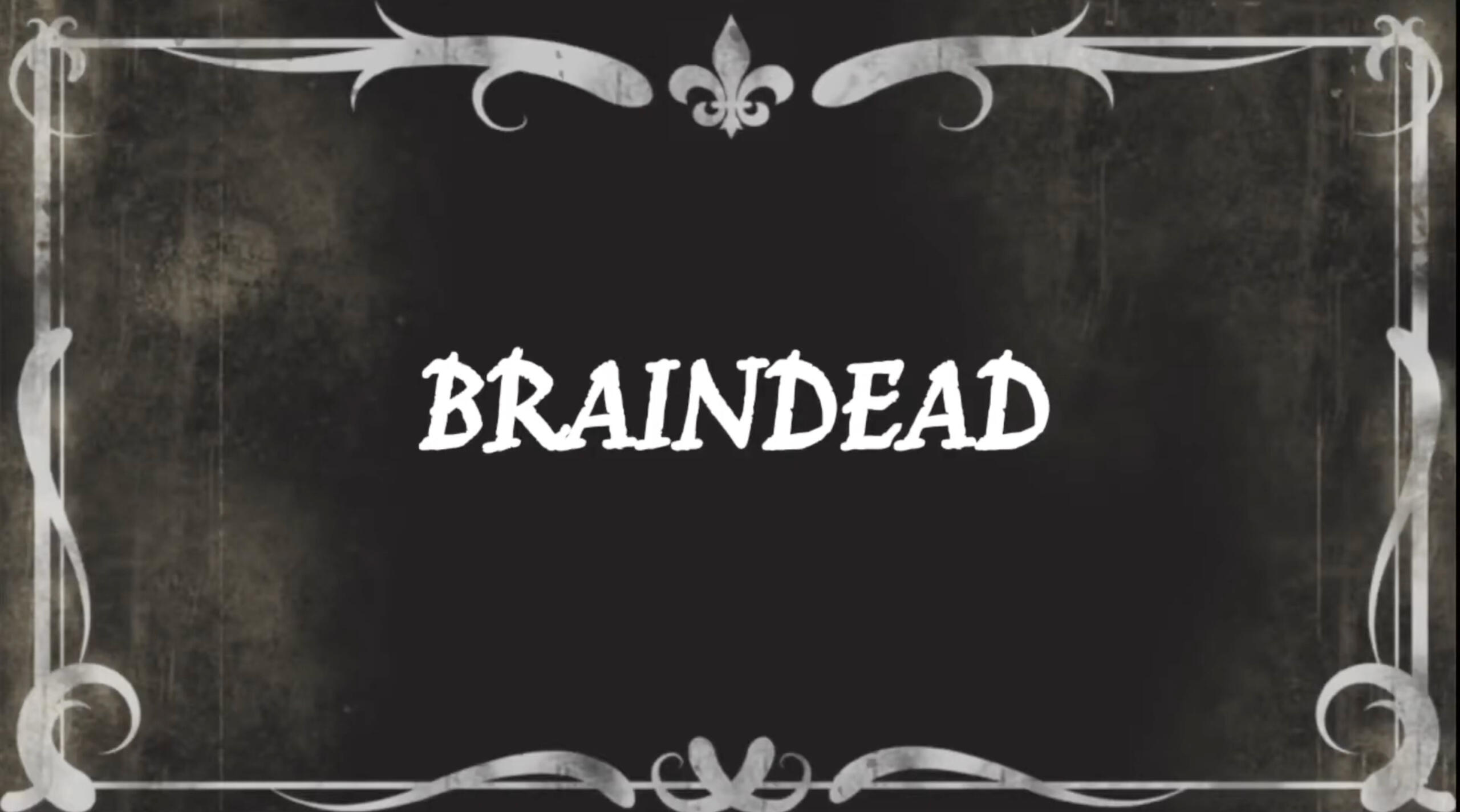

January 21st 2021
CALENDAR DAYS
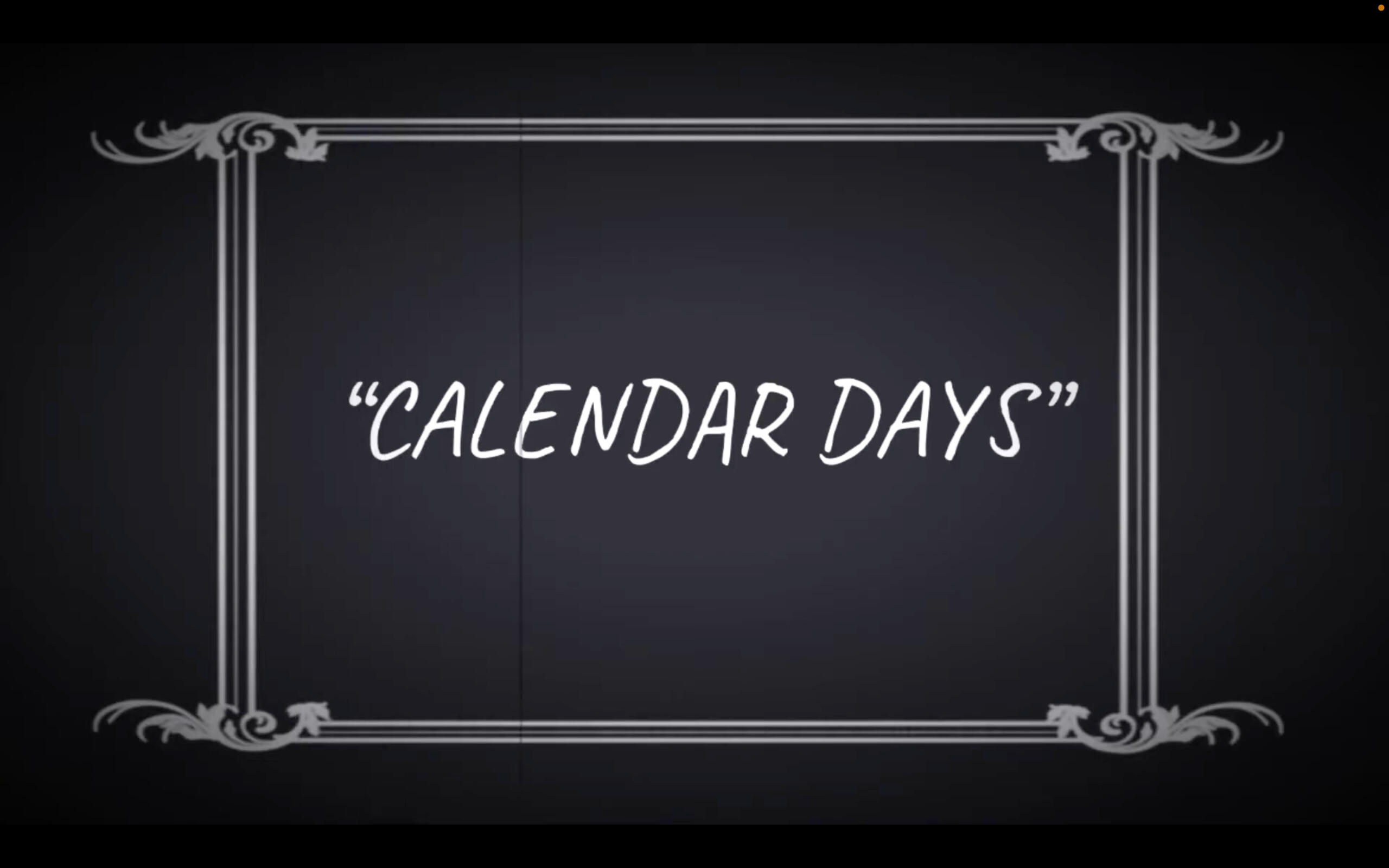
Continuing on my silent film obsession, I decided to make a film about lockdown in said style. The short was an entry into The Social Cinema's film competition. The theme for all entries was 'resolutions' which inspired me to make one about doing something new every day but ended as a statement about how films got me through 2020. Looking back it doesn't feature the finest editing but isn't bad for a 14 year old's first proper try - plus it won me £20 so who's complaining?Watch this here ~ https://youtu.be/zmI49BNIi80?si=InTM8k5iCJWvK6WK
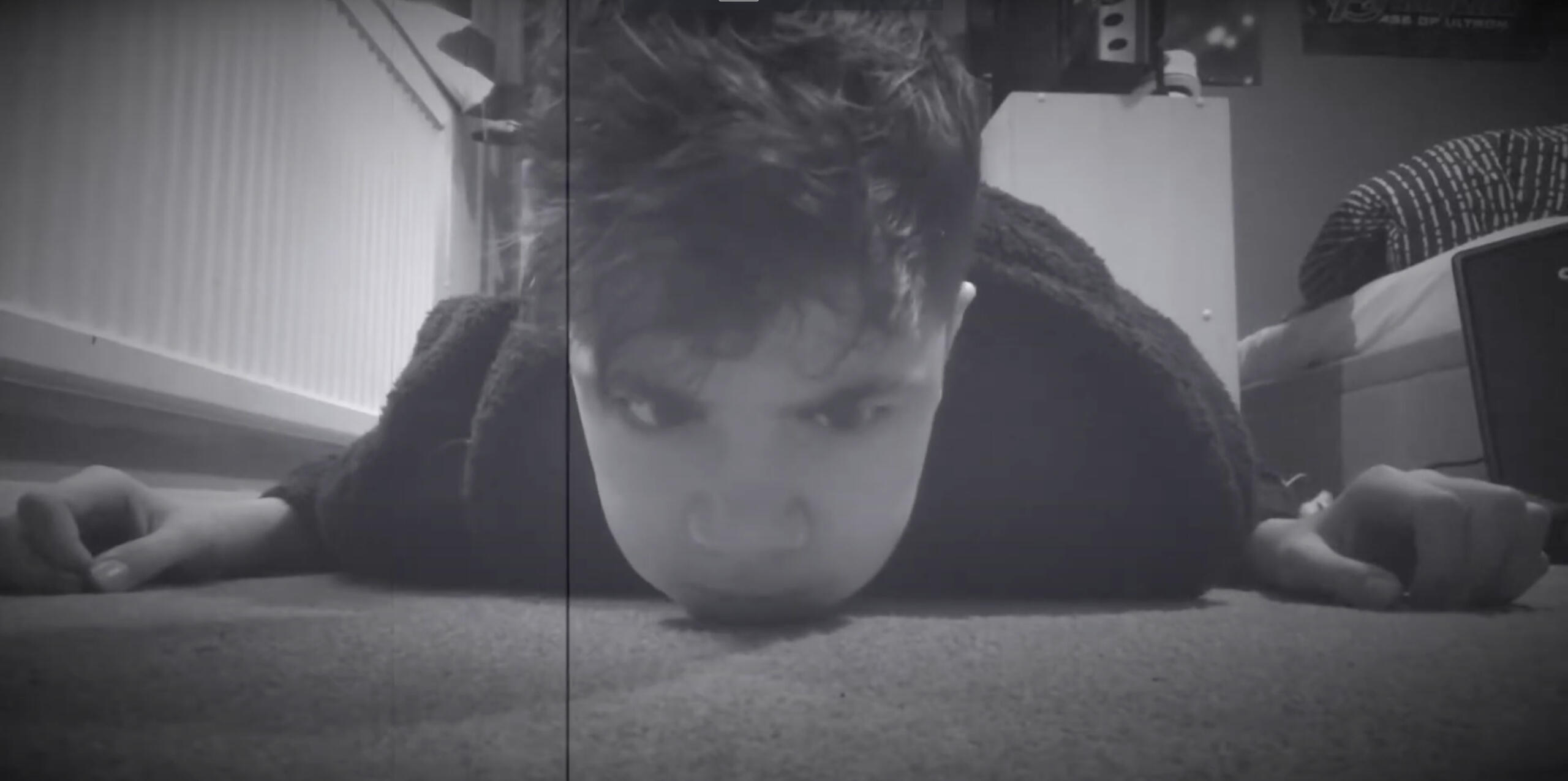

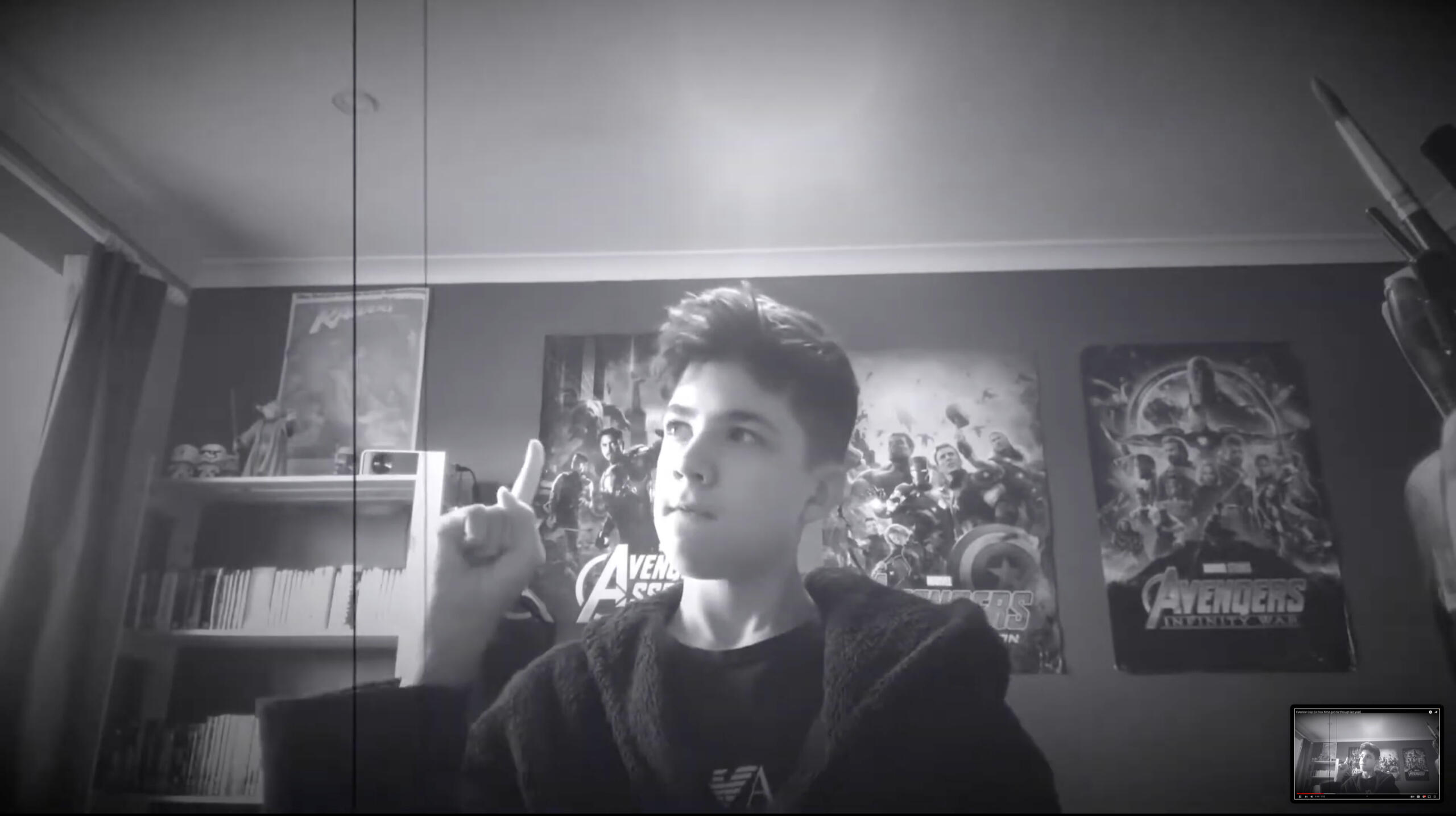
October 17th 2021
DEATH LOOP

Oh the infamous Death Loop, a film noone will ever let me live down. First of all: yes, blood does drip out of the gun and no, there is no explanation why. This project, which 15 year old me insisted would be a masterpiece, became clear to me as a failure half way through production. The two lead characters played by my reluctant friends I will forever thank for letting me drag them along, but it's safe to say their contribution was not quite as passionate as this flops well-meaning but overwhelmed director. AKA they hated every second and wanted anything but to shoot the film. Nevertheless what we now have I think was somewhat salvaged in the edit. This shows my first time turning away from iMovie and using Adobe Premiere Pro which I use to this day on countless YouTube videos and other films.
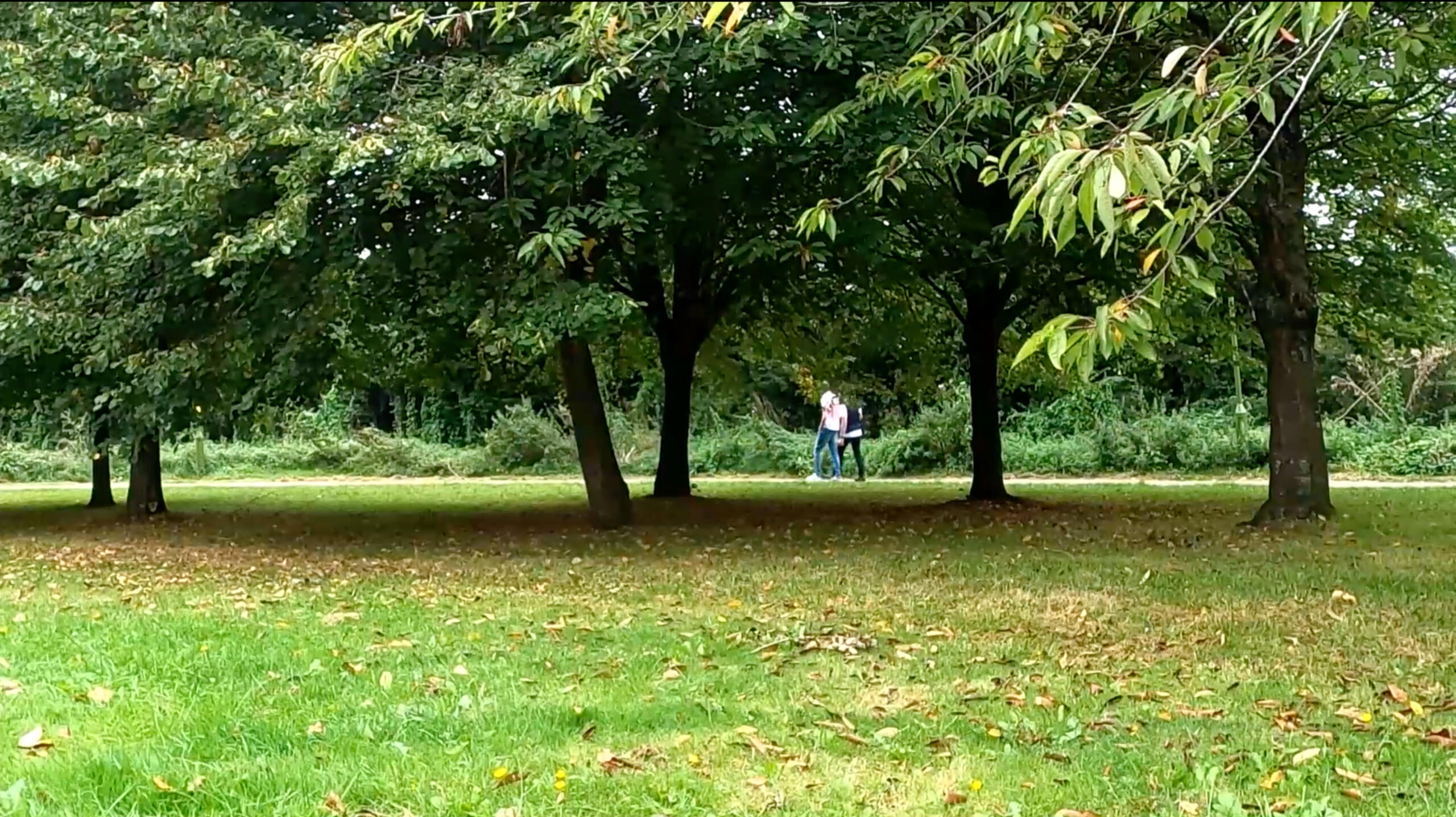
Shot, oddly, on a GoPro, the film attempts something... ambitious. It's about (as the opening titles say) "the vicious loop of drugs and violence" in which the narrative indulges in a genuine time loop. Our leading man 'Ken Krane' is seen at the start having just killed a man in the woods. Walking out traumatised, he is approached by another man who recognises the blood all over him and offers a place to clean up before somebody catches him in such a state. The man says he "knows this sort of stuff" hinting at his own life of crime. At his place he explains to Ken that he understands there is no sort of thrill like killing someone, but he can get him something that might match the exhilaration. He gives him the number of a drug dealer and sends him on the way. The deal is short but shady, made shadier by the fact that when he gets home he finds that the bag he was given is empty and he was ripped off. Furious, he returns to the mysterious man's house and beats him up in what remains one of the worst fight scenes in all of cinema. However, the man has the upper hand when he draws a gun on Ken and knocks him out. When he wakes (and this is where I can't even see my own logic) the man attempts to euthanize Ken with an injection (as you do). However, he makes big cock up and accidentally gets him high off of the drugs Ken thought he would get off the dealer, sending him on a trip that ends up in the woods - this is my first time fully writing a synopsis for this and I genuinely don't understand how I ever thought this would make sense; also in retrospect this could've made quite a funny comedy but no I made this with upmost seriousness. Anyway in the woods the man finds ken and threatens him with a gun. Ken intimidates the man accusing that he'd never really murder and he's "all mouth". The man drops the gun in fury. Ken then realises that the man's intention was to euthanise him so he picks up the gun and shoots him causing us to end up where we started: back in the loop.
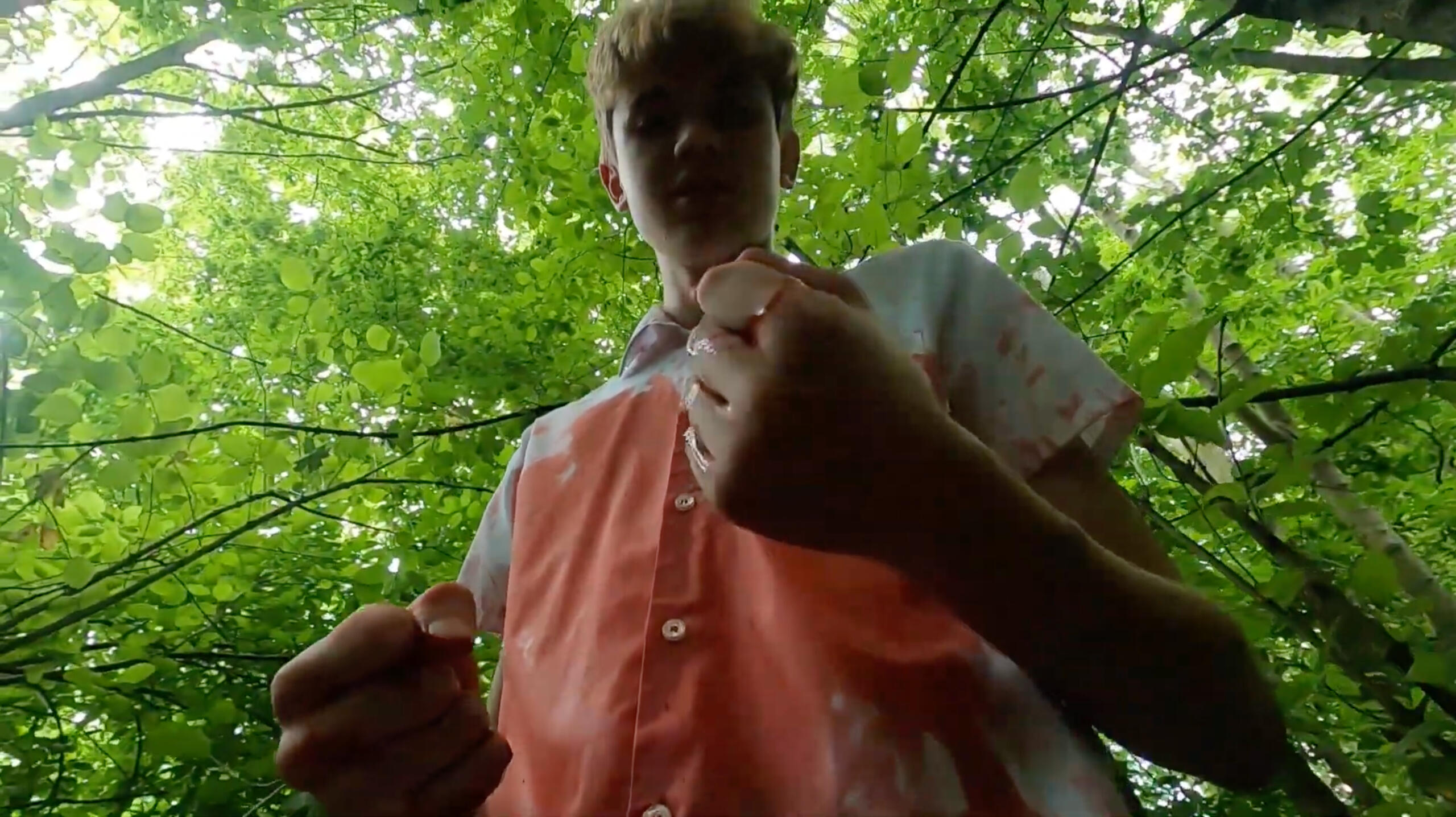
Although this film is a certified wreck, it taught me the most valuable lesson: things are not going to work out like in your head. Despite countless plot holes, the ambition of this project in more matured hands could've made a pretty decent short film, but for my first attempt with actors and shooting over multiple days in multiple locations, the plot was too overwhelming to be handled - but that's okay. Even Kubrick's first film was kinda shit. I so desperately at the time wanted a film to my name and so I finished it despite giving up all hope quick into shooting and committed to what was always going to be a failure. And now I have one extra film in my catalogue, that despite it's flaws and hellishly unprofessional production, I look back on with nothing but fondness.Watch it (if you want a laugh) here ~ https://youtu.be/Dkf5qEJ0g4w?si=yh_I8k4t3A63xcWB
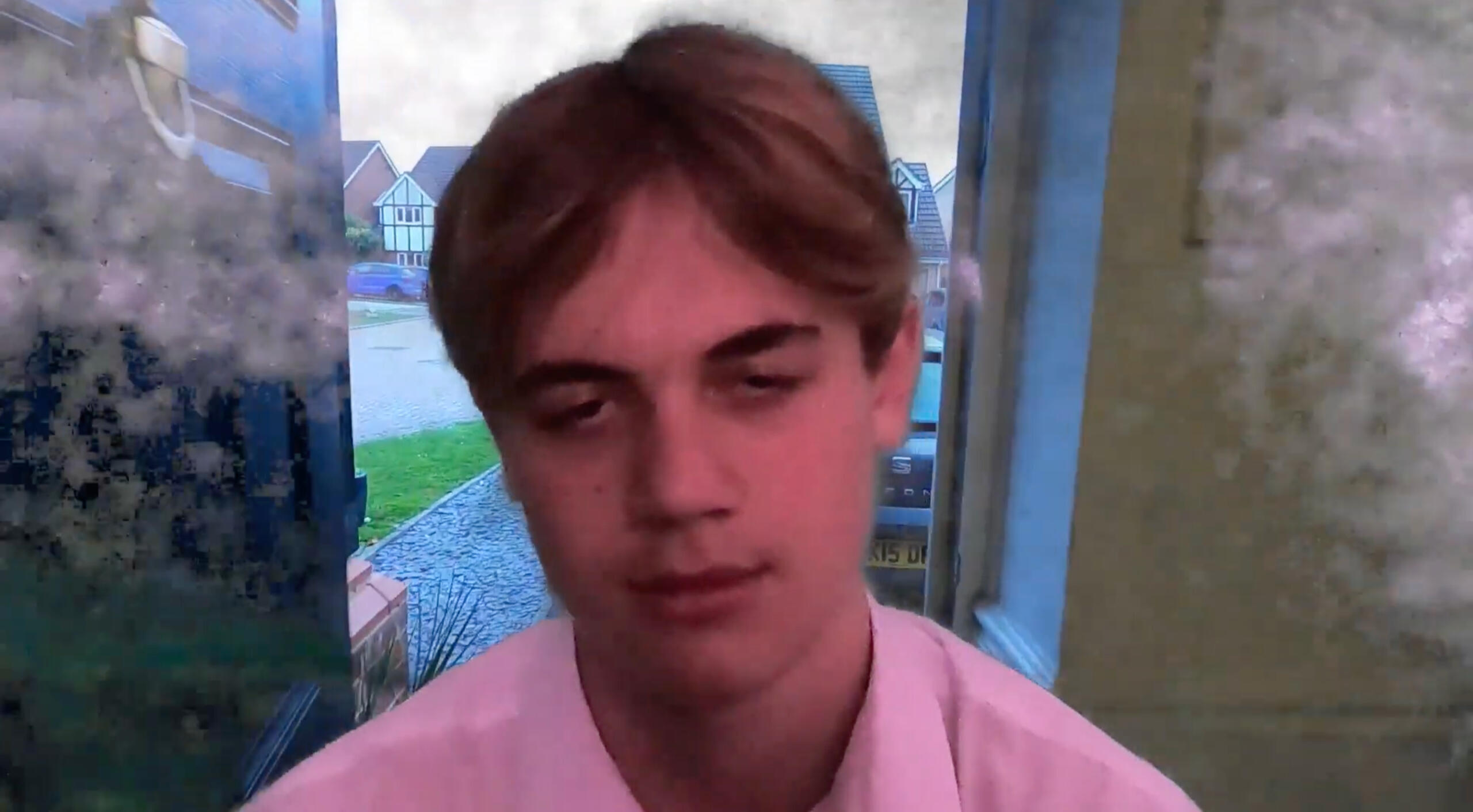
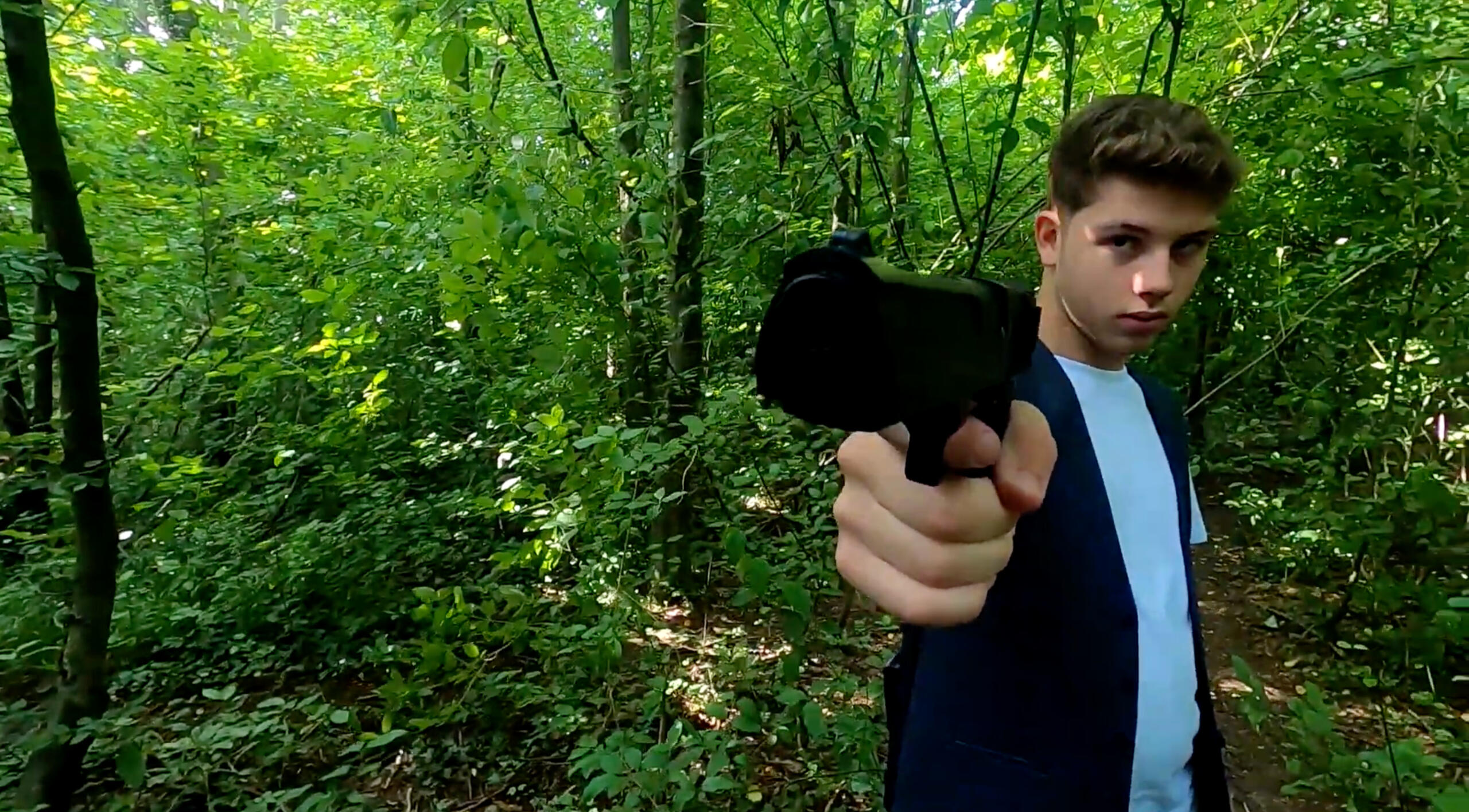

23rd of December 2021
THE GODFELINE
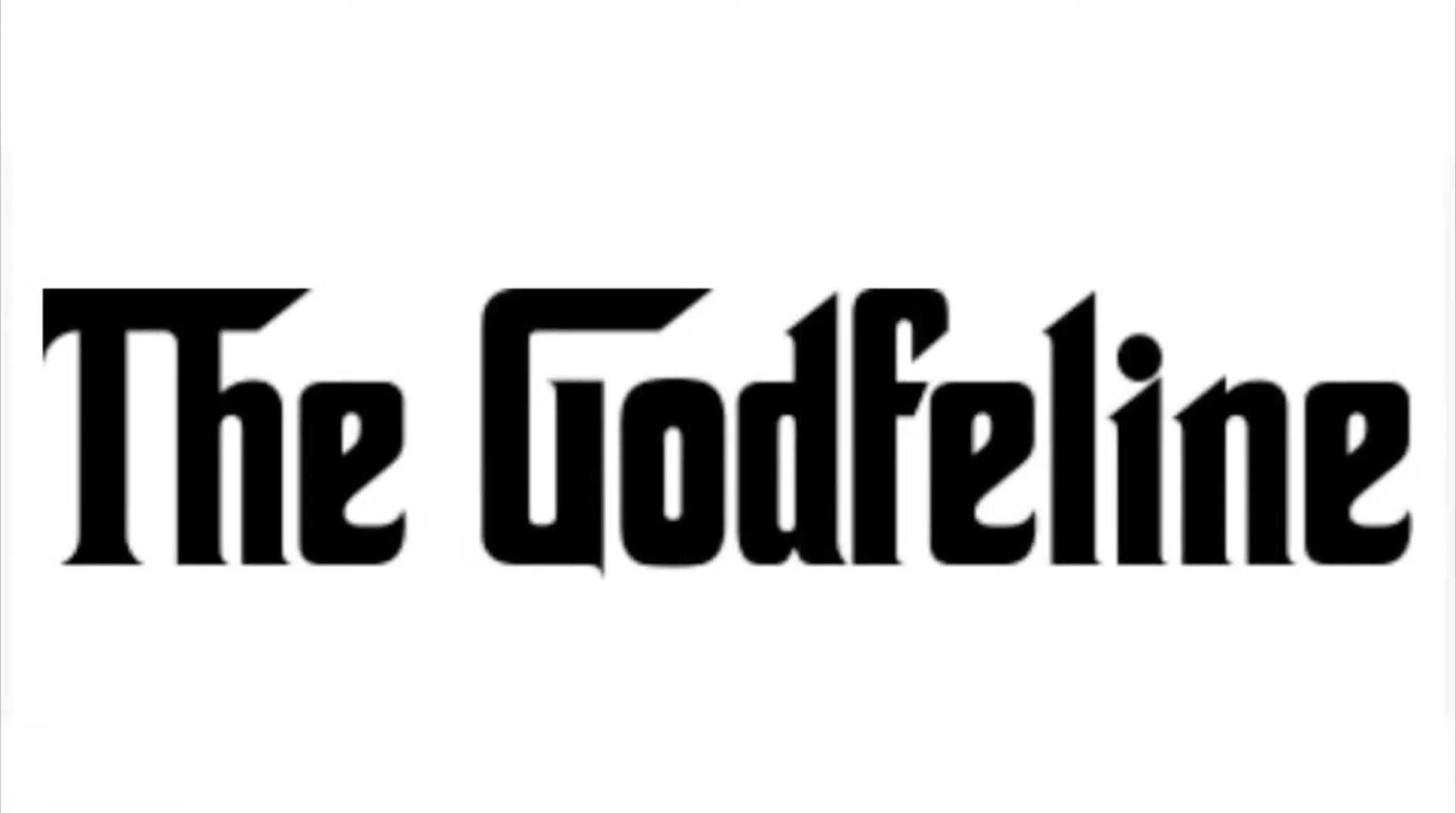
What started out as a little joke film for a christmas gift to my family ended up being a genuinely very enjoyable fan film that I have no shame including in my filmography.
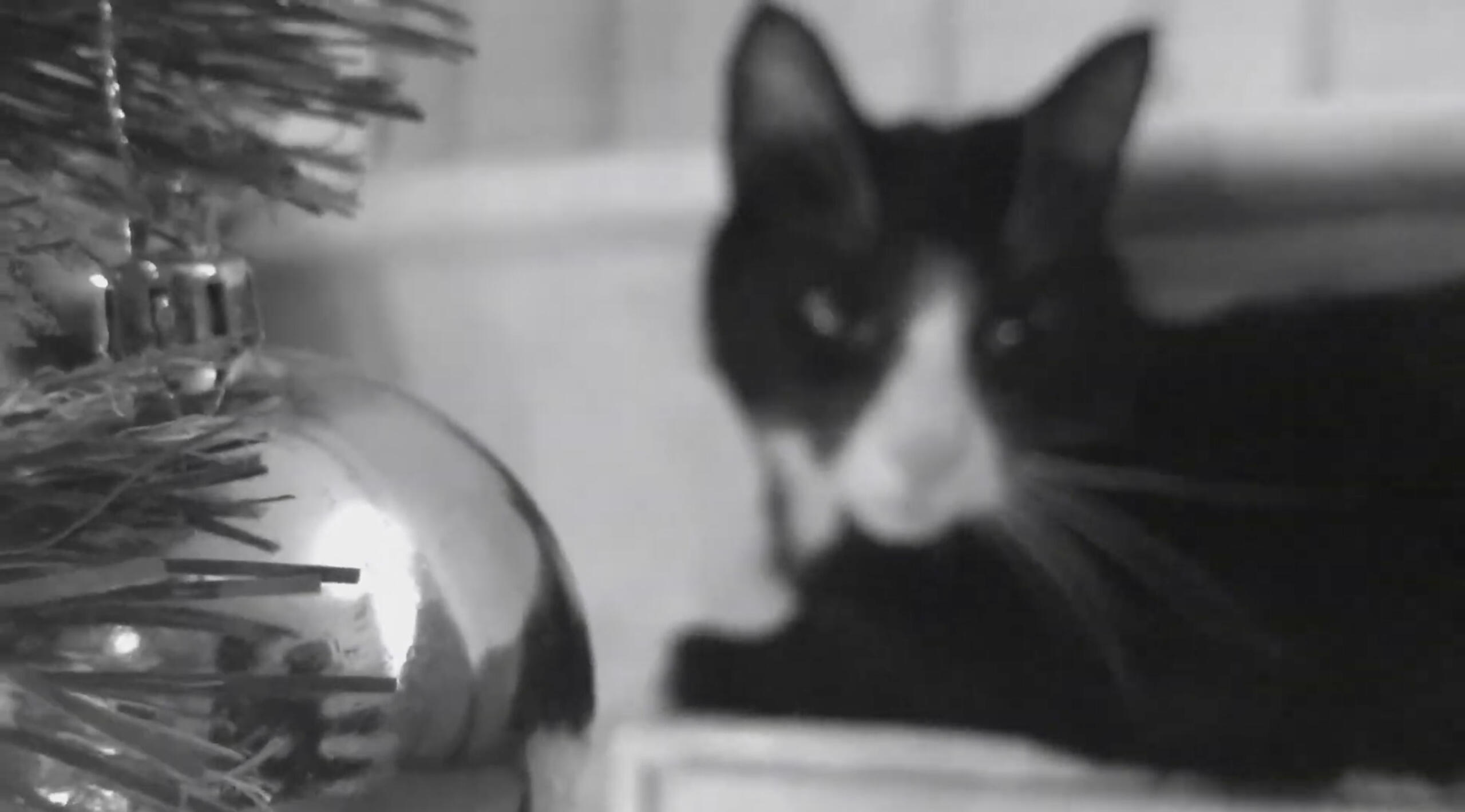
It features my three cats: Amber, who plays Don Babs Rowe the head of the family, Randall, who plays Randonio Corleone a dribbling mob wife and Chimmy, who plays Chiovanni Corleone an arse-licking hitman. A killer whale teddy bear (inexplicably named by my child self as General Grevious) approaches Don Babs Rowe with a request. He wants to "build some houses in the forest beyond the garden", but the infamous mobster 'Sonny the squirrel' is "disrupting business". He asks of Babs to "sort him out" to which she makes an offer he can't refuse. Later on that day she is seen hanging out with Chiovanni whilst staring out the window like usual. There she notices the squirrel and turns to the hitman, simply saying "get it done" to which he wanders across the fence, into the woods, and returns with one deceased squirrel in arms. At home, mob wife Randonio becomes suspicious of Chiovanni's ability to buy so many Dreamies lately to the hitman's deflection. Things are exacerbated when General Grevious enters the room crying "I didn't expect you to kill him! He was my friend and you killed him!". Chiovanni asks him to leave cutting to his henchmen throwing the poor whale out the window to his certain death. Ranonio further questions to the new Don Chiovannis iconic response "never ask me about my business" and with a closing door the film ends on a cold but powerful note.
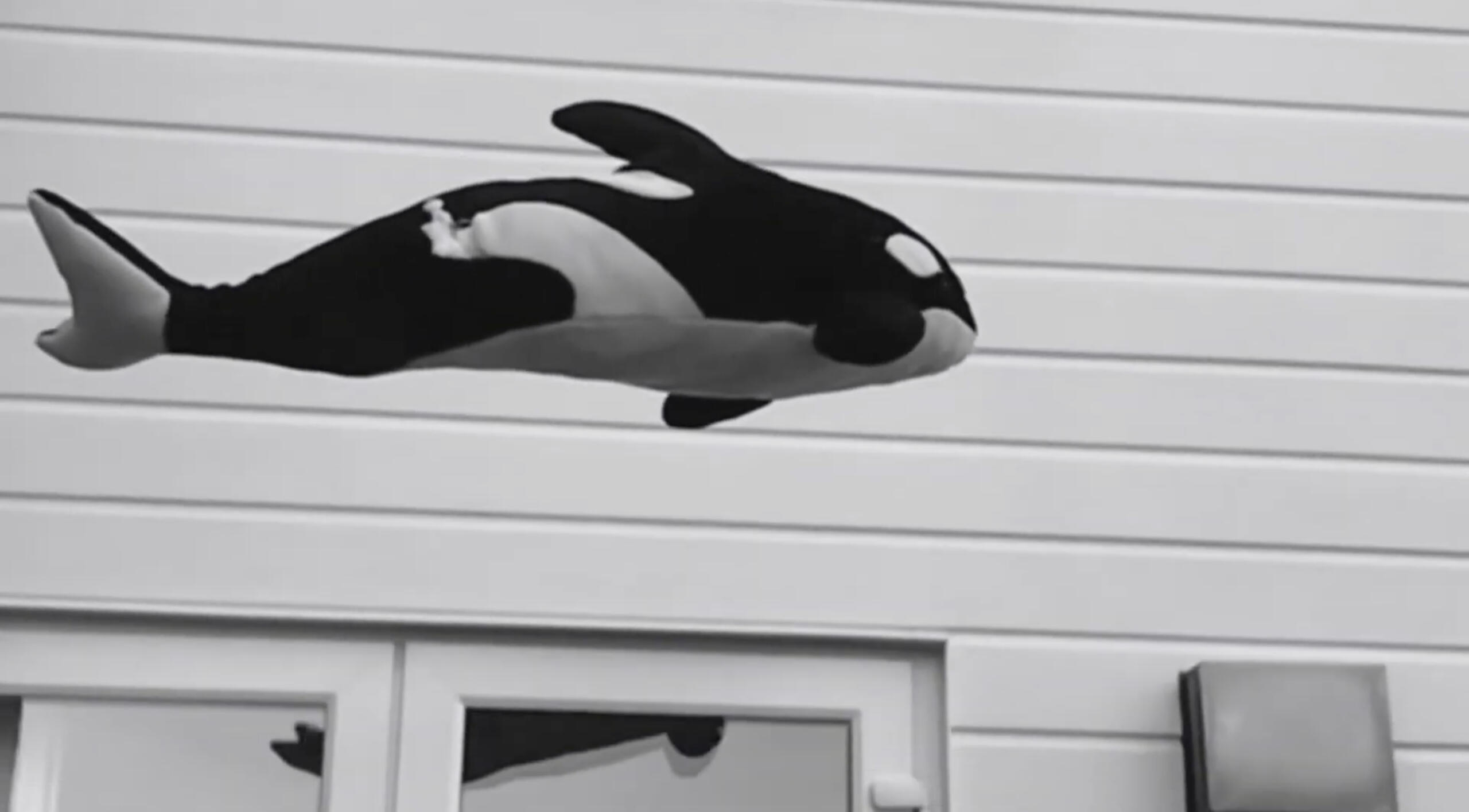
I guess I can now say I've worked with animals. Getting my very much untrained cats to act took a comination of digging up old footage that works (no I did not tell him to kill a squirrel just for the film) and waiting around for the right moment to come where my cat is standing in the correct position and hoping they'll stay there long enough for me to capture it. Sometimes I'd see them looking a certain way and film it, then finding a way to work it in. This was very much a film without a plan and even though it was just a bit of light fun and an inside joke between my family, it genuinely taught me some valuable lessons about the spontaneity and instinct of filmmaking.An offer you can't refuse ~ https://youtu.be/kajCnausdWk?si=10gLvt2AmL47Gjnw


May 3rd 2023
QUICKSAND

My second genuine attempt at short-filmmaking, Quicksand, is the first film I can really be happy with. Although there are things I'd change in hindsight, I still think it provides an entertaining watch. The film idea came to me after watching 1958's The Blob and missing a side of horror that just isn't there anymore. The simplicity of The Birds or The Incredible Shrinking man - these horror novel type science-fiction ideas that don't need any explanation. A film being about an extraterrestrial blob that just grows is so simple yet so great and so much fun to watch it conquer and be conquered by the film's protagonists. An idea even scarier, to me, is sand being the omnipresent enigma. The thing that get's everywhere being able to spread and grow anywhere is horrifying and all I really wanted to do here, almost as an exercise for myself, was to showcase that in as short a runtime as possible.

"A woman returns home from the beach" is all the exposition we're given to this short film. She finds a puddle of sand in the back of her shoe and empties it onto the floor. Whilst making popcorn ready for the film she's going to watch (extra points if you can tell what the film is) she hoovers up the sand and leaves the vacuum cleaner in the conservatory. Once the popcorn is done she walks back to sit and watch the film to find that a heap of sand has spewed from the hoover's nozzle. She brings the bin round and begins emptying the enigmatic sand into it, even utilizing the popcorn bowl. After putting the bin out (and throwing away the bowl) it cuts to night where she is watching the film and peering outside at the bin still weirded out by it's unexpected presence. The next day when she is getting ready for school she walks past the bin and decides to take a quick peek inside just to check she hadn't dreamt up the strange sand pile yesterday. When she opens the lid, however, she finds the bin has been fully overwhelmed with sand from top to bottom. Frustrated and confused, she rushes to put a sample of the sand into a Tupperware container and waits to see if anything happens whists he stares at it. To no avail she sticks the box in her bag and heads for school. However, later at school, the camera zooms in to reveal that the Tupperware box is now in fact filled with sand. When she returns home once again she ignores the bin and goes to unlock the door. It is then a small sandy raindrop falls on her shoulder. She brushes it off before realising that it came from the window above, and the whole house has been completely filled with sand since she left it last. Running away, the film ends with a close up shot of the glass cracking due to the pressure of the sand.

Though far from perfect, the film taught me many great lessons about filmmaking. I learned how to better motivate the cast on set and how to improvise and adapt to the many challenges faced - the funnest part being coming up with the trickery of how to execute some of the visuals. For example the bin overflowing was achieved tire-fully by wrapping the entrance to the bin in clingfilm and placing a surface of sand on top to create the illusion of an overflowing bin. It was here my trauma from Death Loop's crappy dialogue and delivery was amended as there is no dialogue whatsoever. Furthermore it has such a simple and easy premise that I knew I could pull it off and wasn't being too ambitious for my own good. I am currently writing a book of the same name that doesn't centre around one woman dealing with the sand but instead a whole family. It clocks in at about 320 pages and will soon be published, I would also love to make a film version of it but am of course at no financial state to bring that to fruition. Nevertheless this film, which was tough to describe the synopsis of due its minimalist plot, is definitely worth a watch.Watch it here ~ https://youtu.be/g5uJIKaoLjk?si=J3kbL-DKFrl5S8Sk



March 29th 2024
DUET

My latest film follows a composer who has hit a creative block whilst writing the score for an upcoming horror project "Duet". As he nears giving up he is struck by inspiration with a faint whistle coming from the dark. The film has a parallel narrative shot half outside at night and half inside in the morning. I thought it would be fun to shoot as it requires no dialogue and due to it's focus on music and atmosphere, would give me better practice at working on sound design. The edit of this was the toughest - faced with the deadline of completing this for my A level film studies submission I had to make quick decisions without ruining the quality of the film. The limitation of making it 5 minutes long I think worked in it's favour as the original seven odd minute idea would have definitely outstayed it's welcome and lost it's well-created atmosphere. Just like on my film prior it's here I found that limitations quite often do help as they force you to adapt and think creatively. Shooting in the cold and dark certainly presented plenty of challenges too but it has culminated in what I could easily call my best film yet - and it earned me full marks.Watch it here ~ https://youtu.be/Y29I2gTKVPs?feature=shared


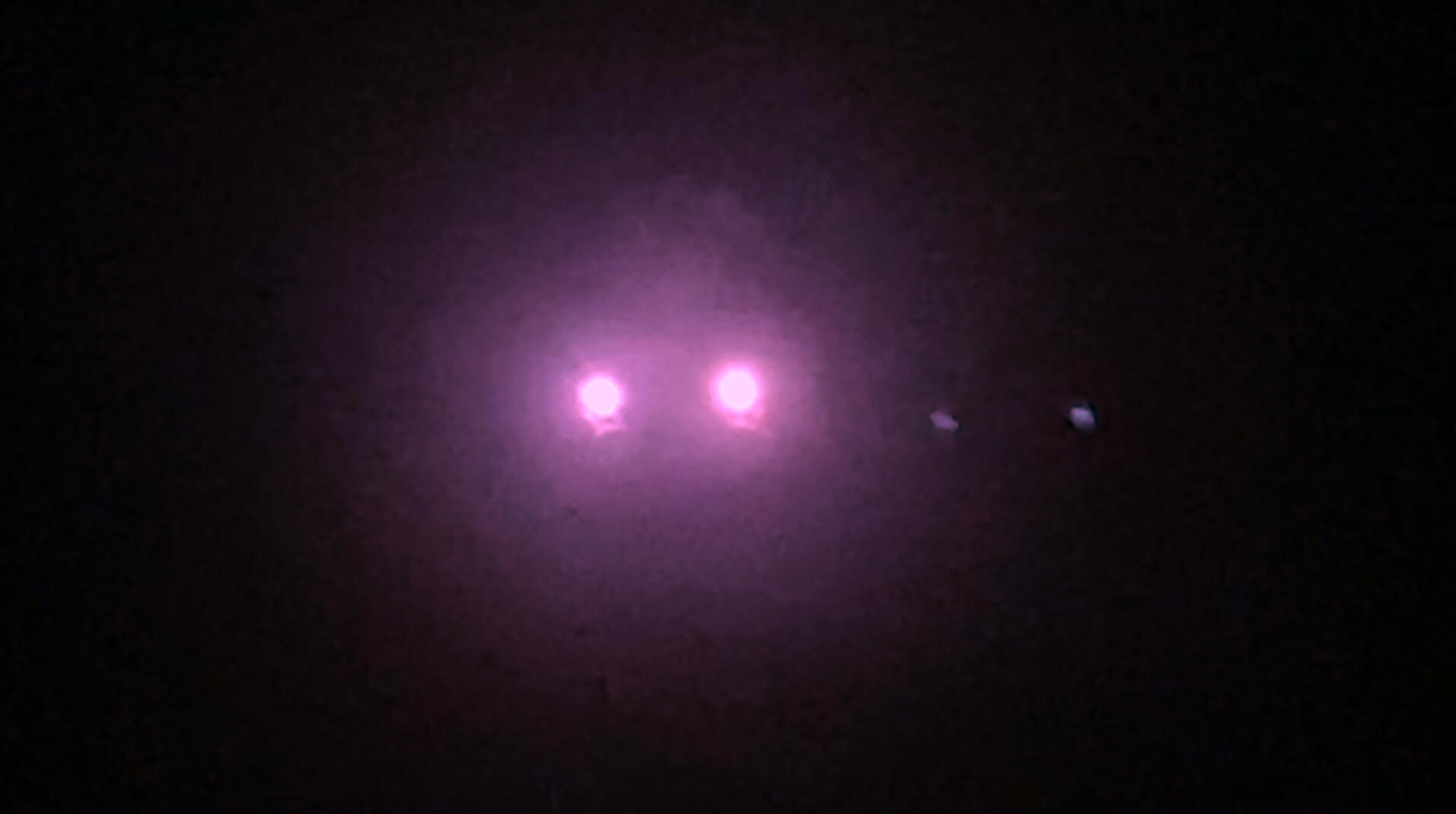

Thanks for reading!
5 March 2025
USE AT RISK

Use At Risk is a short comedy about an inter-dimensional microwave. It follows a man named Dave who, on his break, prepares his ready meal. When he reaches back inside to pierce the film he notices the meal is gone, and inside is a neverending void. Through the microwave, Dave's hand travels to alternate dimensions getting him in various comedic scenarios, building up to an unfortunate encounter with a nude chef.


This was my first experience working with a larger crew. Previously I depended on myself to fulfil many of not all roles of production as I made films on a small scale with amateur production. Here, however, I had a team of fellow students working with me and the experience helped me in many ways. First of all with my management skills as I kept every sticking to their respective roles on set; this I had experience with but not in a set environment and it required a more professional attitude from me as I couldn't allow the fun and laughs on set get the best of the workflow. I learned how to tell people what to do without upsetting them or insulting their capability. Furthermore it helped me realise the value of a crew. My assistant director especially was helpful in keeping me focused and on track, but best of all was the contributions from everybody when a certain shot felt hard to figure out. Although a shot list was figured out beforehand, there was still room for experimentation throughout developing some of my favourite shots of the film completely unplanned.
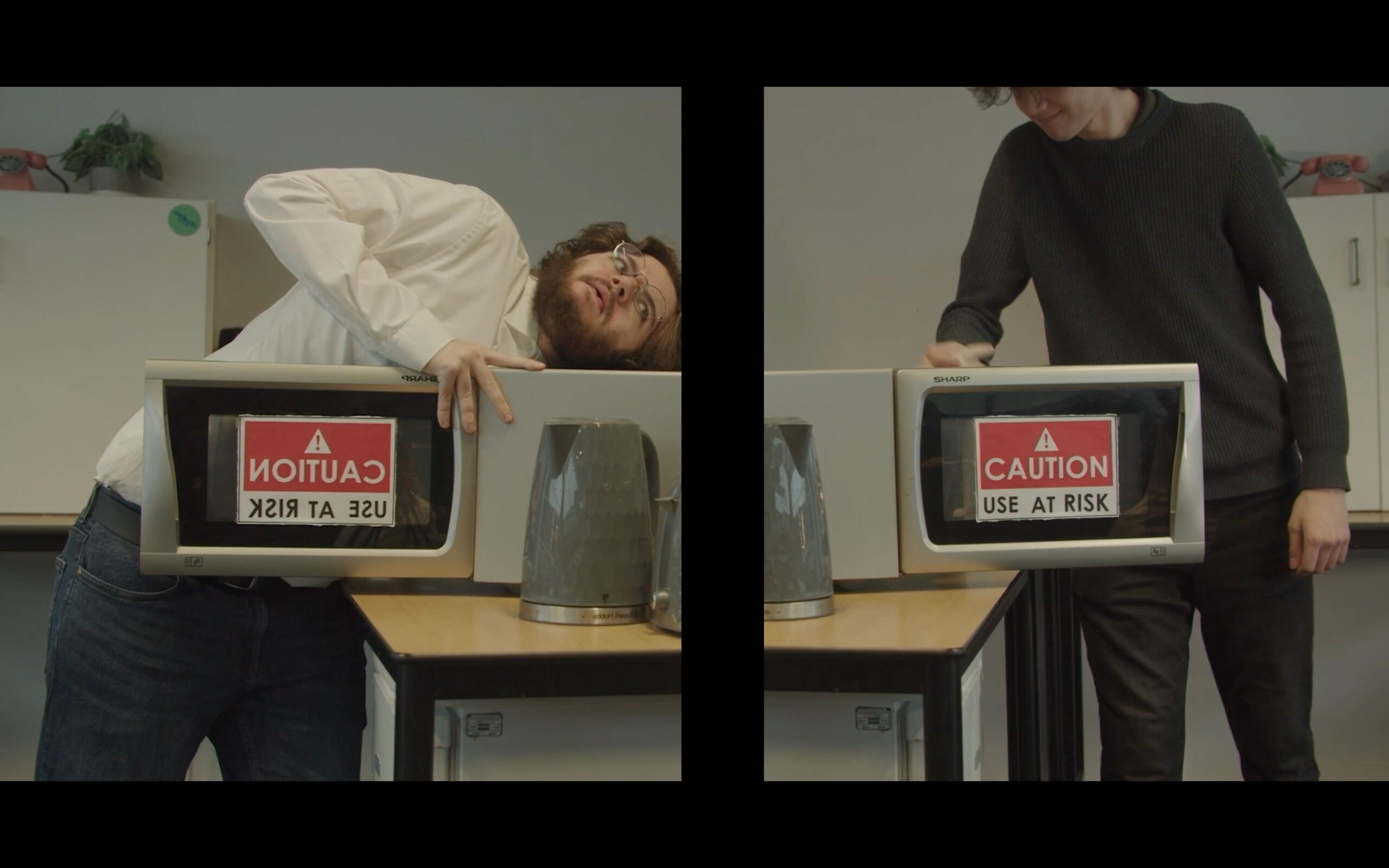
Post production involved the editing of the picture. This was done on Adobe Premiere Pro by our two editors Kavi Barker and Joshua Harris under our close supervision. This was a great learning curve as all films I'd made before had been edited by myself with the same software, so I definitely learned a lot about communicating with people the aspect of the film that love doing the most. Editing is everything when it comes to the storytelling of the film as it dictates the pace and structure, so I ws quite specific as to what I was looking for; I wanted the film to be fast moving with the majority of it edited as a montage, however my editors had lots of other ideas as to how else it could go down. Initially skeptical, I found that the more open minded I was the more the film would benefit from second and third opinions, and while I didn't always agree, it was also a lesson in learning how to reject ideas while making everyone feel valued and not dismissed.

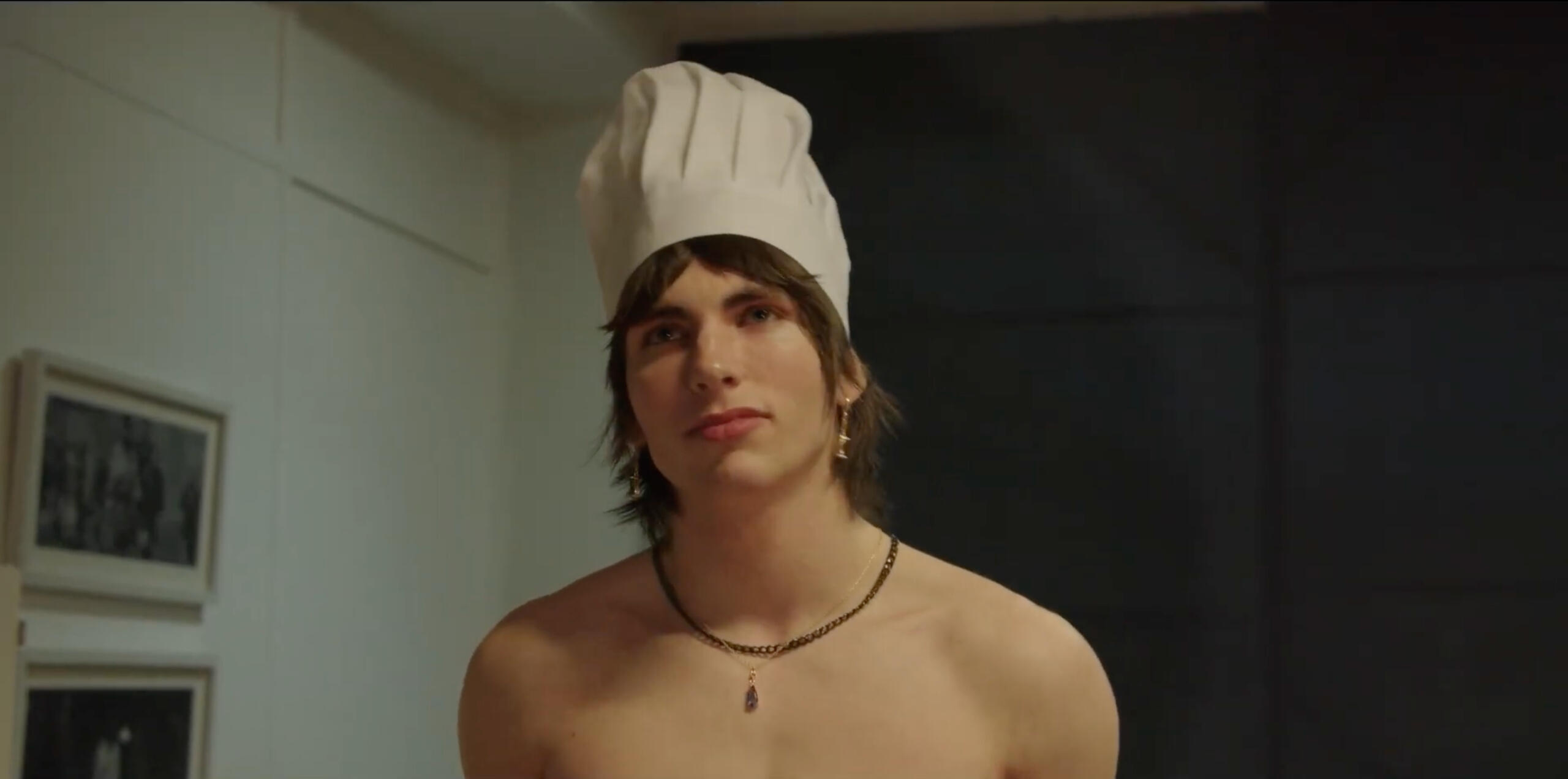
Watch it here ~ https://youtu.be/ZjGxYfjwxEM?si=dwiVY-efis_n2qt5
17 April 2025
PAPER HEARTS

While watching a film on night I gazed at my tissue box and had an idea. Born out of my frustration with not making movies, and furthermore boredom of an attitude I'd developed that every film had to surpass the next, I went back to basics and made this in two hours later that evening. It's about the love affair between a tissue box and toilet roll, forced to live in two different room but destined to be together.

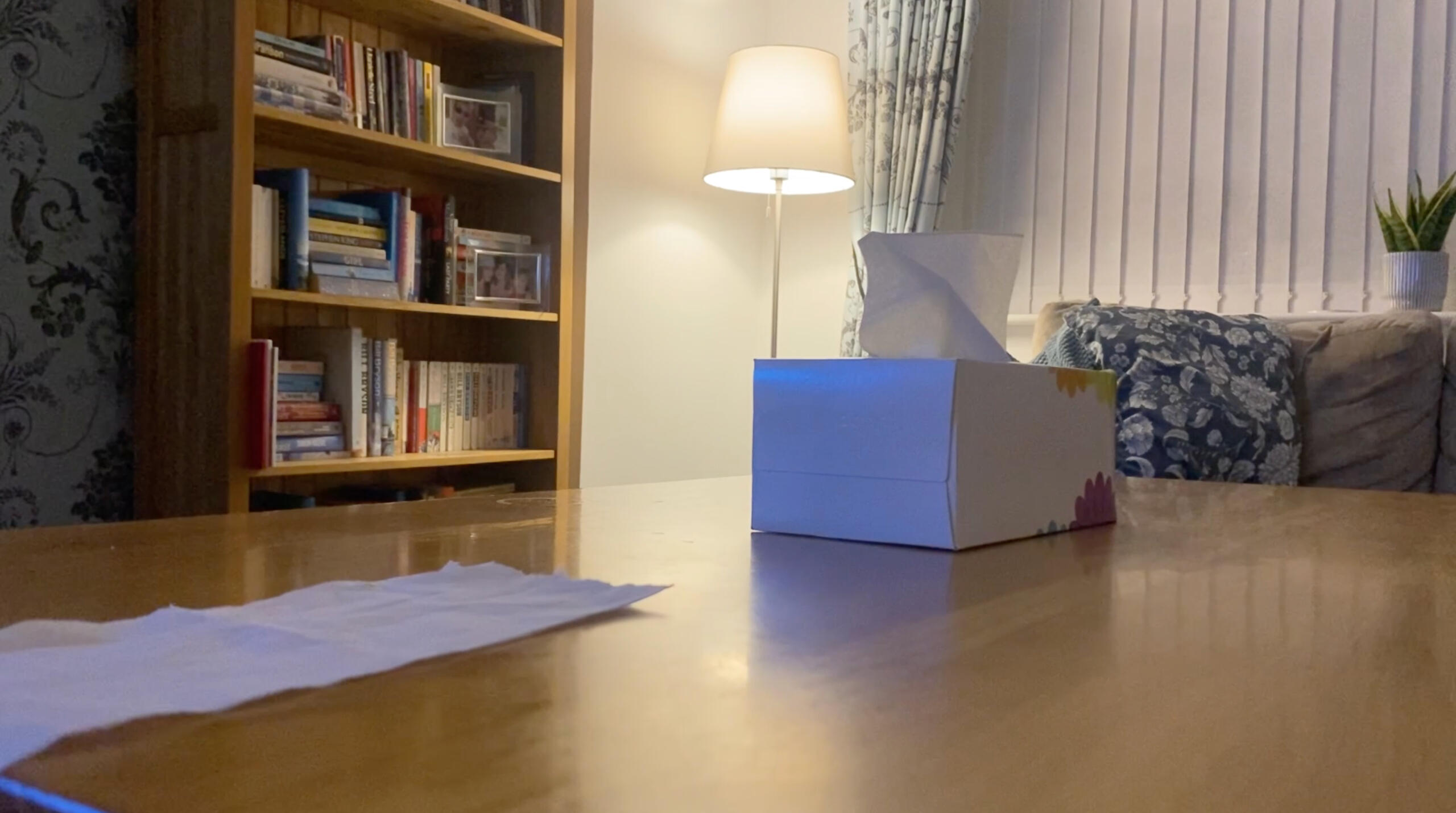
The film was made in the same sort of fashion I would make my small home movies on iMovie as a teenager, but the difference here is my experience. It was me making it up as I went from a rough idea but I now knew how to approach the project much better than before in my filmmaking early infancy. I knew what I was capable of doing in post-production and what I could do on set to aid it. I knew to get more footage than I'd know what to do with so I have plenty of option. Furthermore, I knew better how to make the story make sense to an audience and not just myself with my pre-conceptions. Making it was two hours of fun and a strange urgency to finish something so stupid as if my life depended on it, an editing it was even funner as I watched the short and sweet comedy come together. It turned out alright anyway.

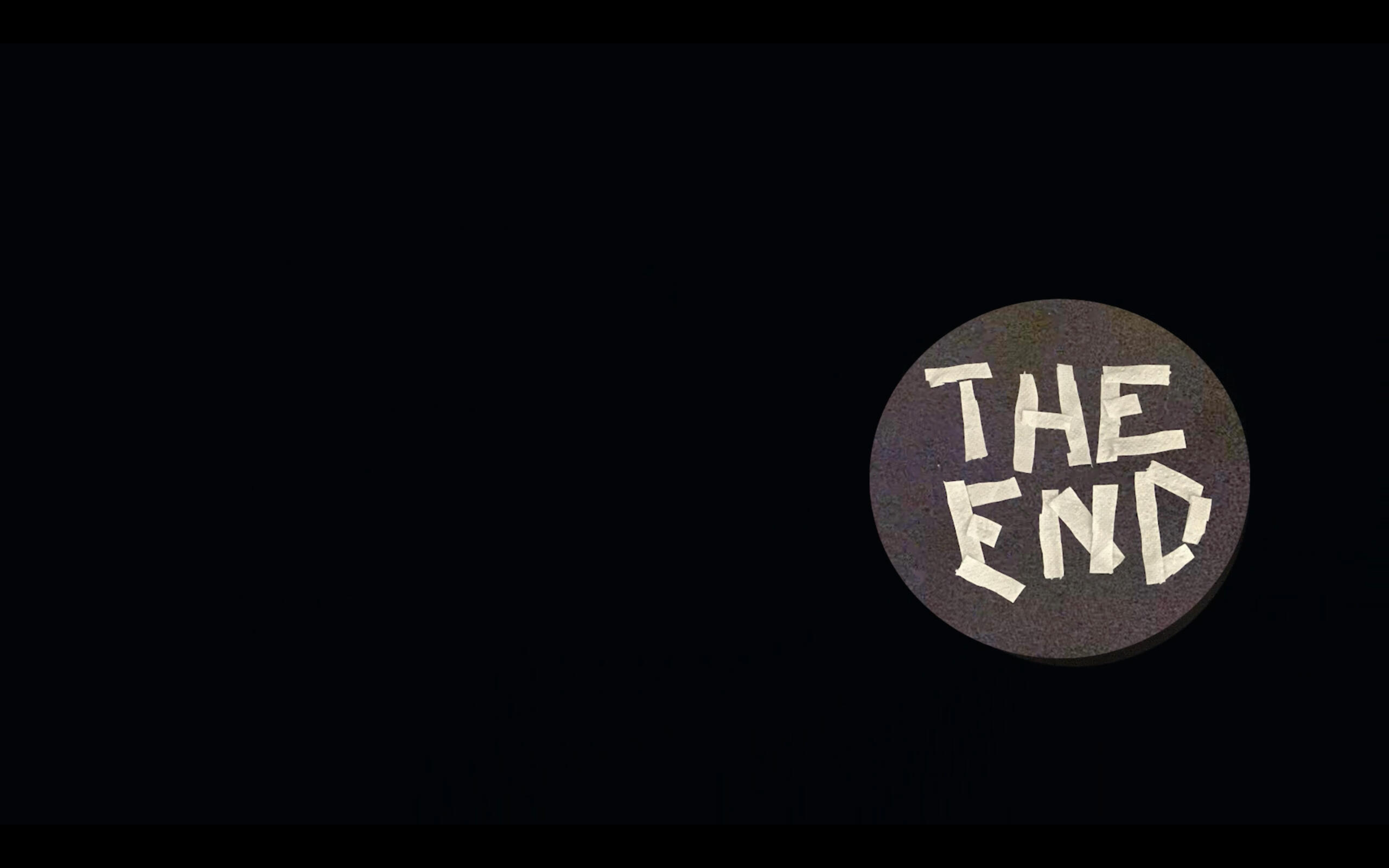
Watch it here (and don't forget to wipe) ~ https://youtu.be/HzNPJmYYo?si=t_ajOXXC9jvWXv2l
100 YEAR OLD MINI SERIES

“Eat some cocaine, you limp-dick!”As intimidating as the details of this film may seem - German, Expressionist, over 100 years old, silent and most importantly 4.5 HOURS - this is actually a surprisingly breezy watch. I expected a worthy drama that might take a bit of extra brain power to get through, but with its 12 act structure (split across two well divided parts) it watched a lot like a mini series by todays standards of viewing. I was almost always entertained which is impressive not least because of its runtime, but also given that so so much cinema was yet to be invented and this was Fritz Lang creating a genuinely very gripping, pretty well paced and structured movie with about 0.1% of the cinema to be inspired by compared to filmmakers today. I mean with early films like this I always feel like they’re kind of making it up as they go along coz so little of the ground work of what is now movie making has been laid; and for it to turn out this timeless is never something to overlook.By the end of the first part I wasn’t fully sold. I was entertained, but bar the card game with Weck which was an excellent scene, there wasn’t too much to enamoured by - plus I found it confusing who was who and admittedly had to look up a bit of what was going on coz I was often confused who Weck was and who Dr Mabuse was pretending to be. However as I stepped away from the film and got on with my day, it was constantly at the back of my brain. I simply had to know what happened next, like a book you can’t put down. In my cynicism which had been created by many post-intermission let-downs with great epics, I half expected it to have peaked and the second half wouldn’t go past the entertaining and fun but also quite slow and lacklustre first half.Boy was I wrong.It picked up after a… dramatic? Sure. But not quite dramatic enough end and just doubled down on anything the first half did well. Twice as engaging, twice as much action, and most importantly the central dynamic of criminal and investigator came right into the centre which was by far the most it had going for it. You can see the early blue prints of Catch Me If You Can, Heat or basically any cat and mouse film in this gem. Although the Scorsese film did it considerably better (bit of an unfair advantage though), the moment Weck meets Dr. Mabuse around the third hour of this epic made me feel a similar kind of tension to the phone call between Leo and Matt Damon’s characters in The Departed. The last two acts are really where the action lies in this movie, however the more mundane rest of the film acts as such a great boiling pot of inter connected story lines and understanding of Mabuse’s wicked character, that it makes the large moments even larger. Which brings me to my next praise of this master class.SPOILER WARNINGThis is an expressionist film, however the artistic moment isn’t embedded in the whole films aesthetic like other avant guarde classics (The Cabinet of Dr. Caligari, Nosferatu or Lang’s own Metropolis). Instead such inclusions of the style are used with meaning. It’s shown in sprinkles with Mabuses hypnotic powers, however where the film really gets freaky is in the criminal master mind’s come-upense. The last scene of the film is something that will never leave my brain. The whole fabric of the films reality falls in on itself as the place transforms into this artistic nightmare all with the purpose of haunting the evil antagonist. It’s the first of the few expressionist films I’ve seen that have saved the style for a specific purpose instead of it being the whole environment of the film (not that anything is wrong with that), and I was shocked by how effective it was on me 103 years after it was made. Aside from that the scenes of hypnosis that show Lang’s eye for the avant guarde almost like a portfolio were also fantastic.If I went more into the plot there’s plenty more to talk about in high praise, like how I loved everything with Mr Told, but overall this film really took me by surprise with a) how easy it was to get through and b) how much I’d end up shouting at the screen in anticipation. I thought it might be one I’d look at and kind of go “um ah yes very clever” as if I was smoking a pipe and critiquing an art gallery, but instead the core film lover in me was reacting to it like it was a soap opera, and that’s a powerful thing. Don’t skip out on this movie, it’s great.24 September 2025





































